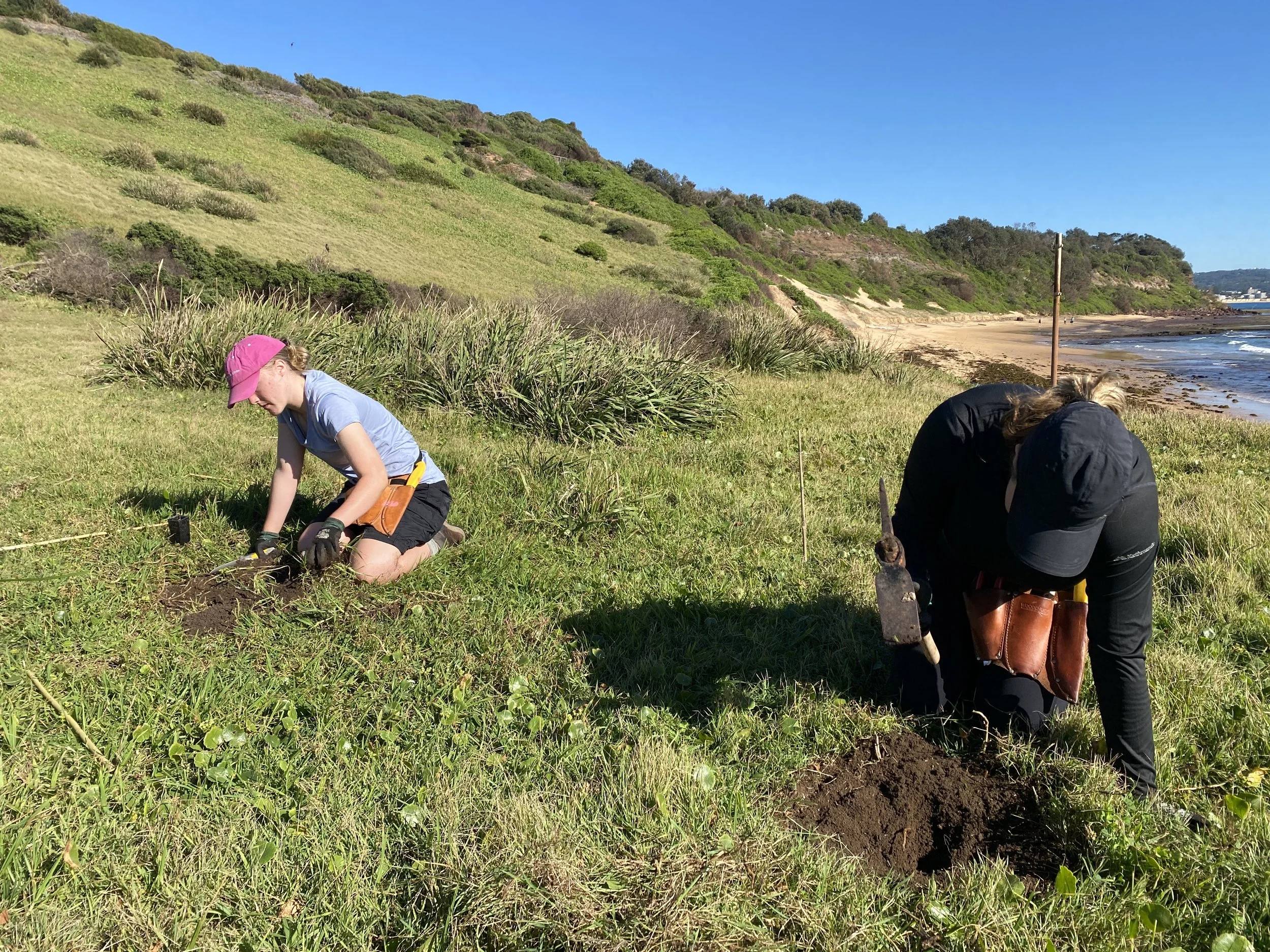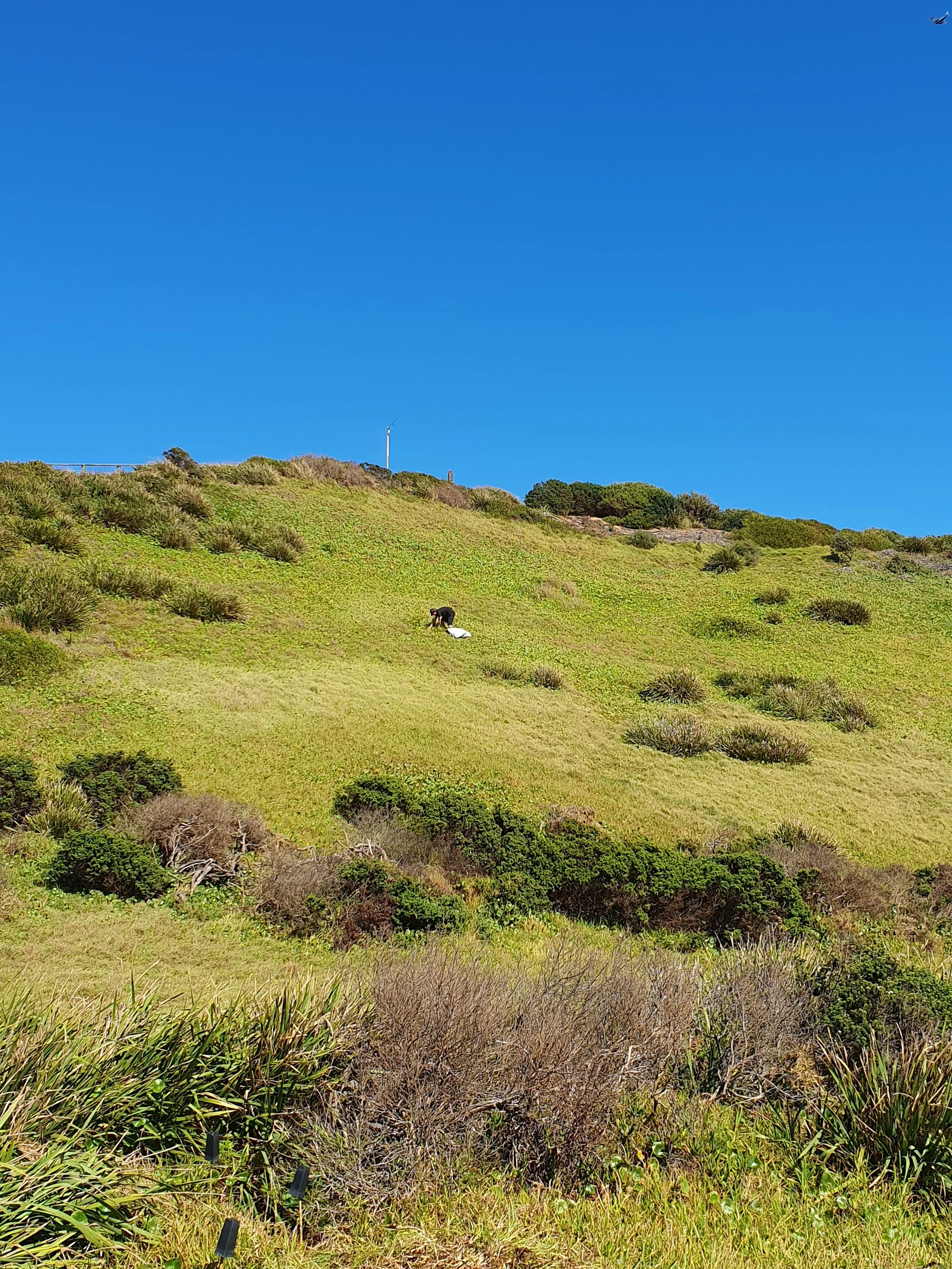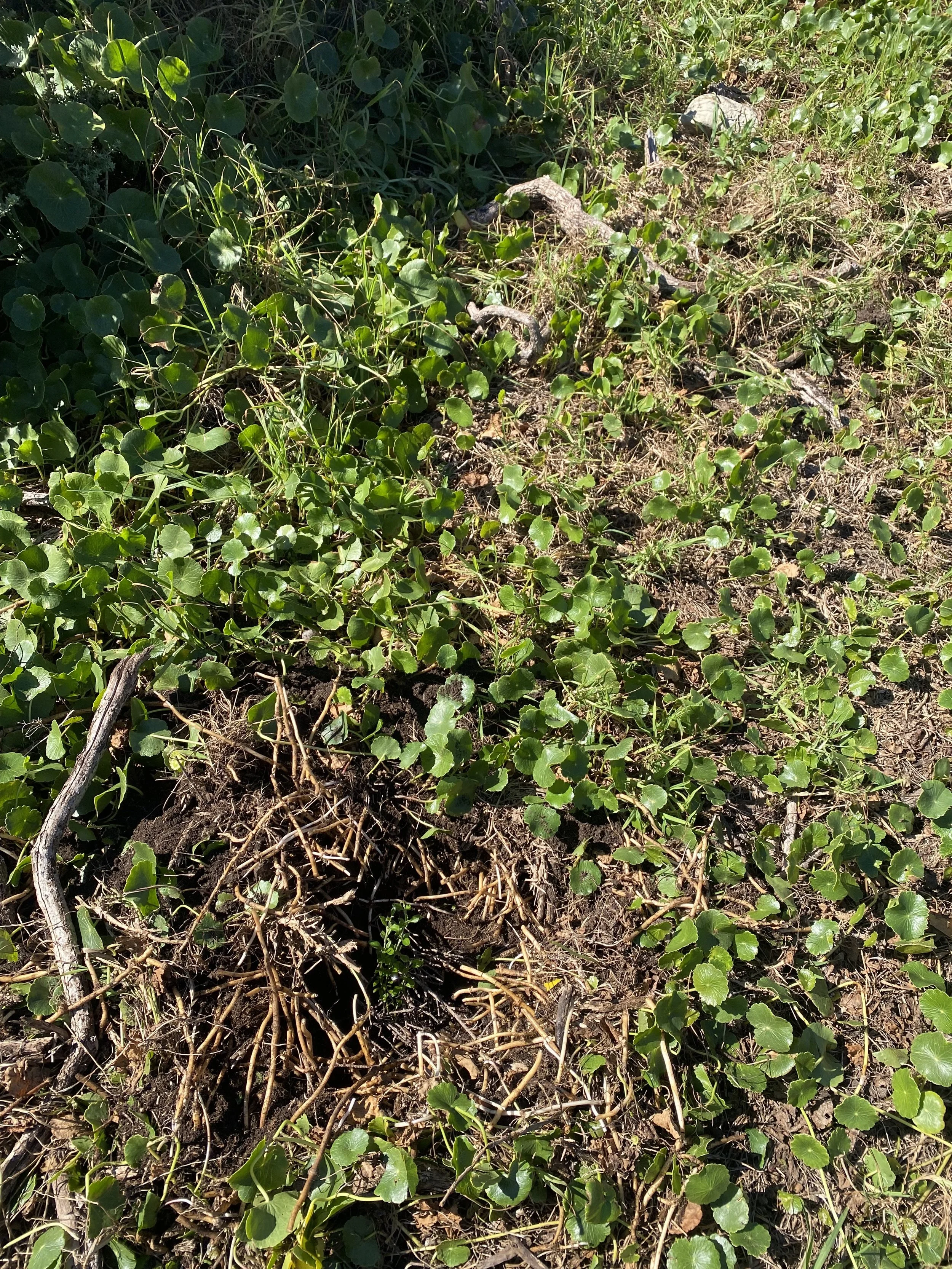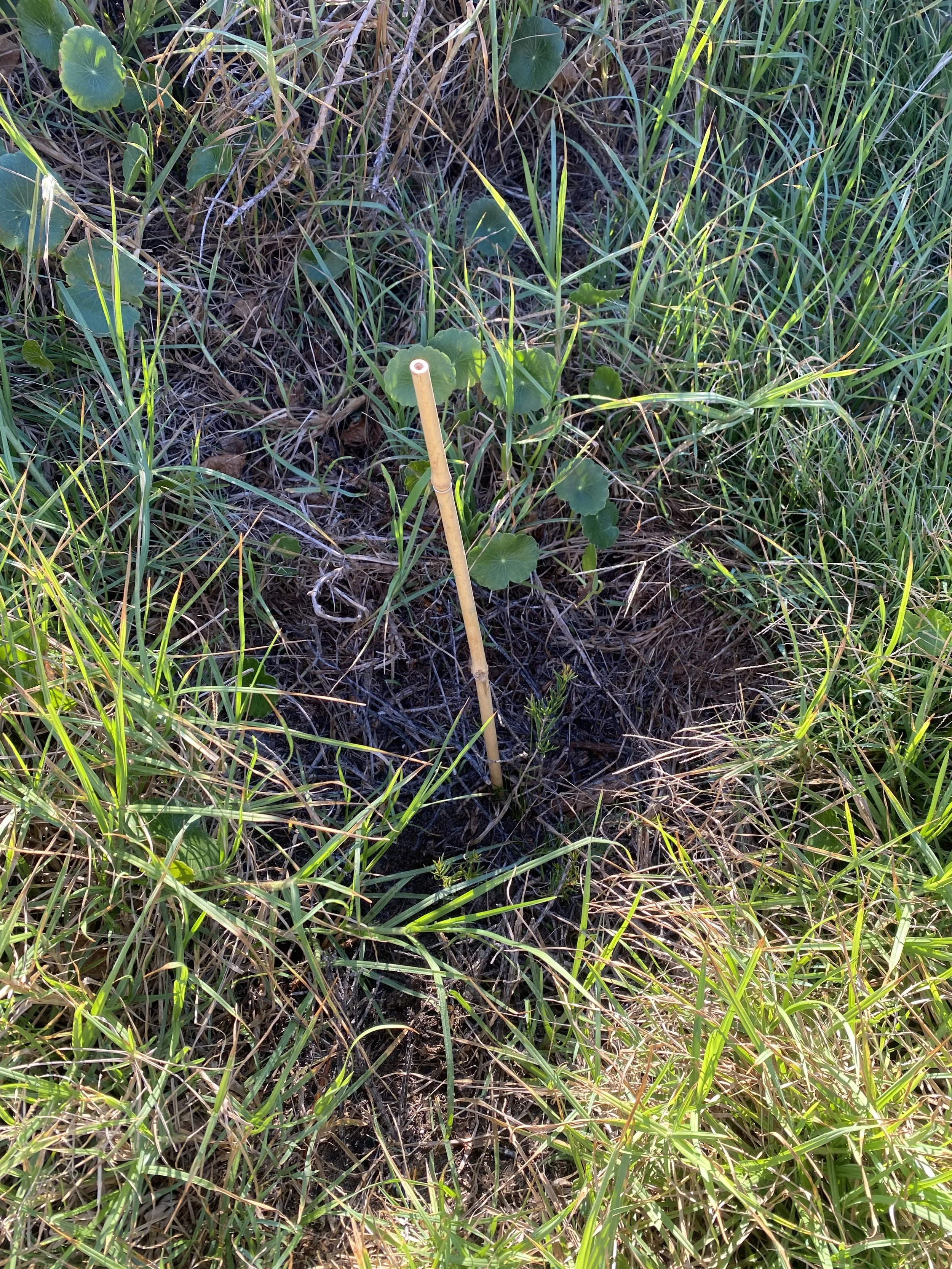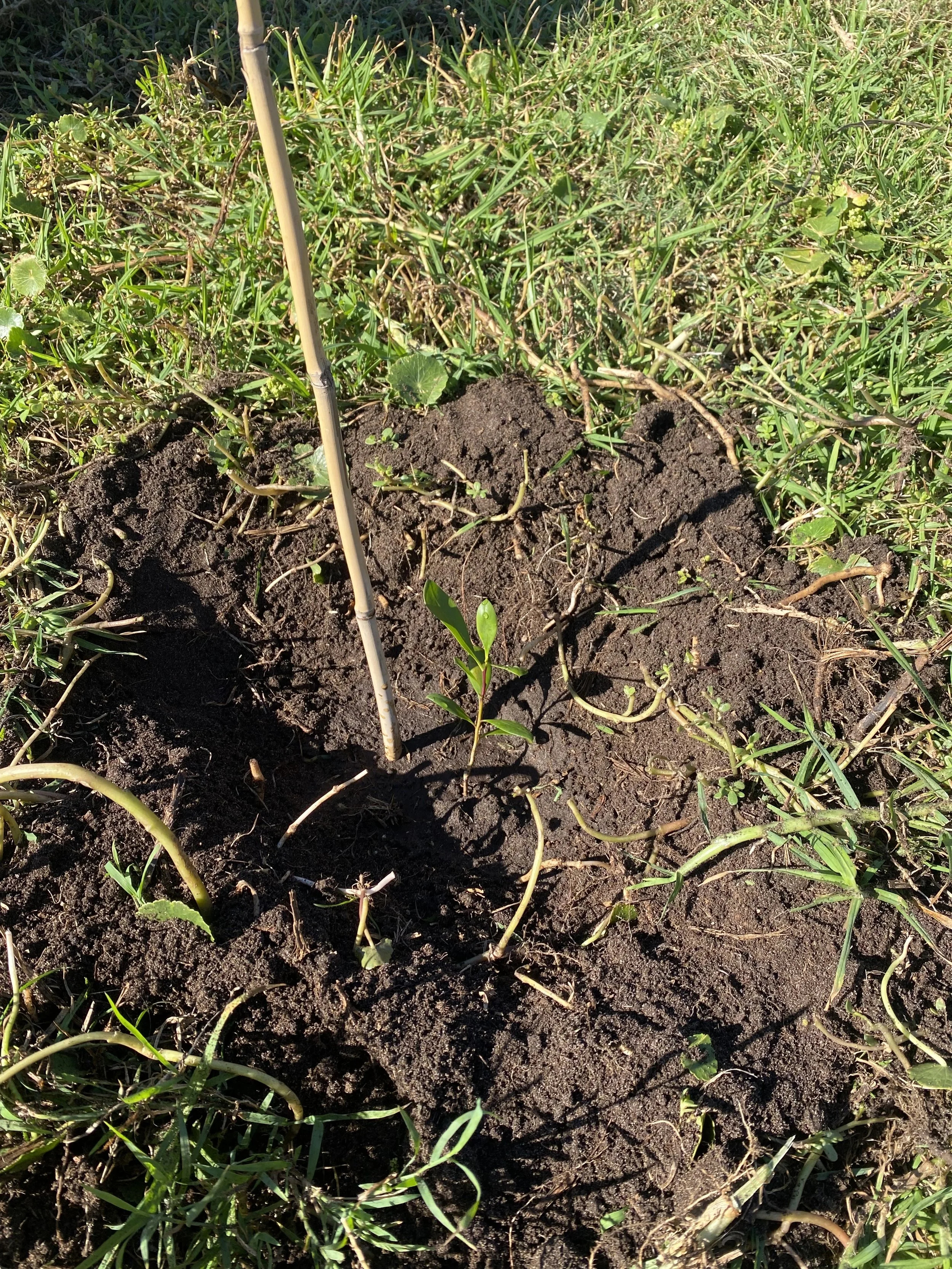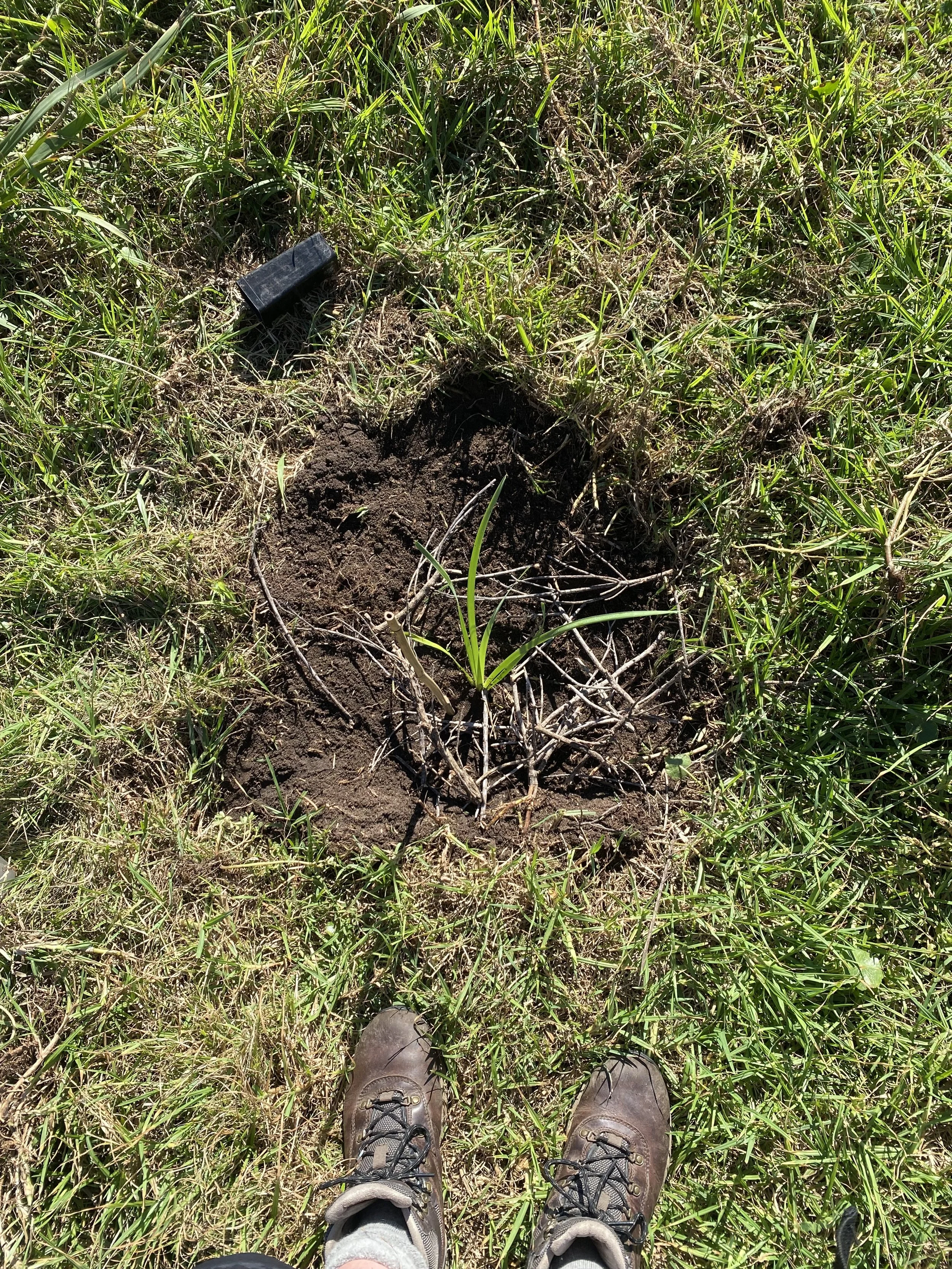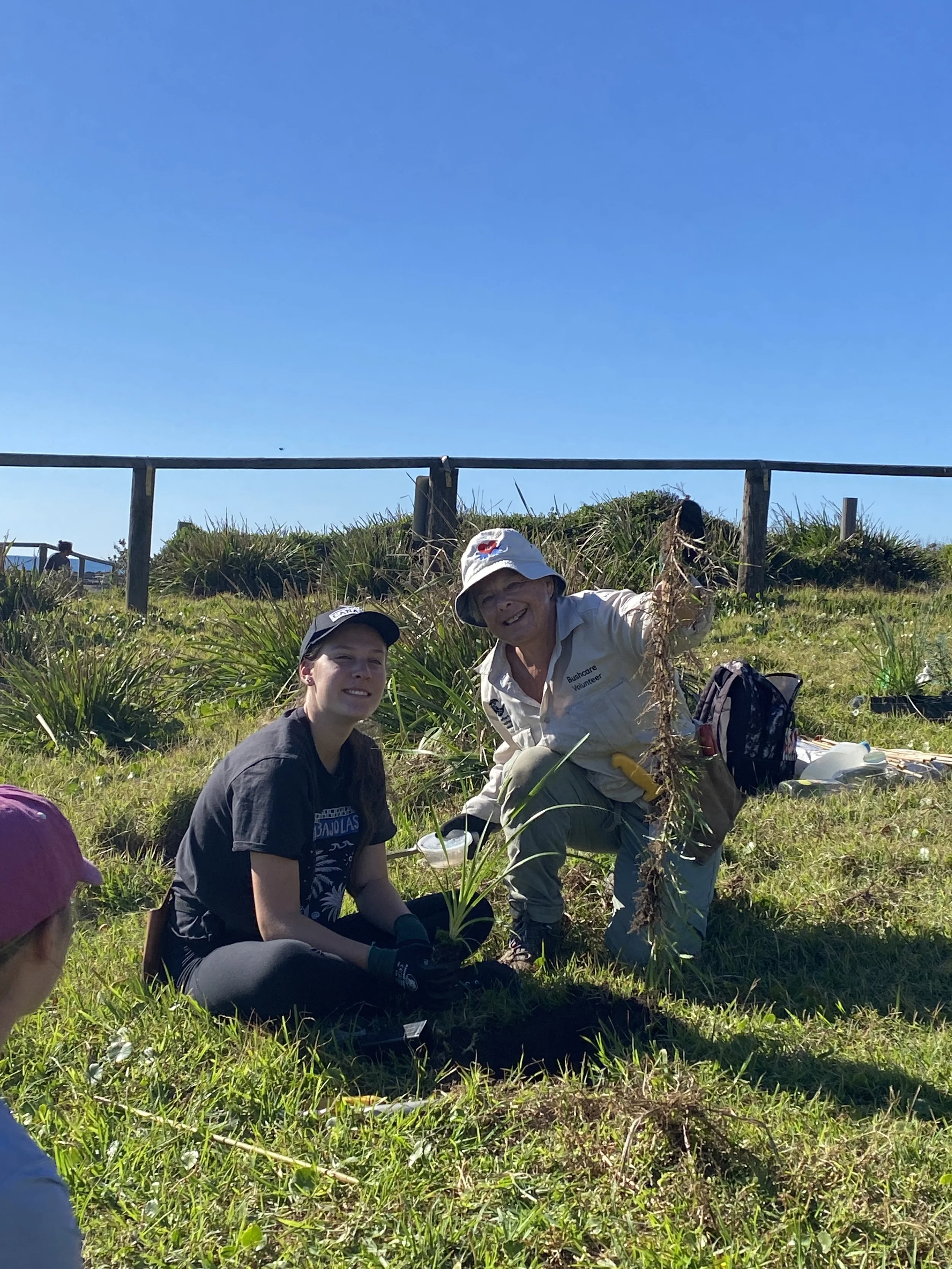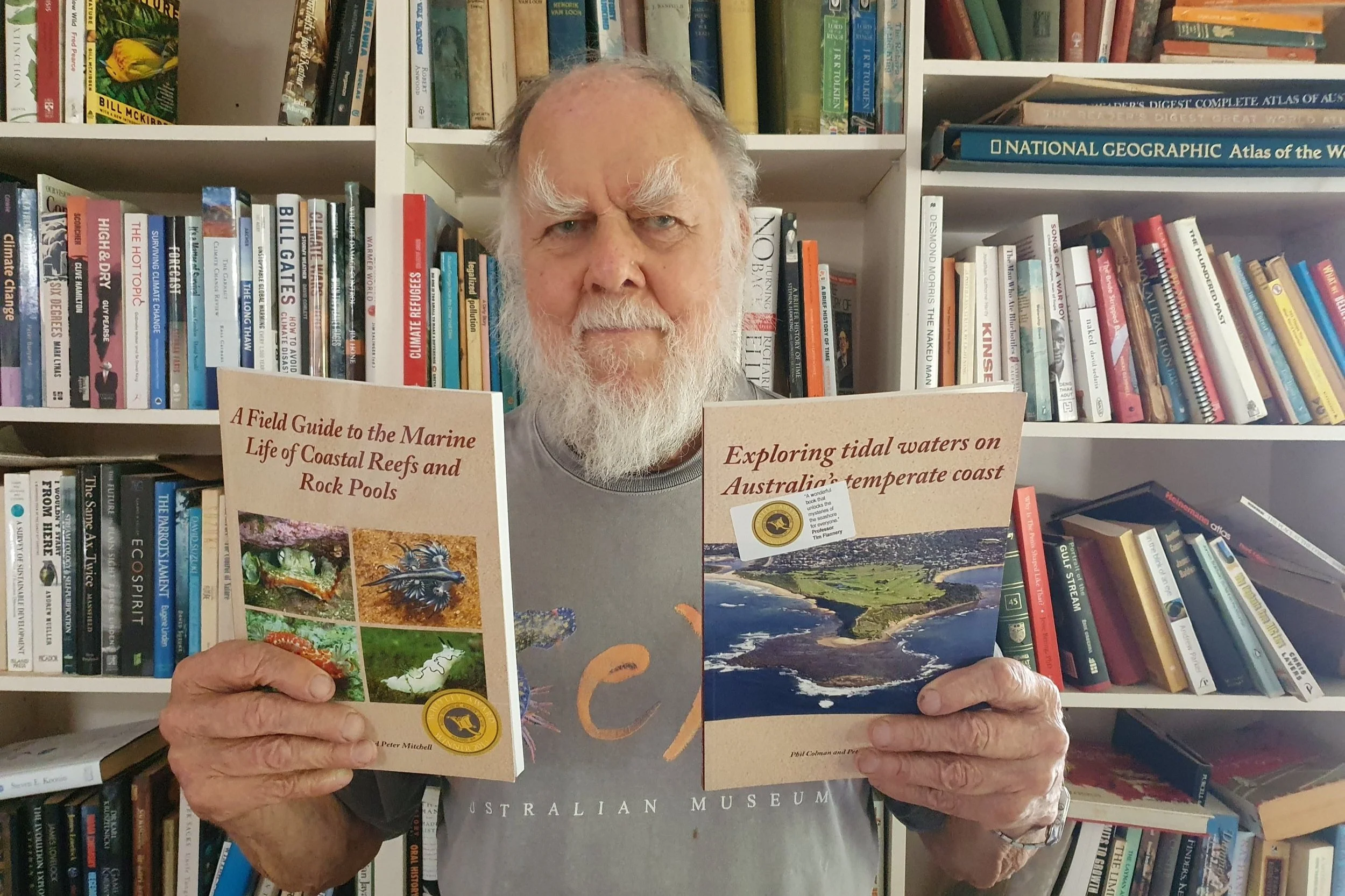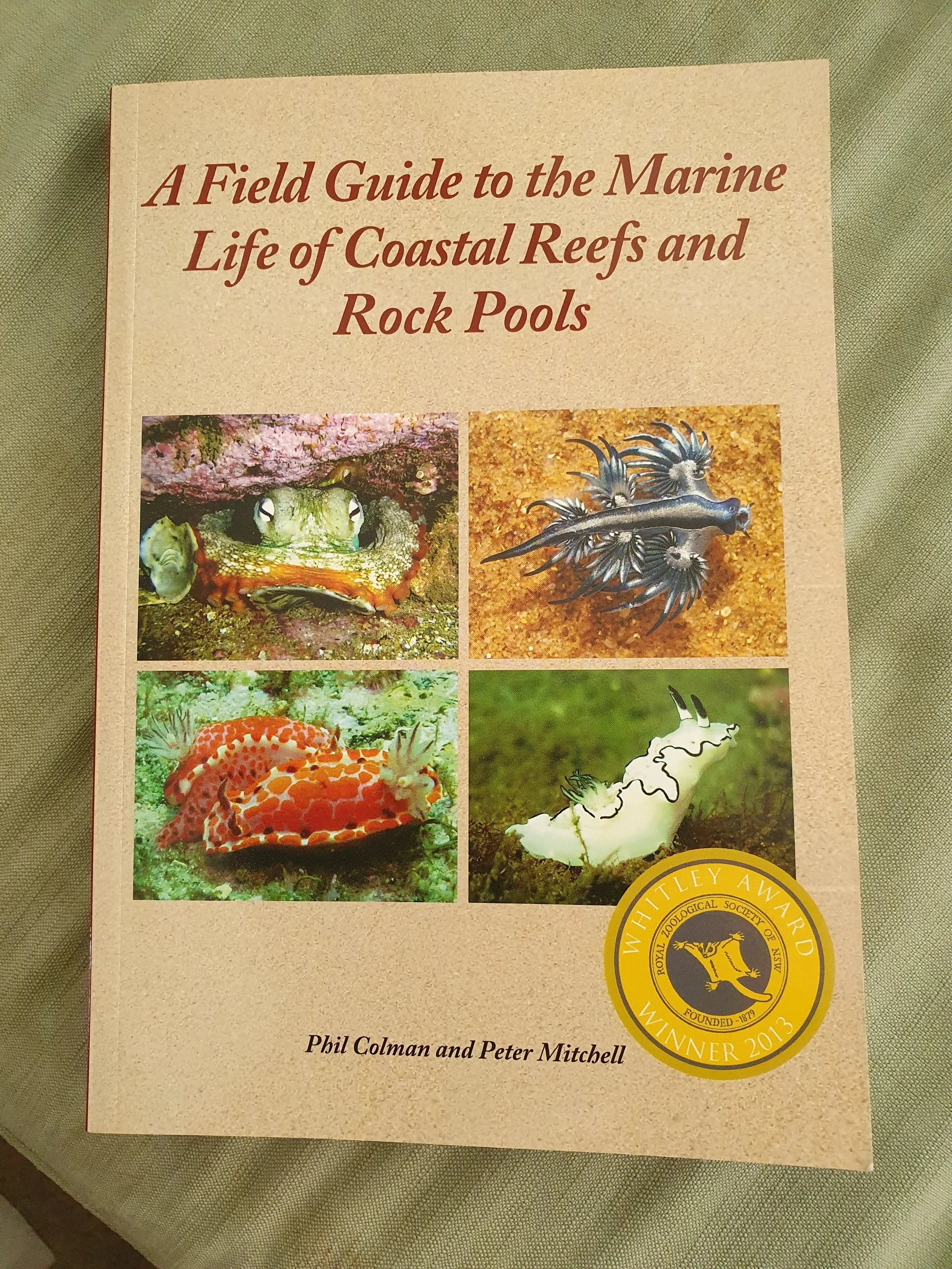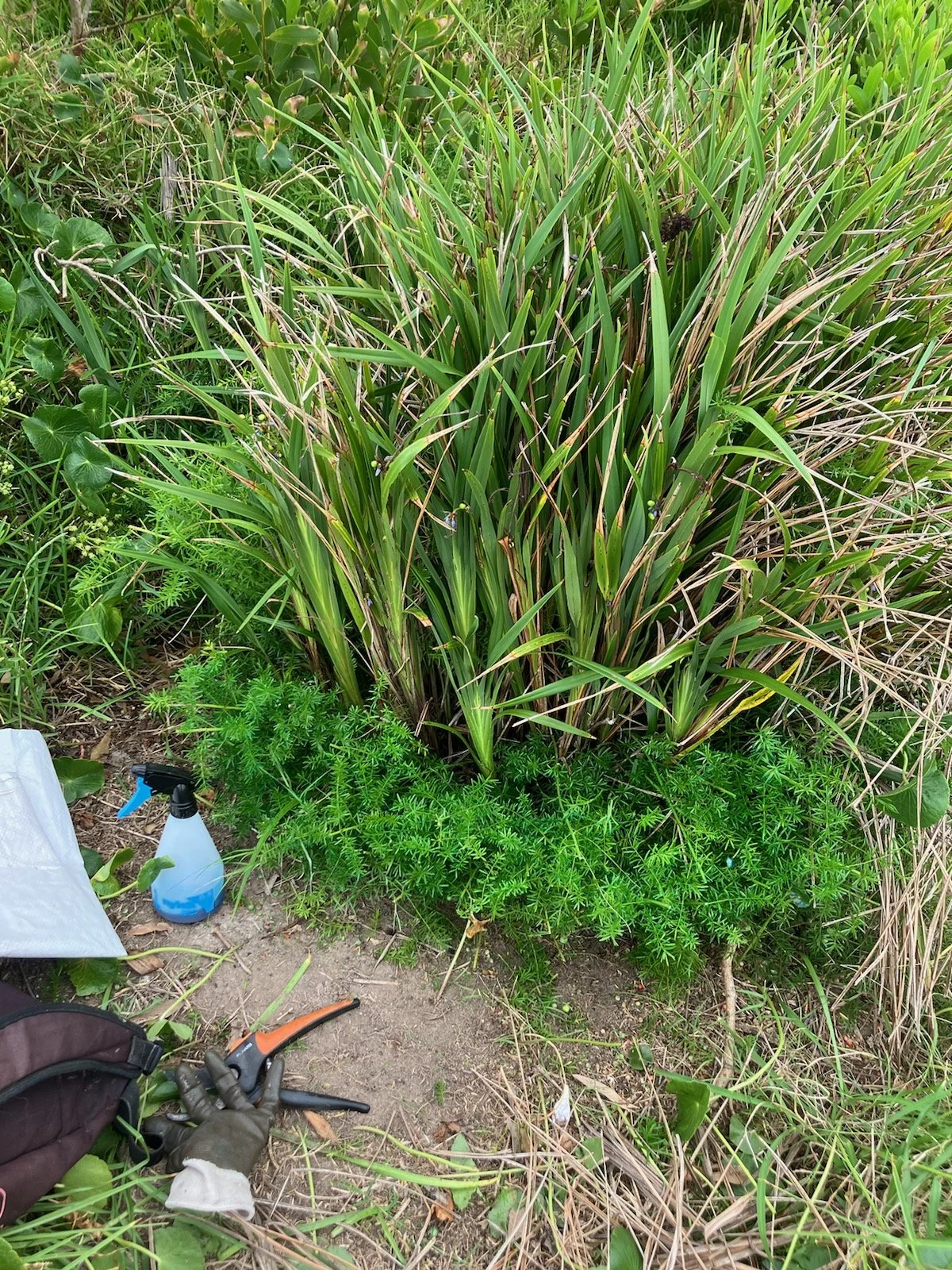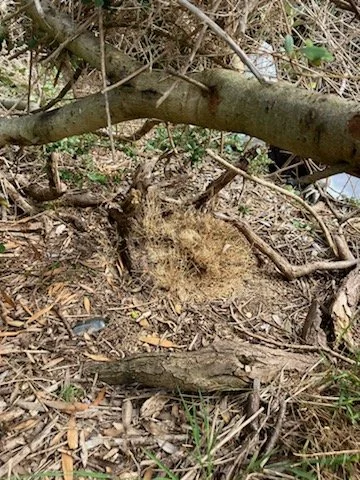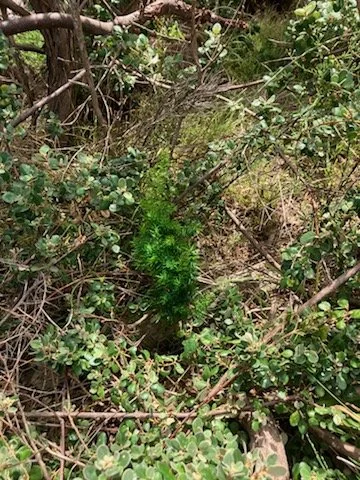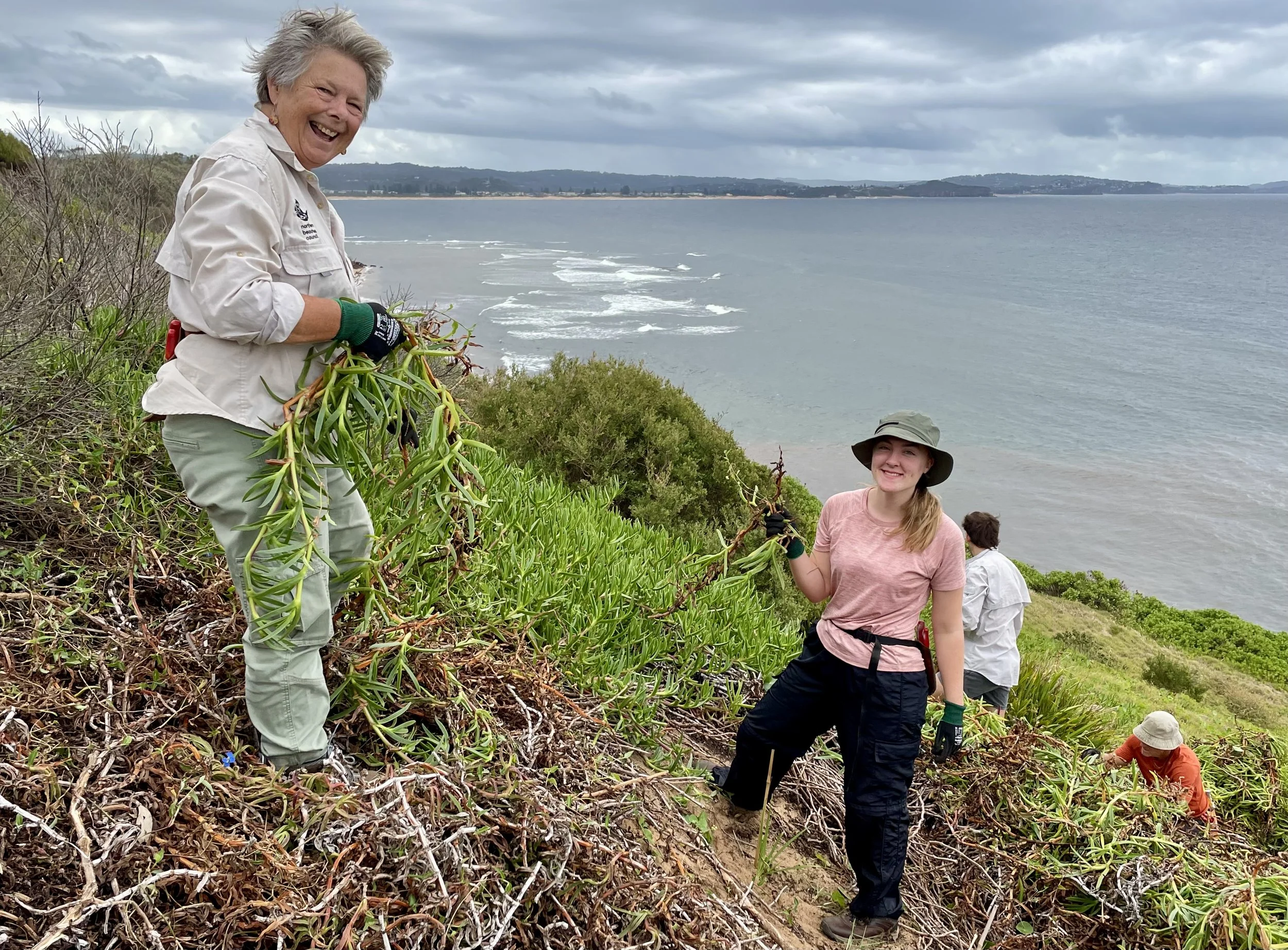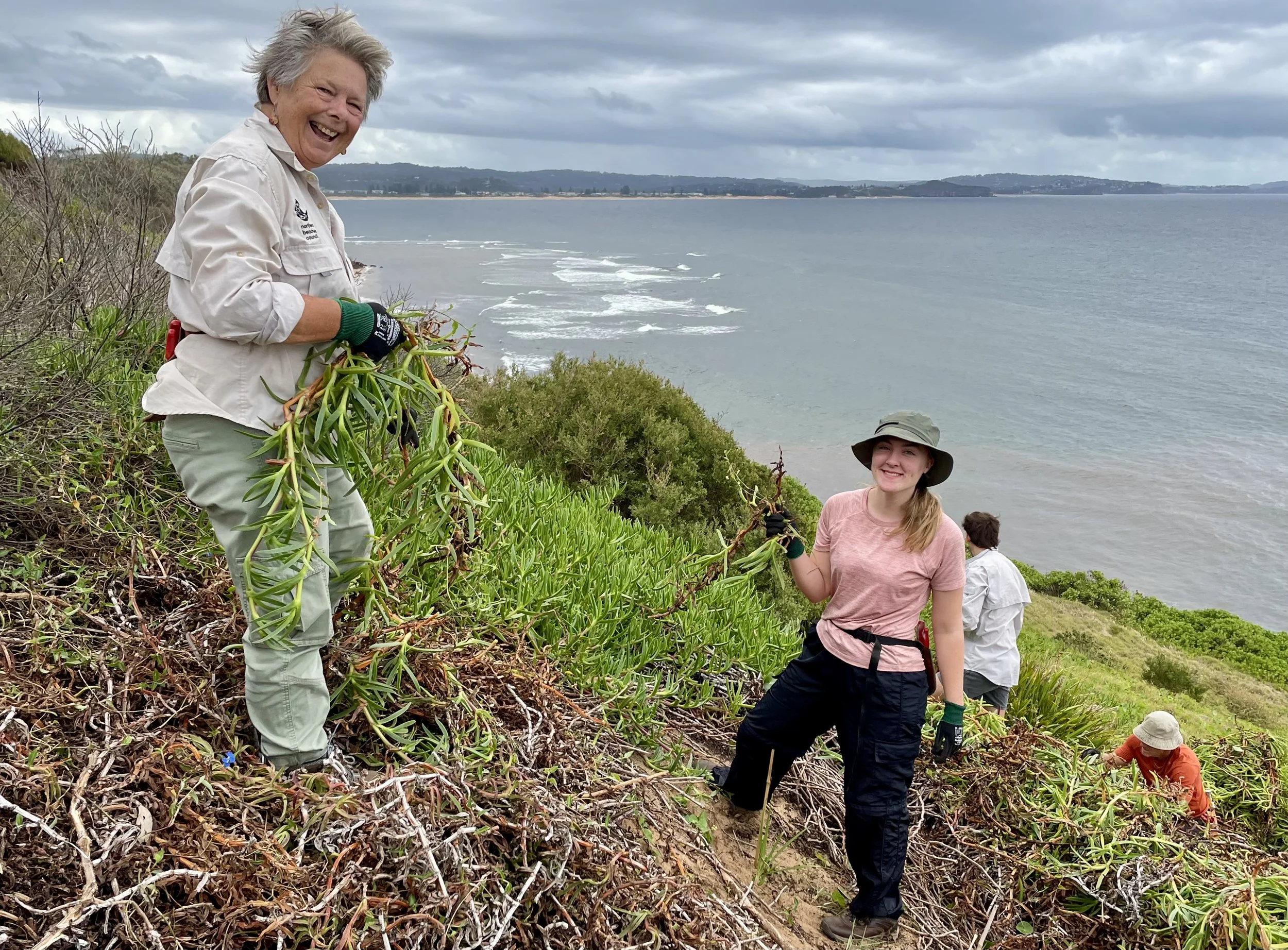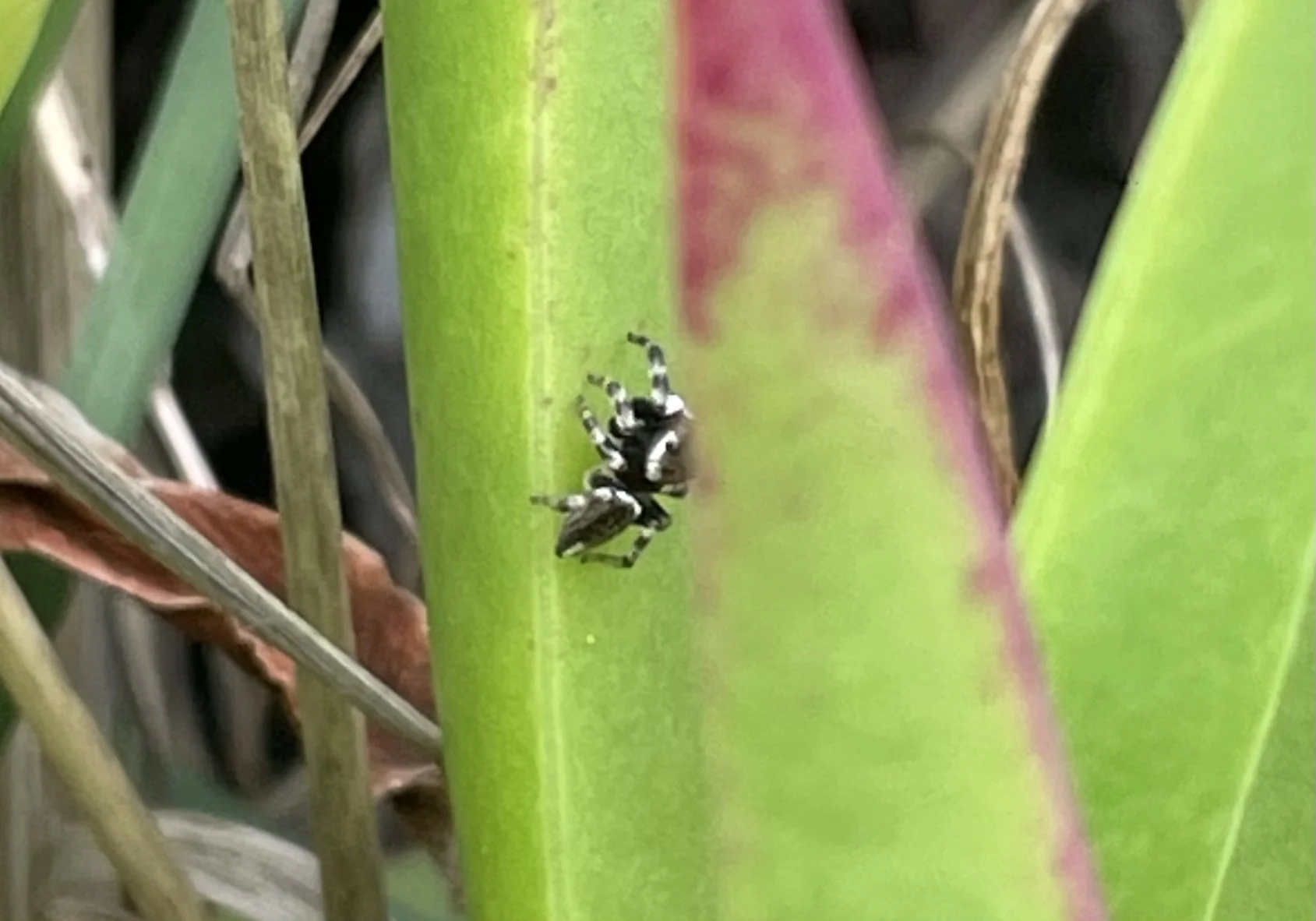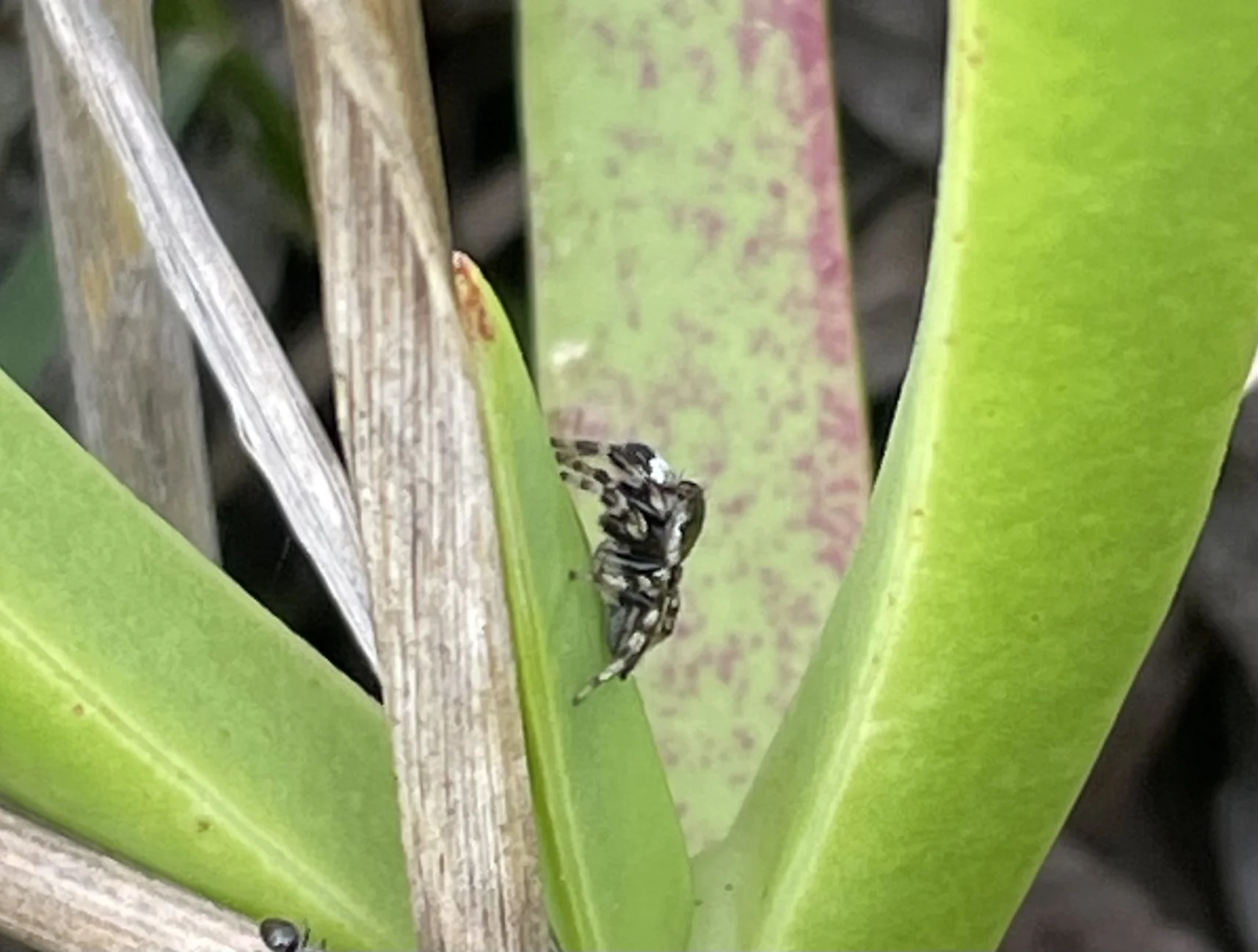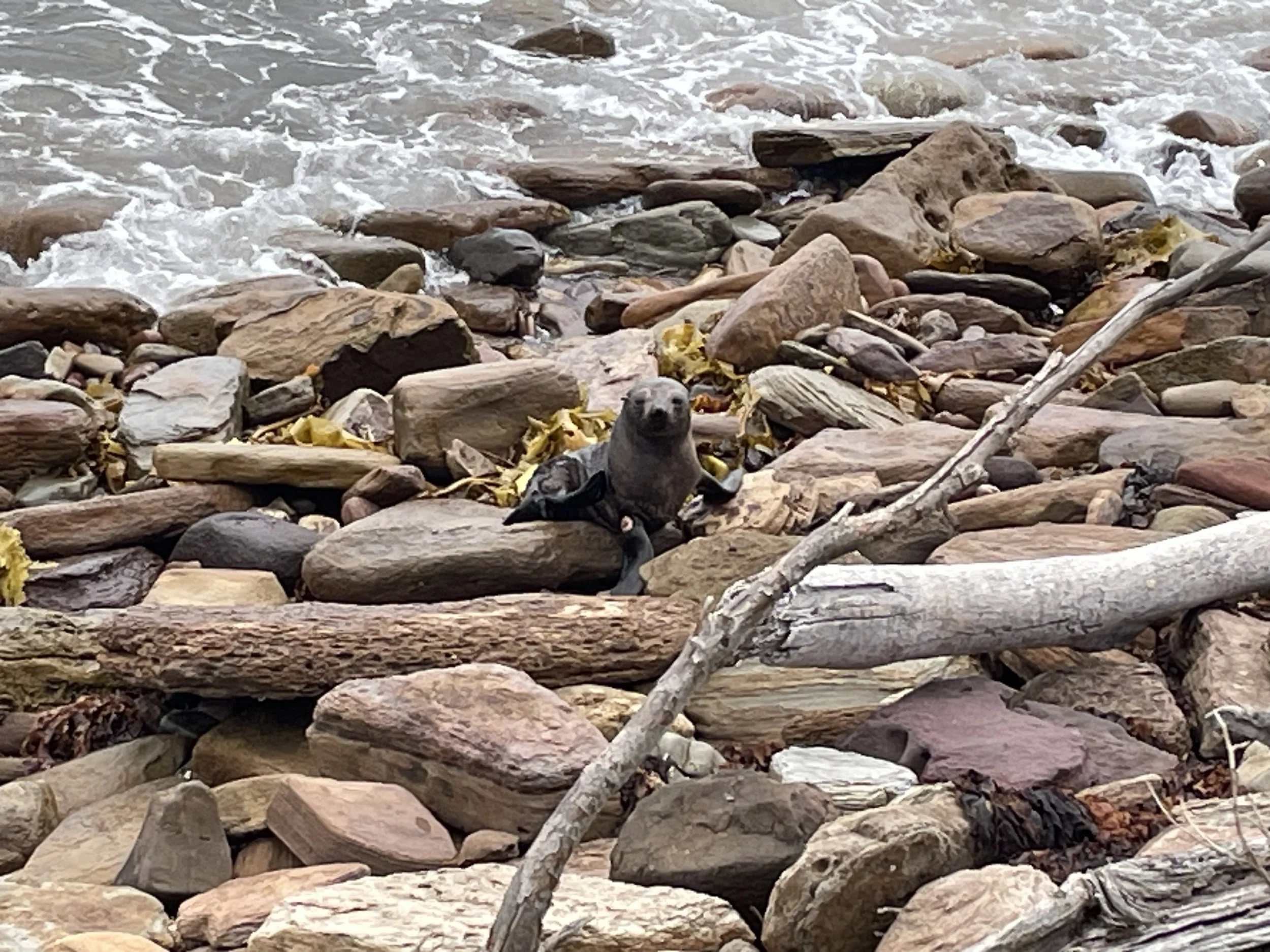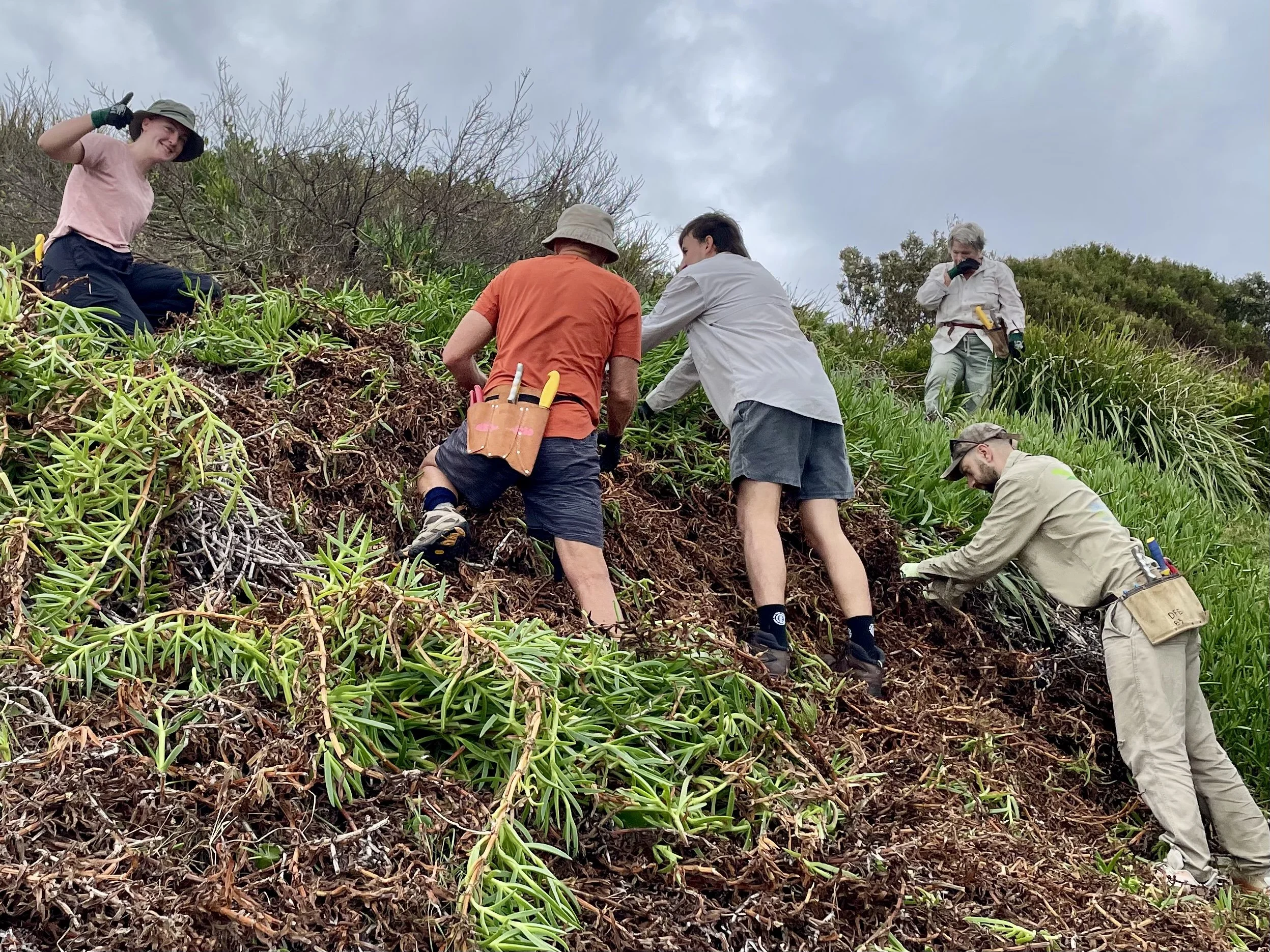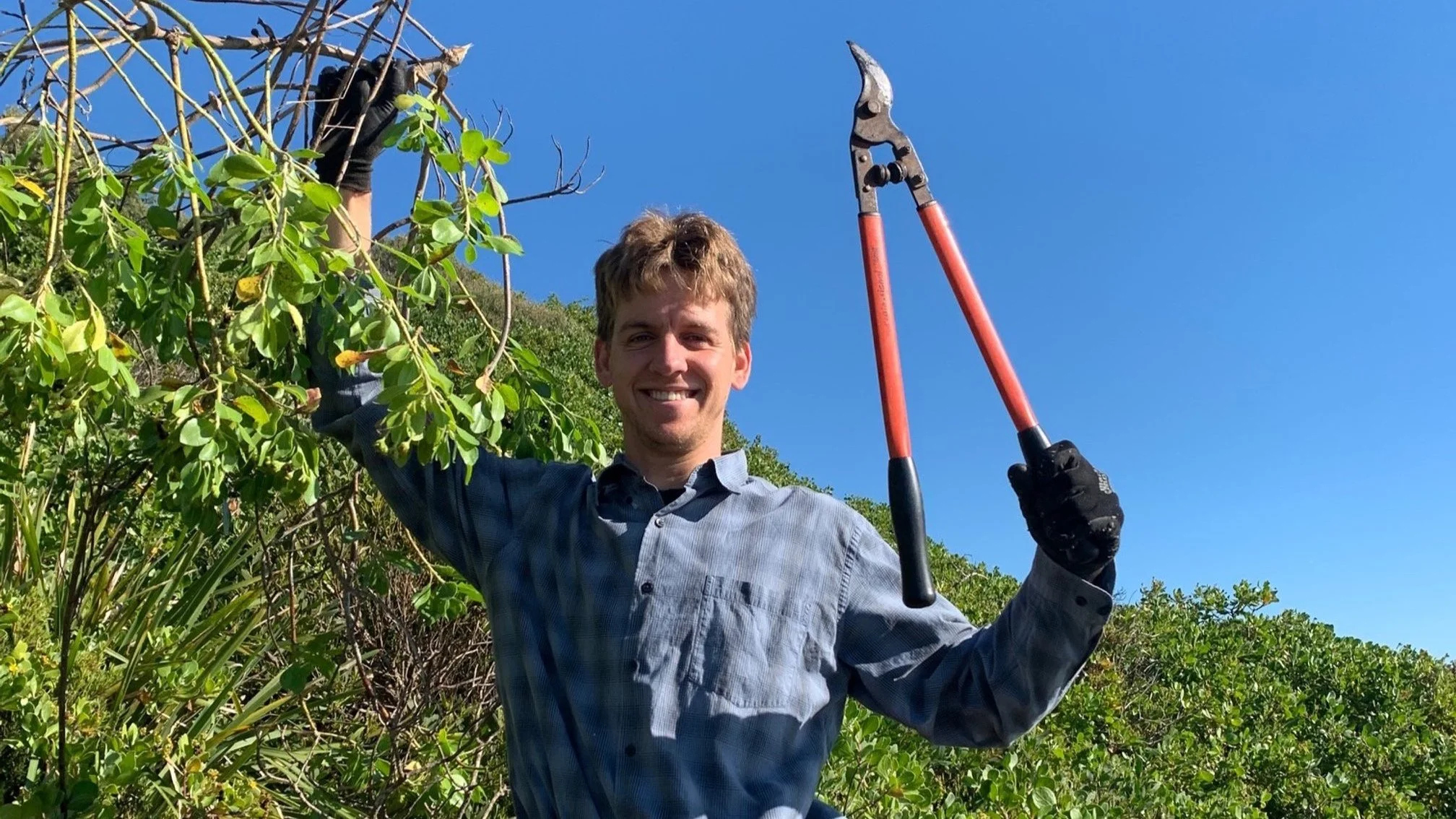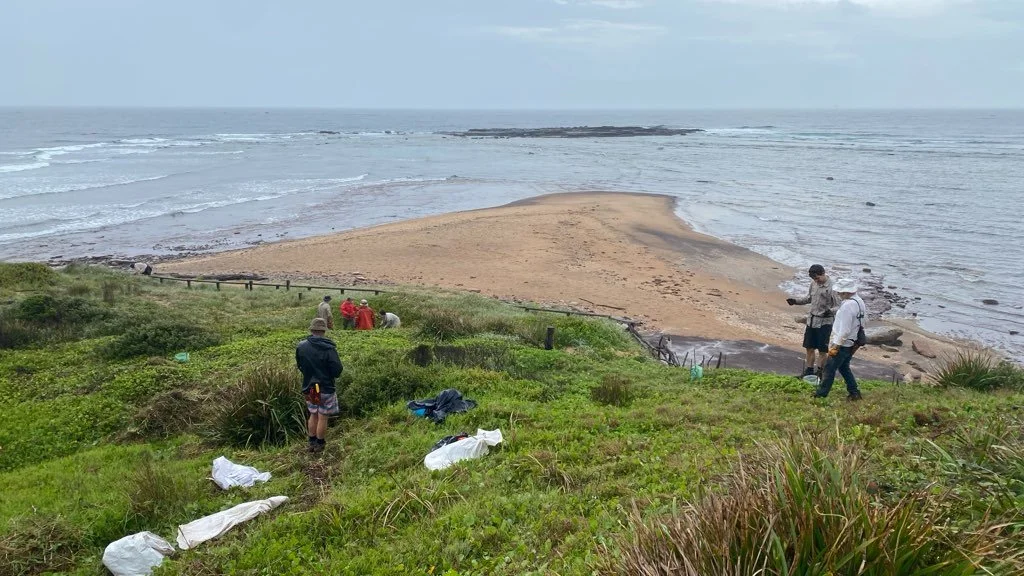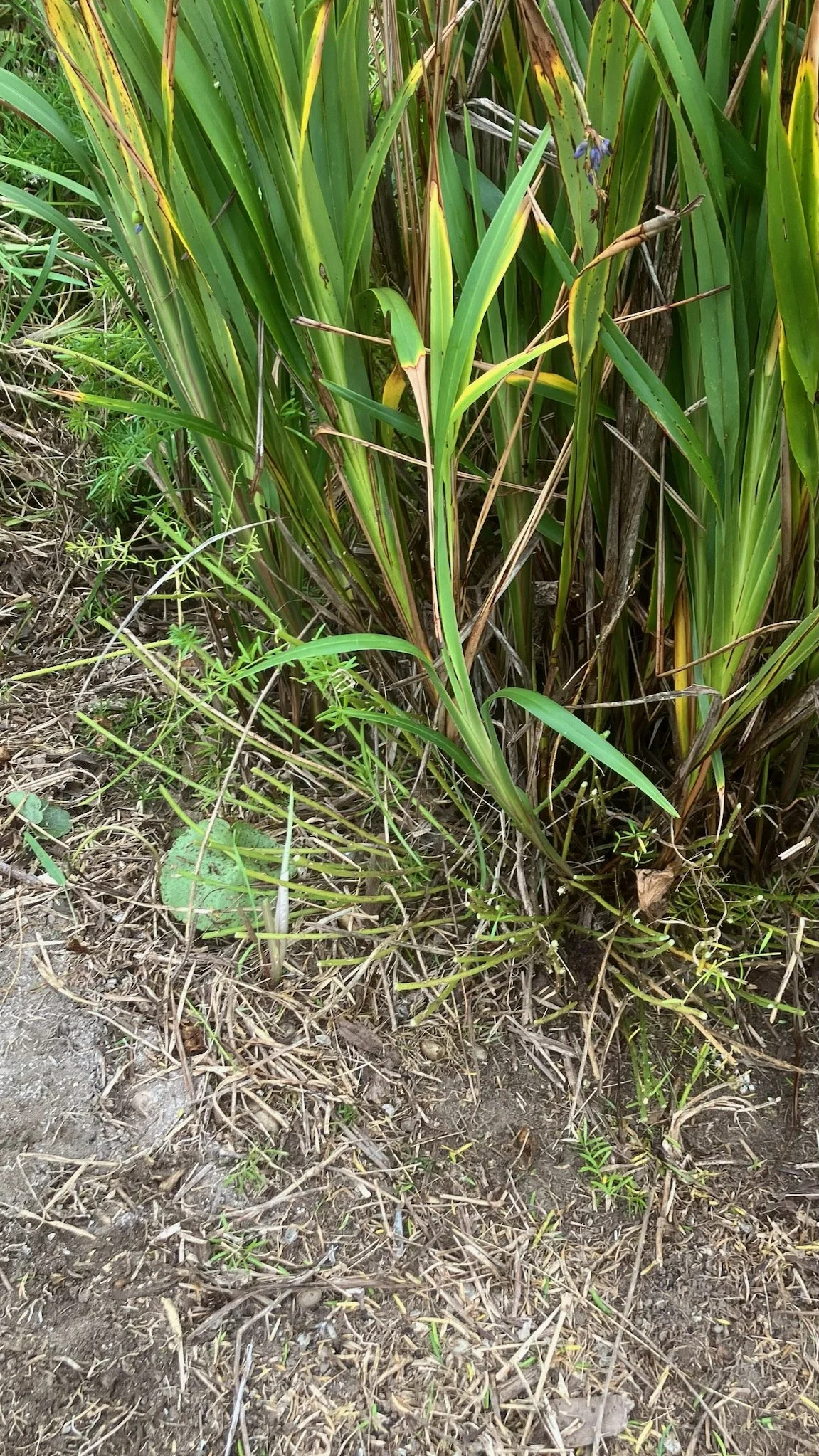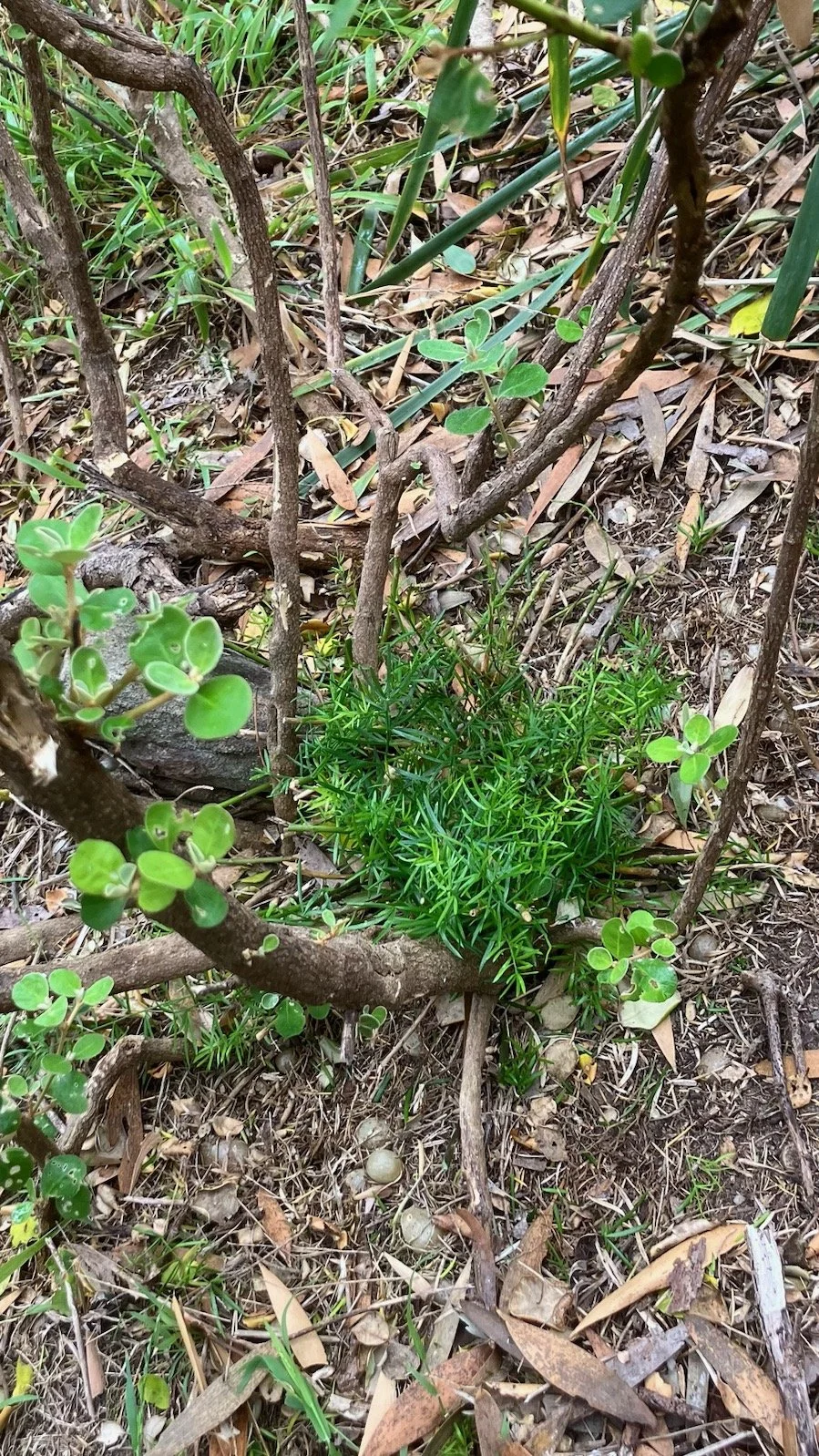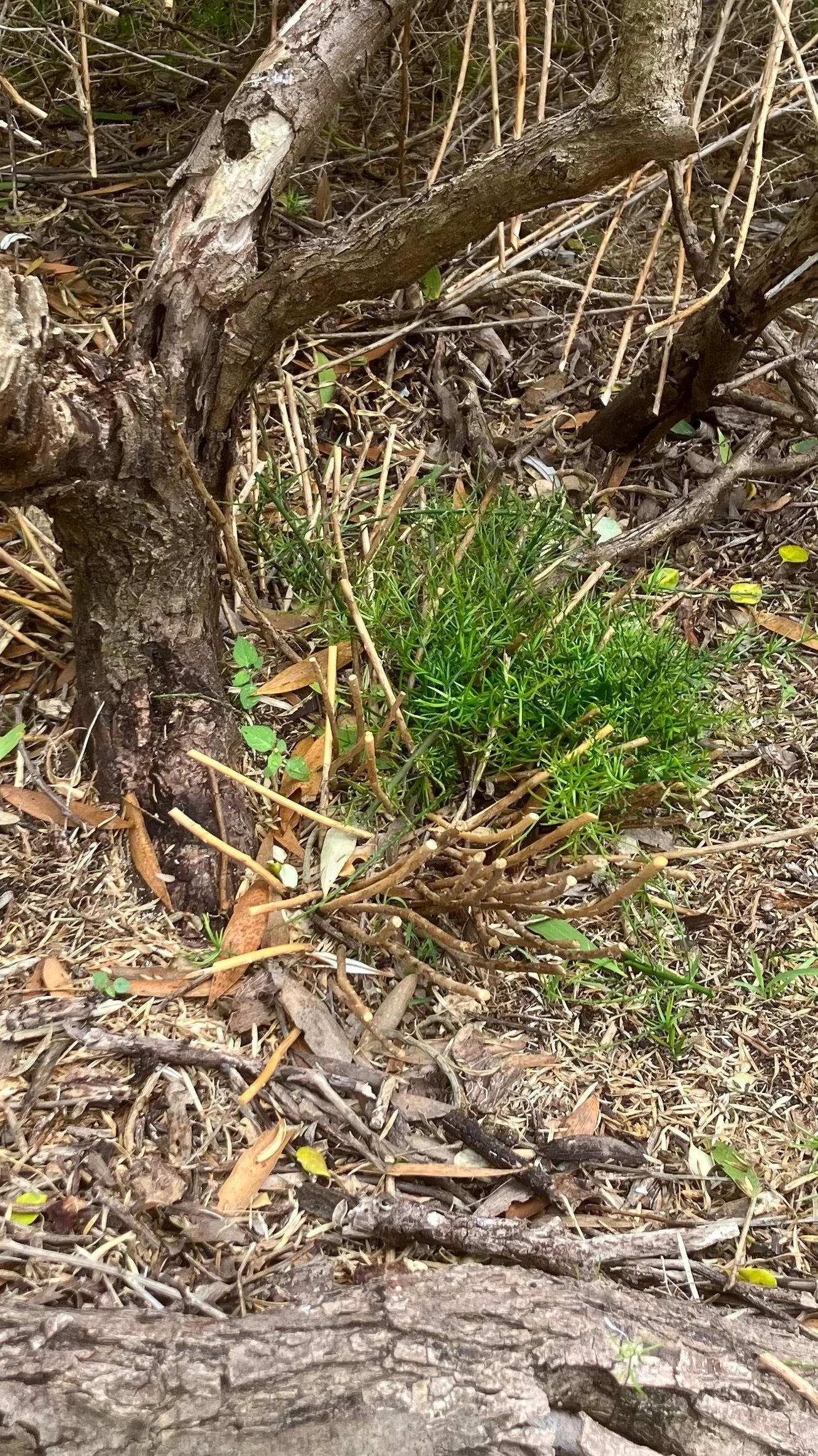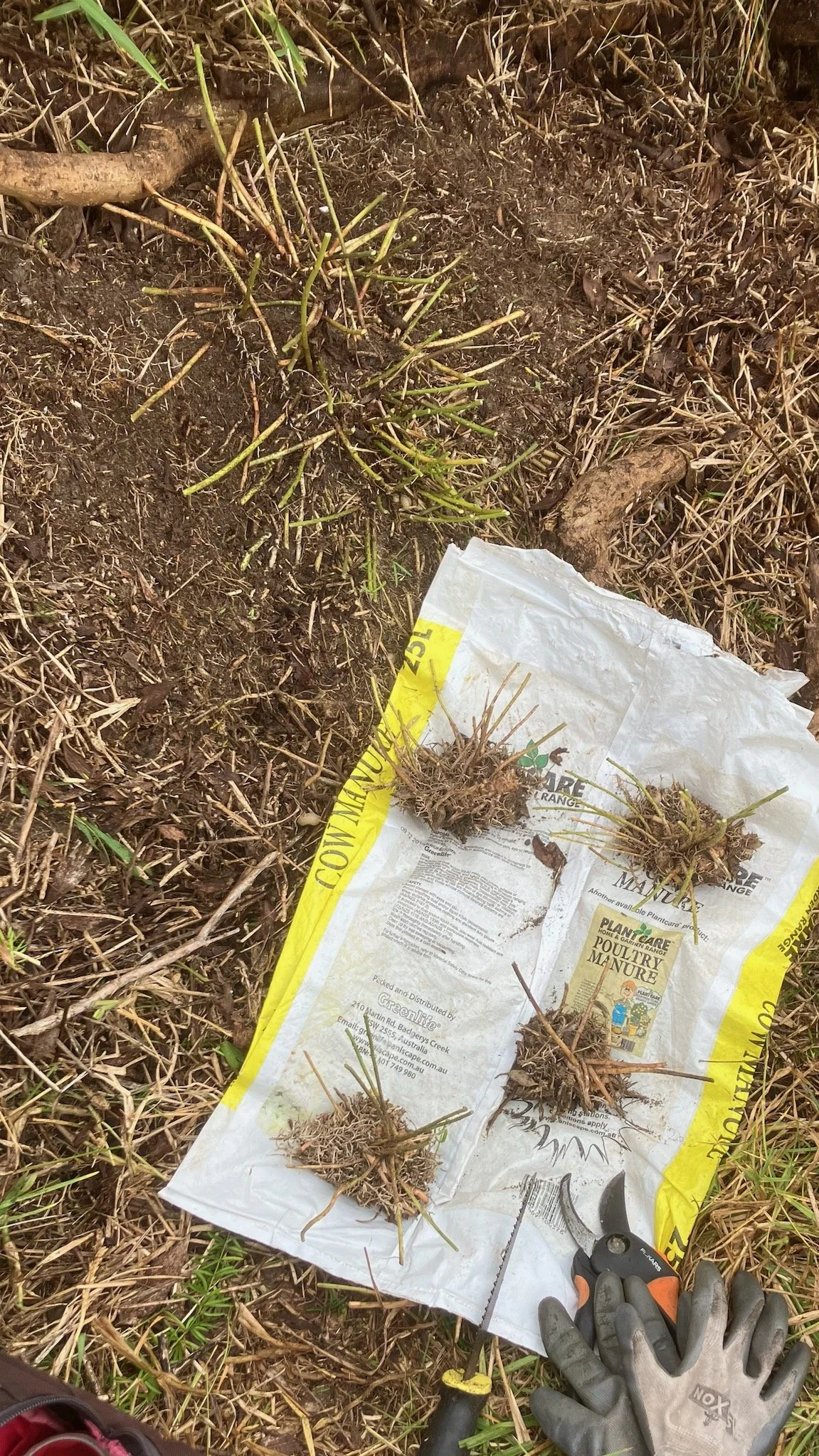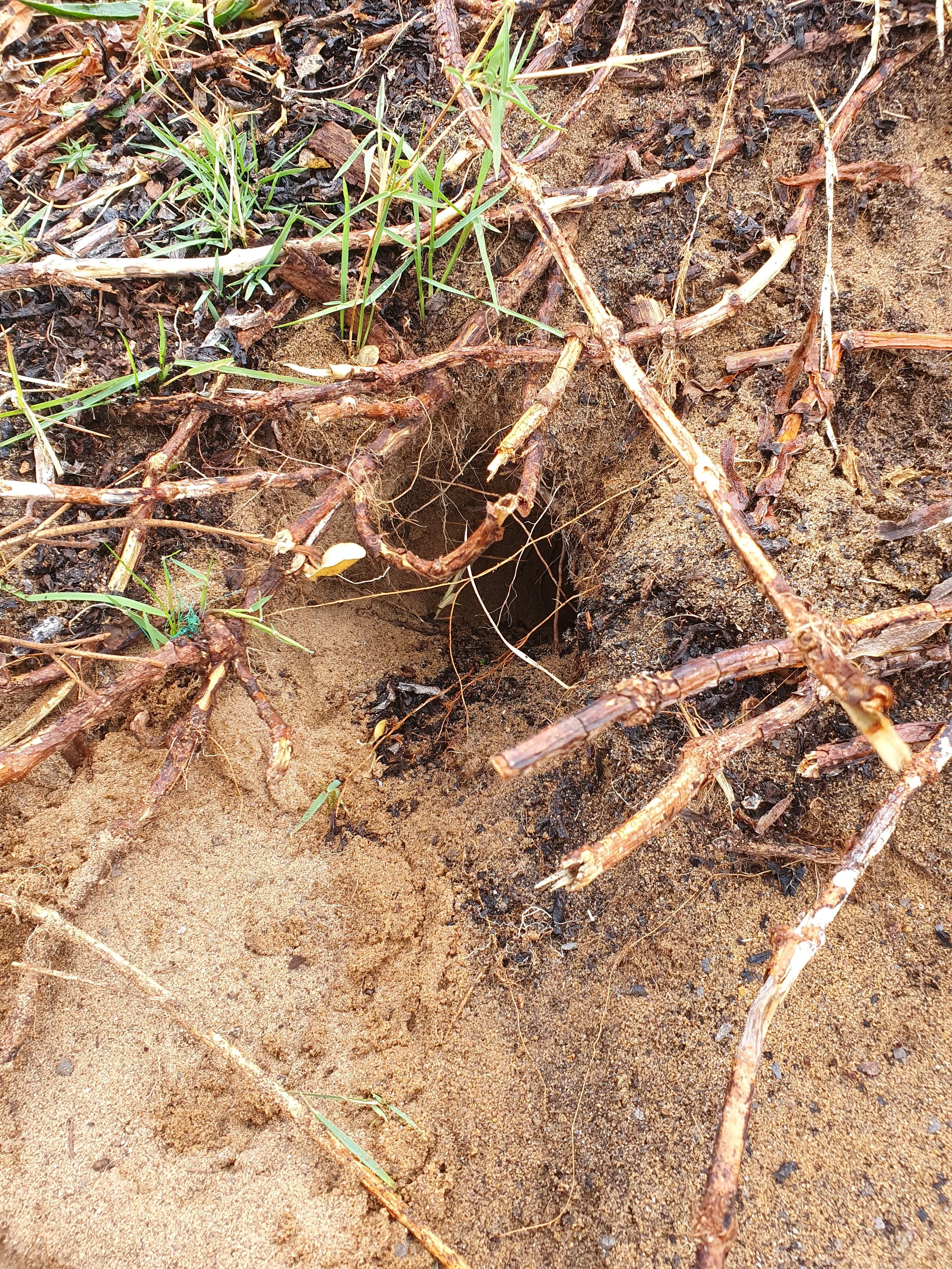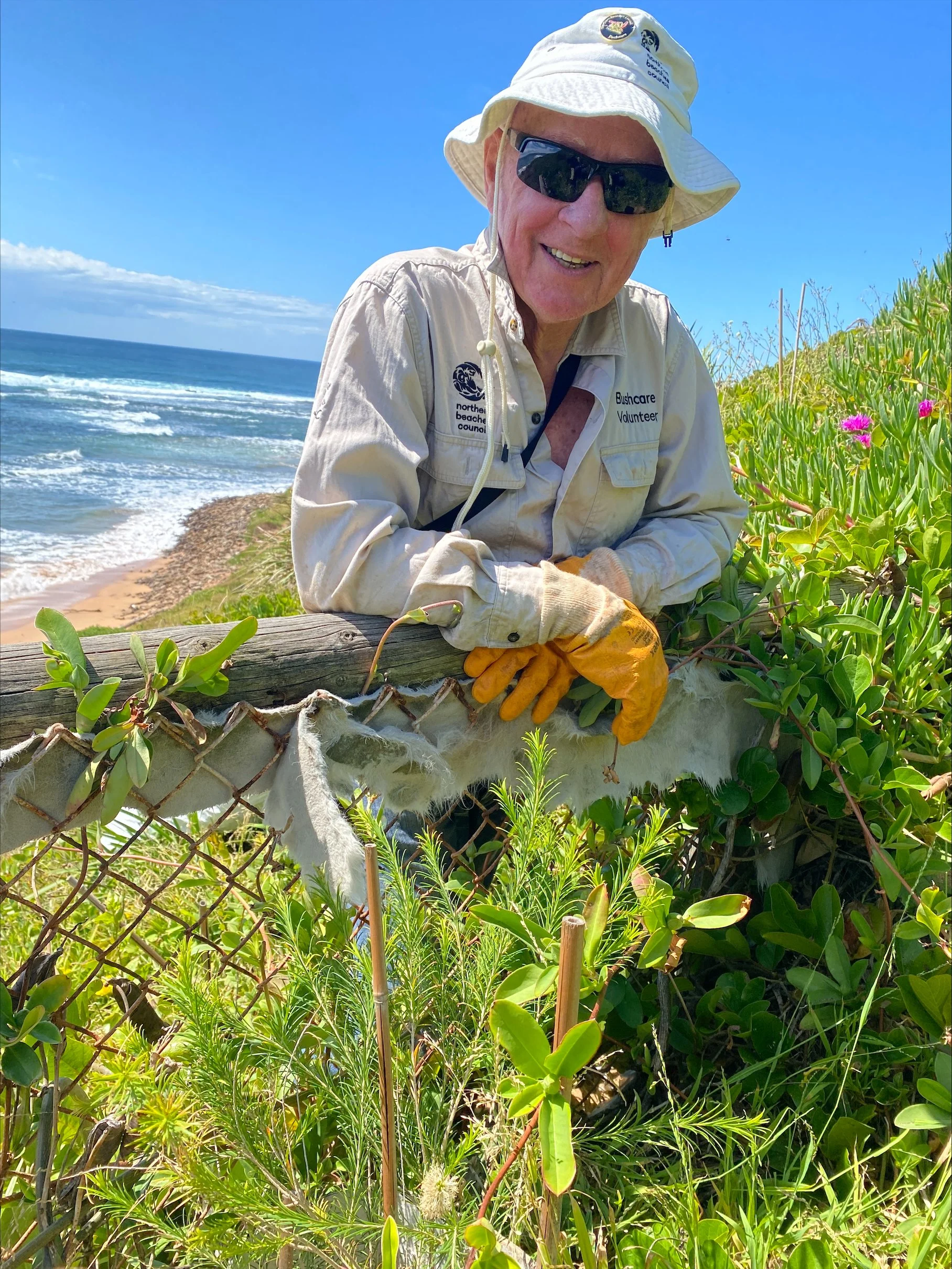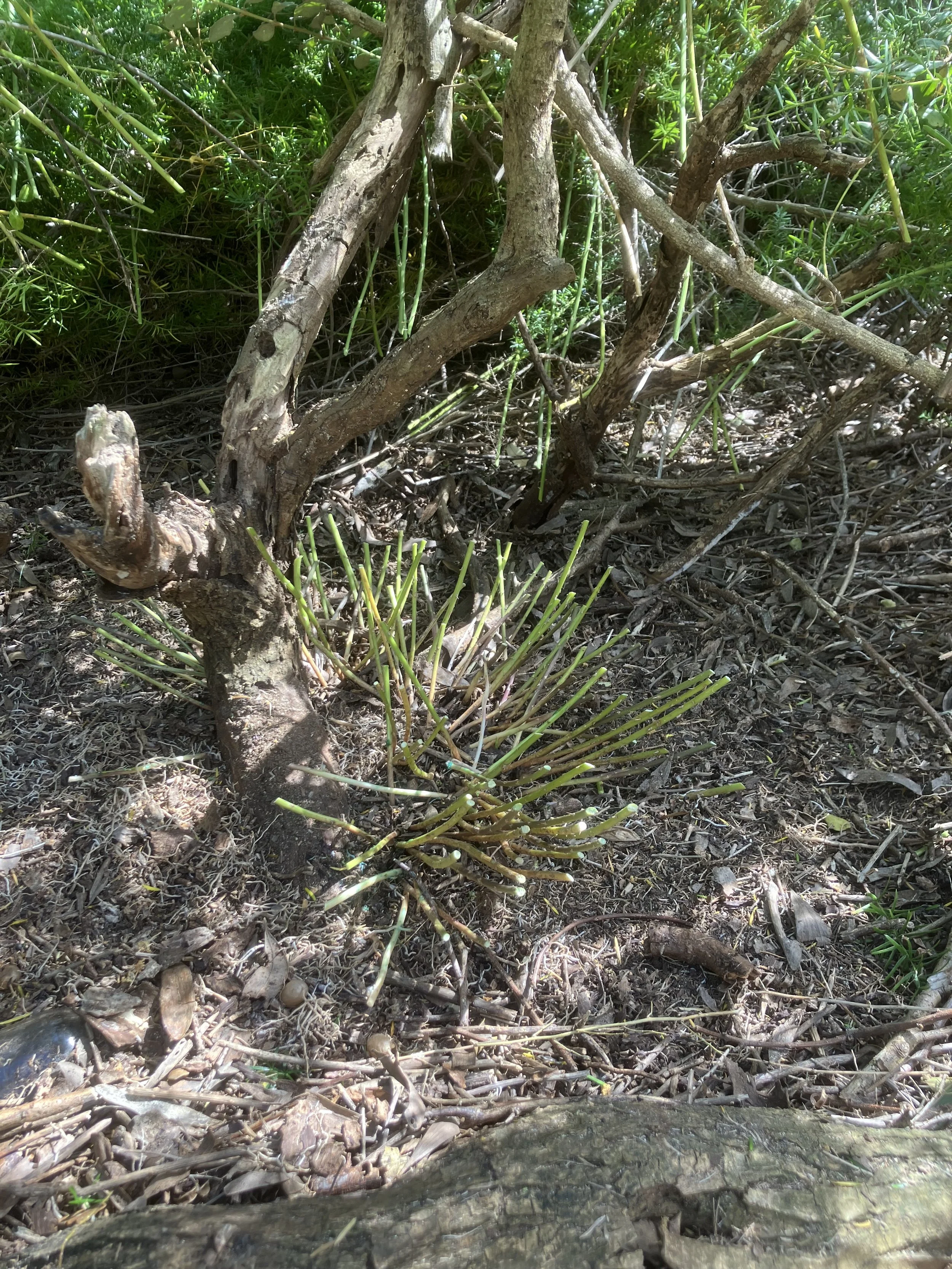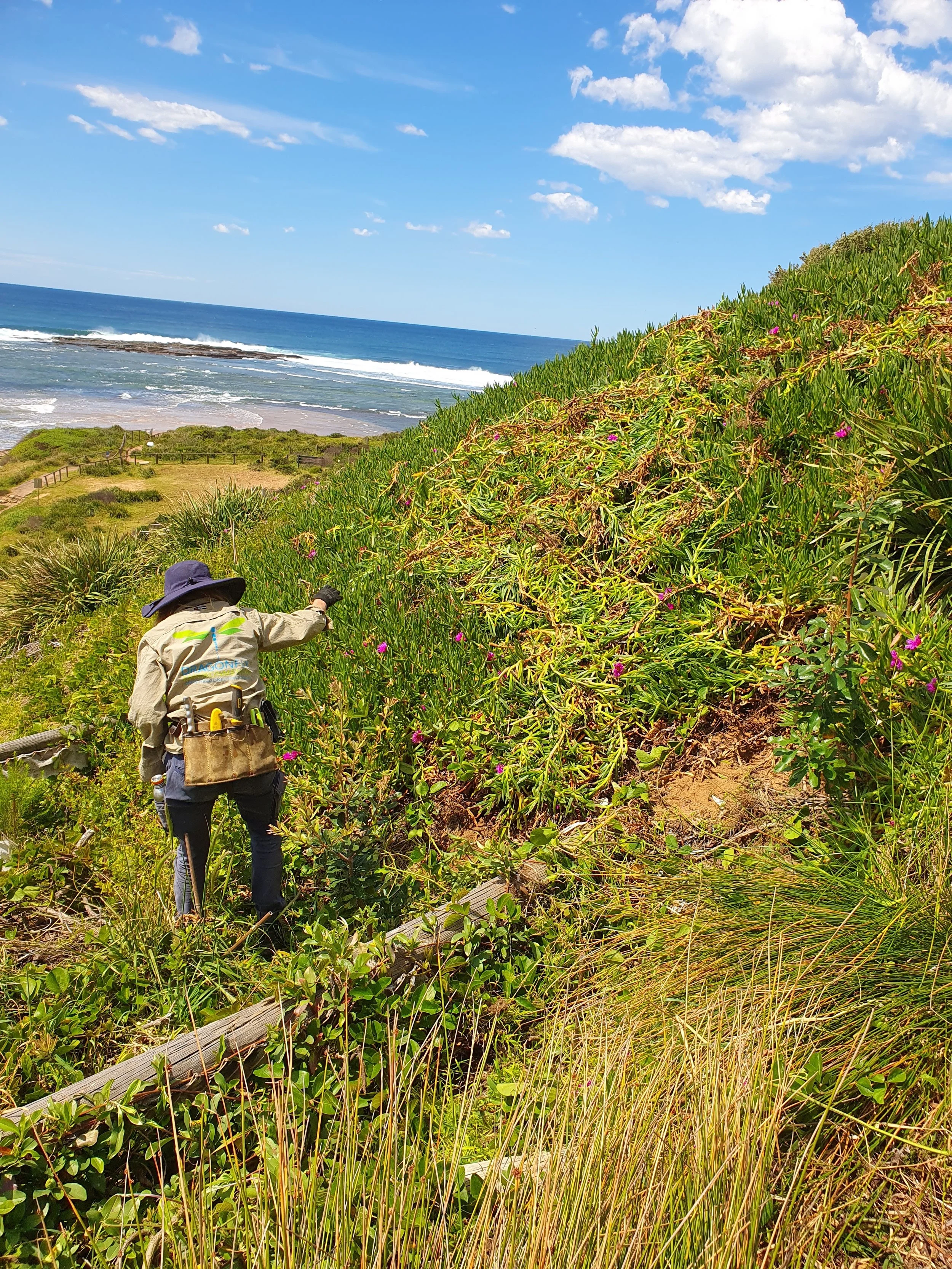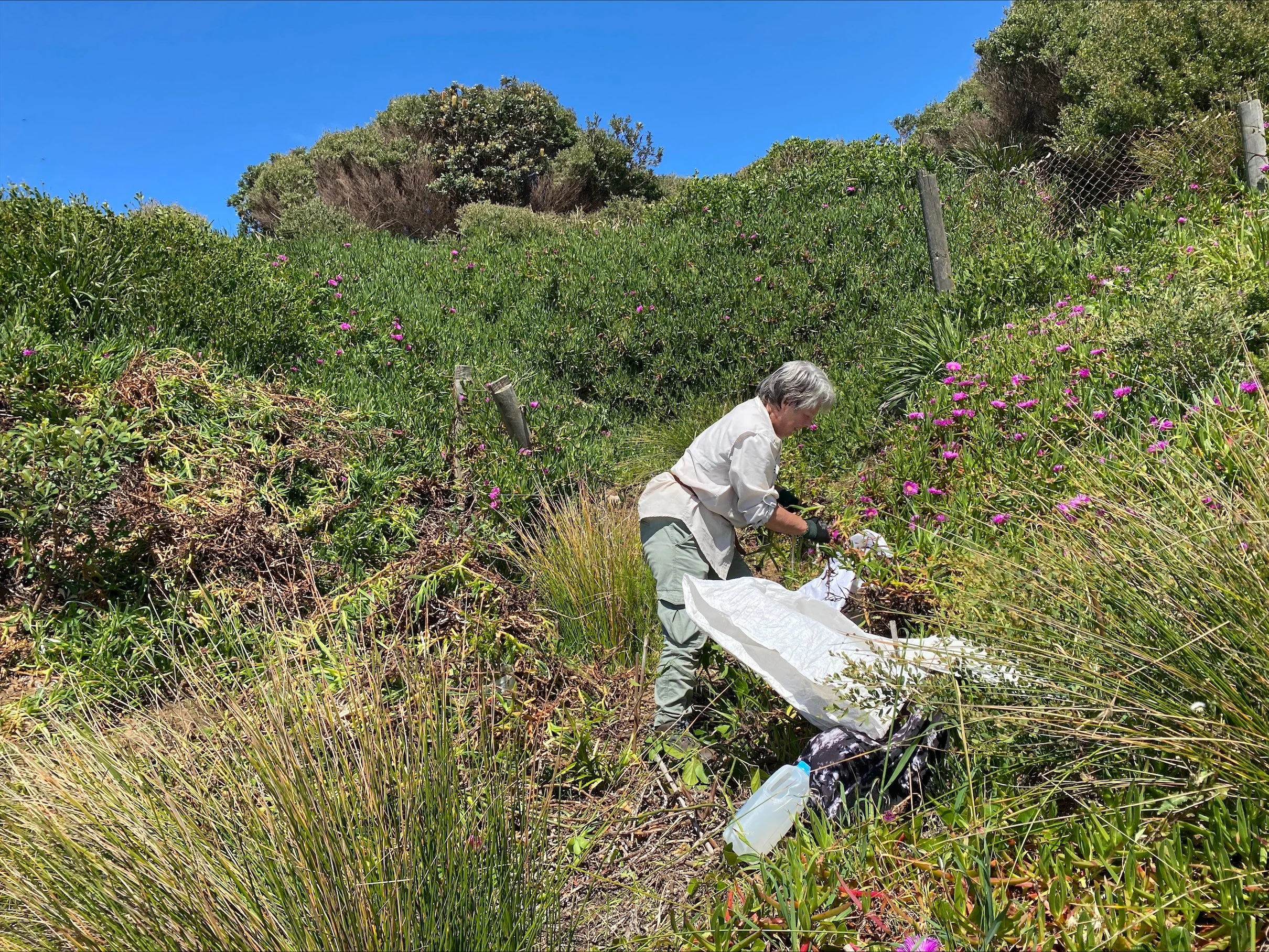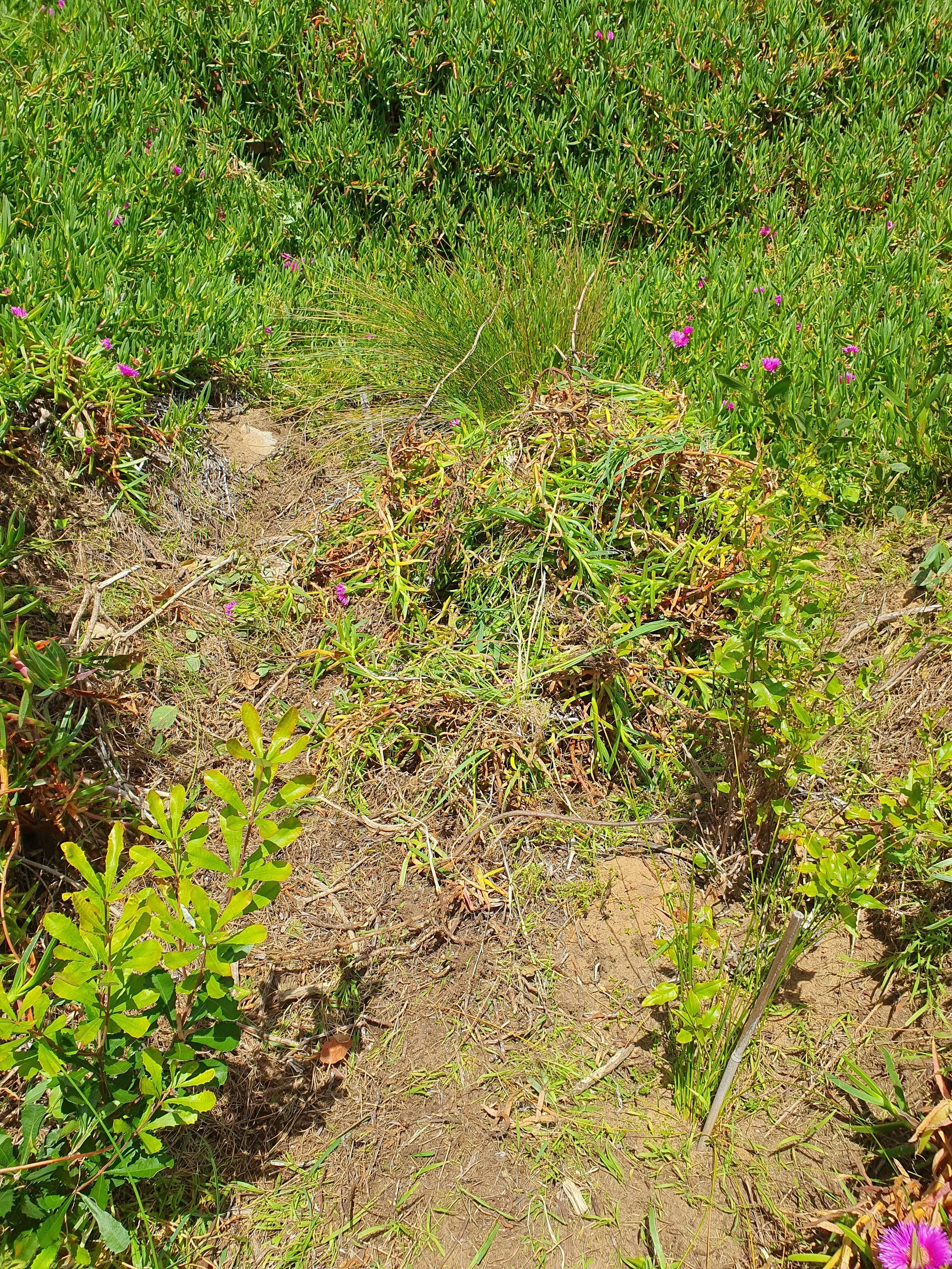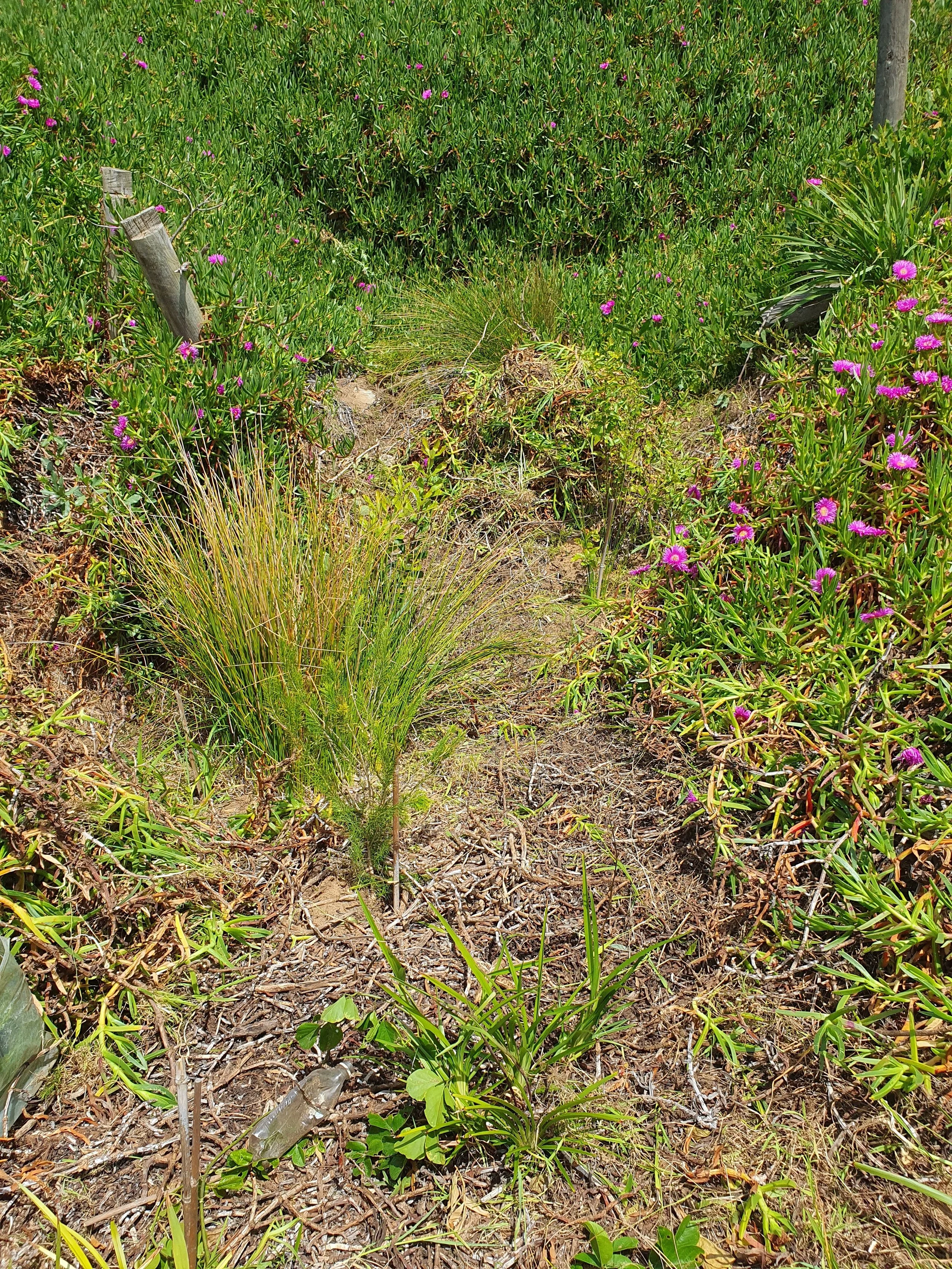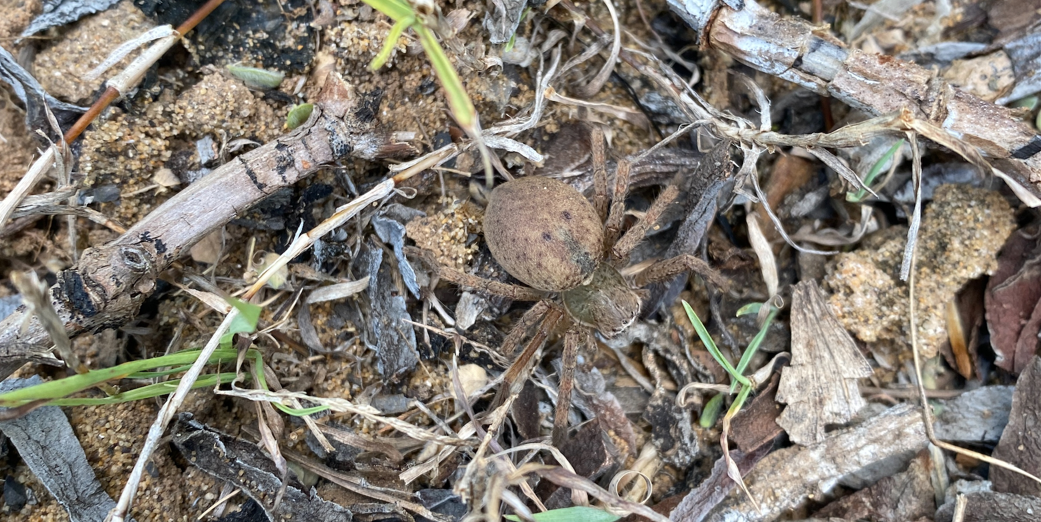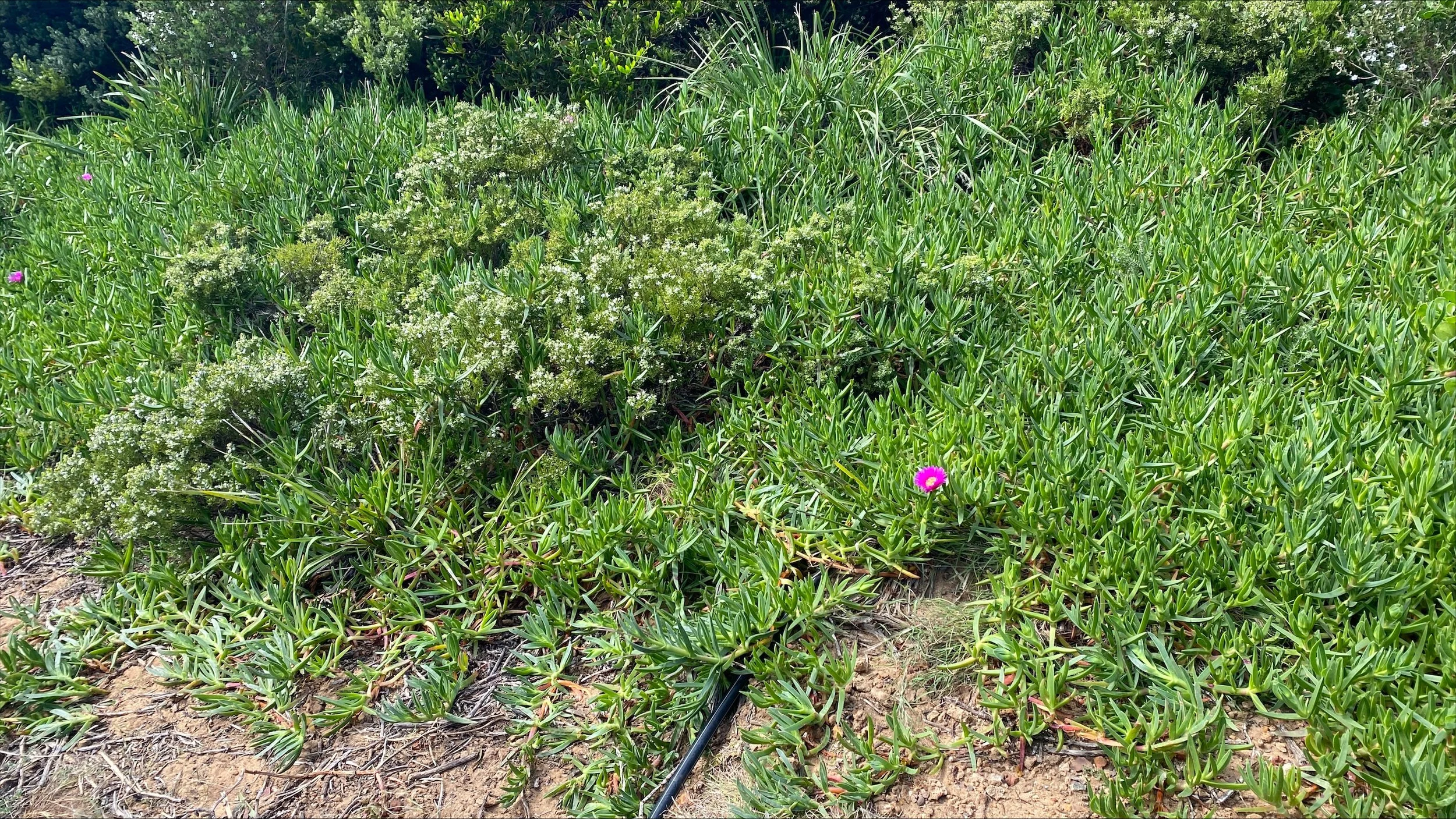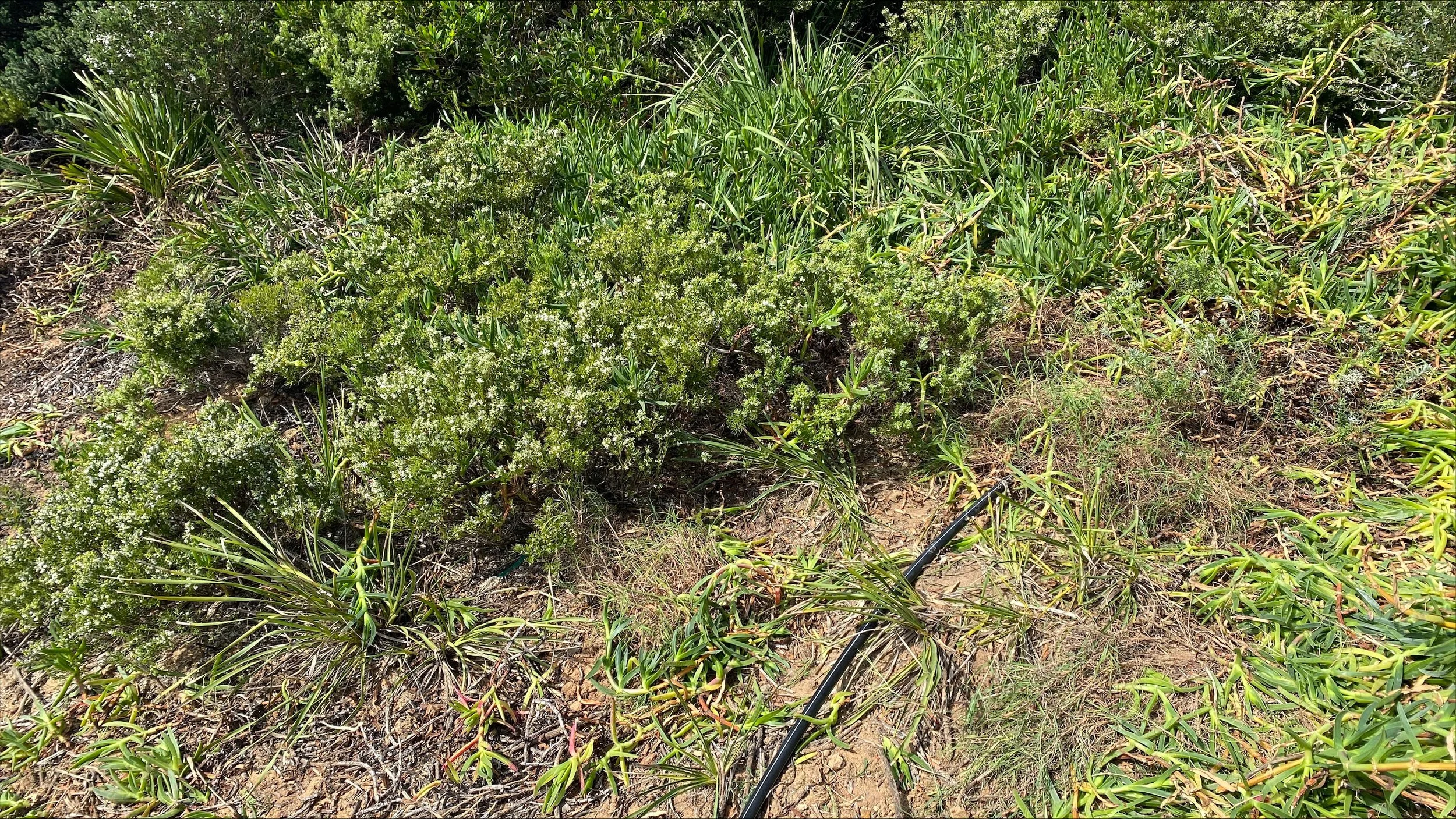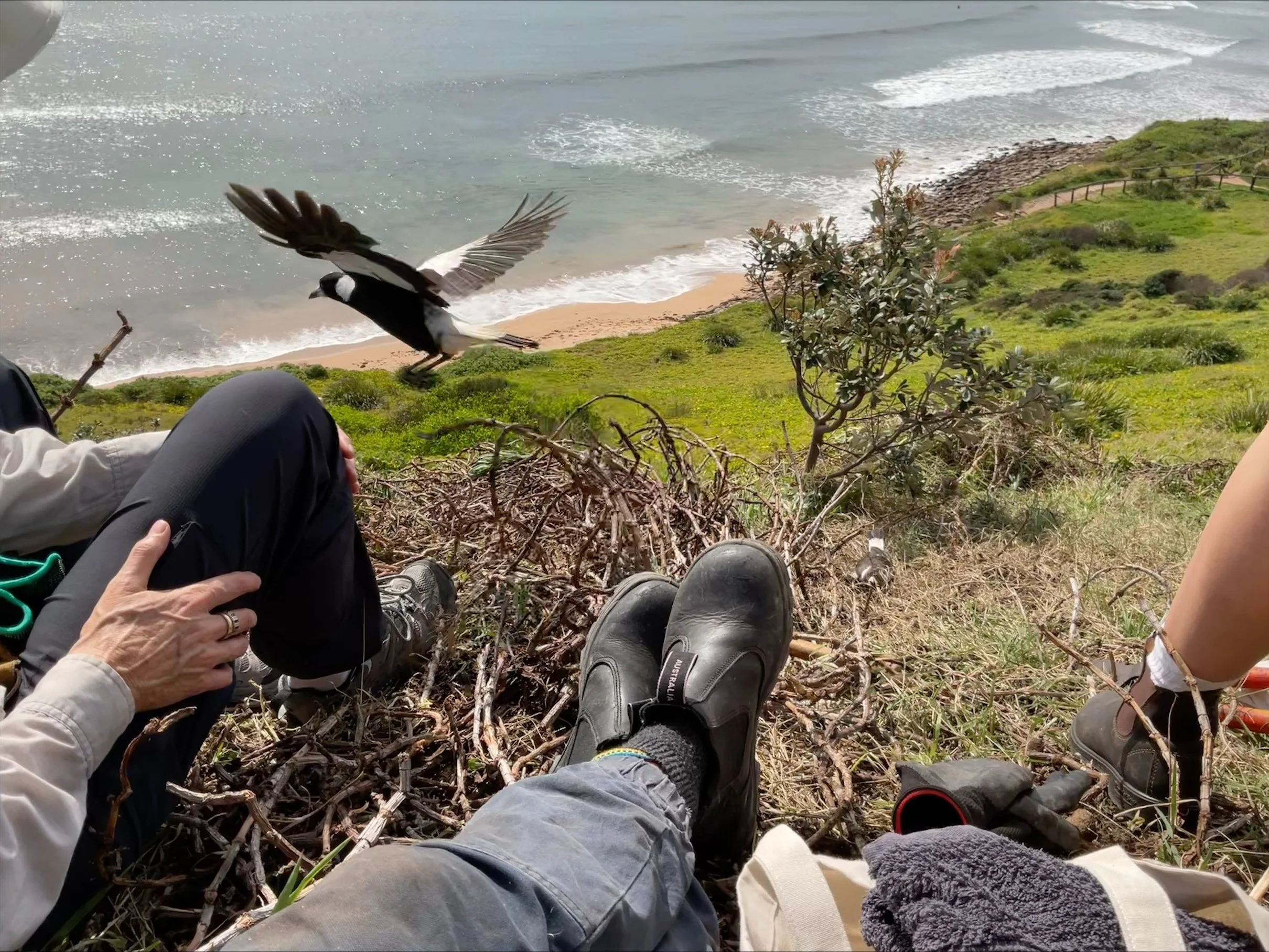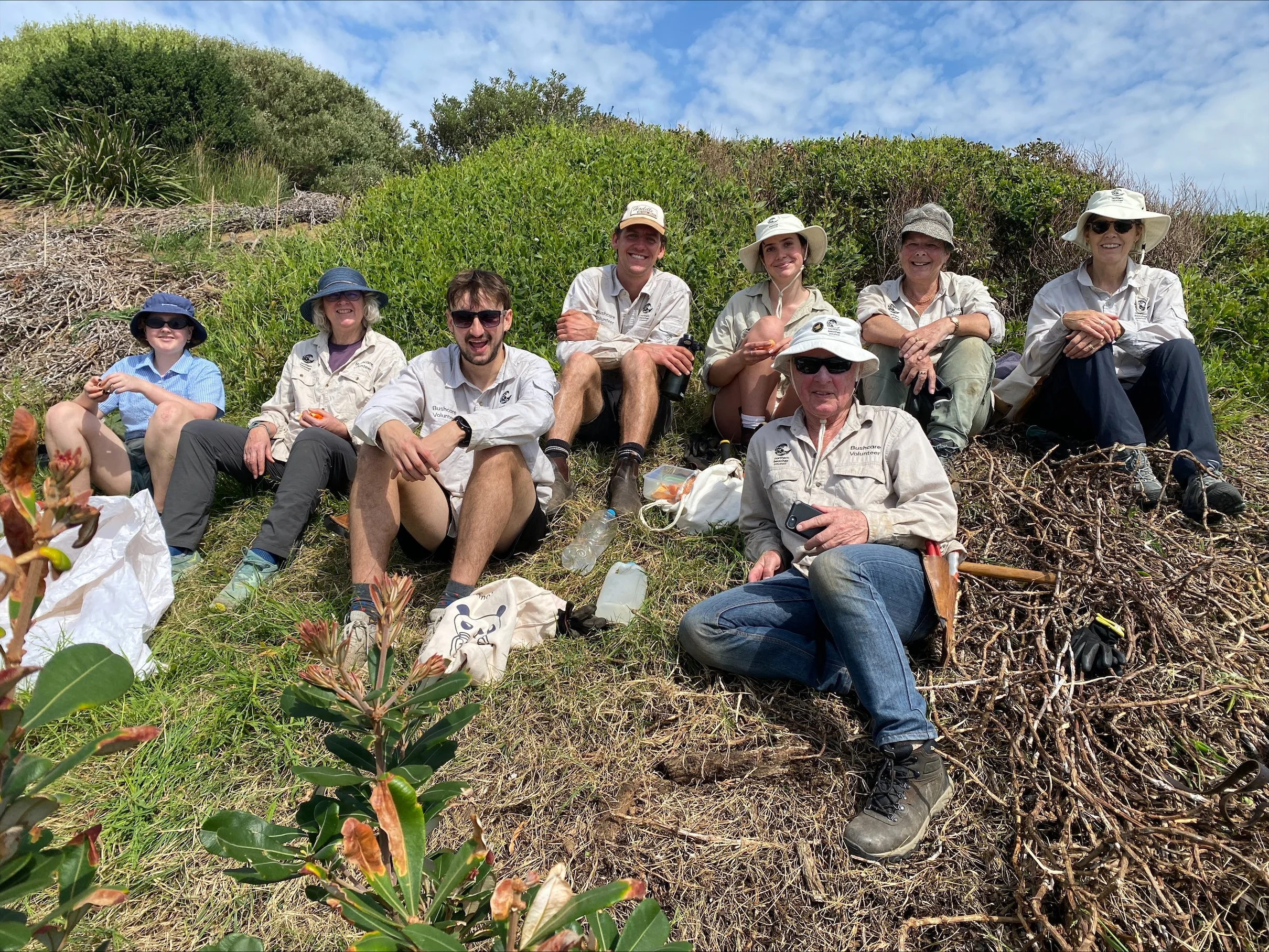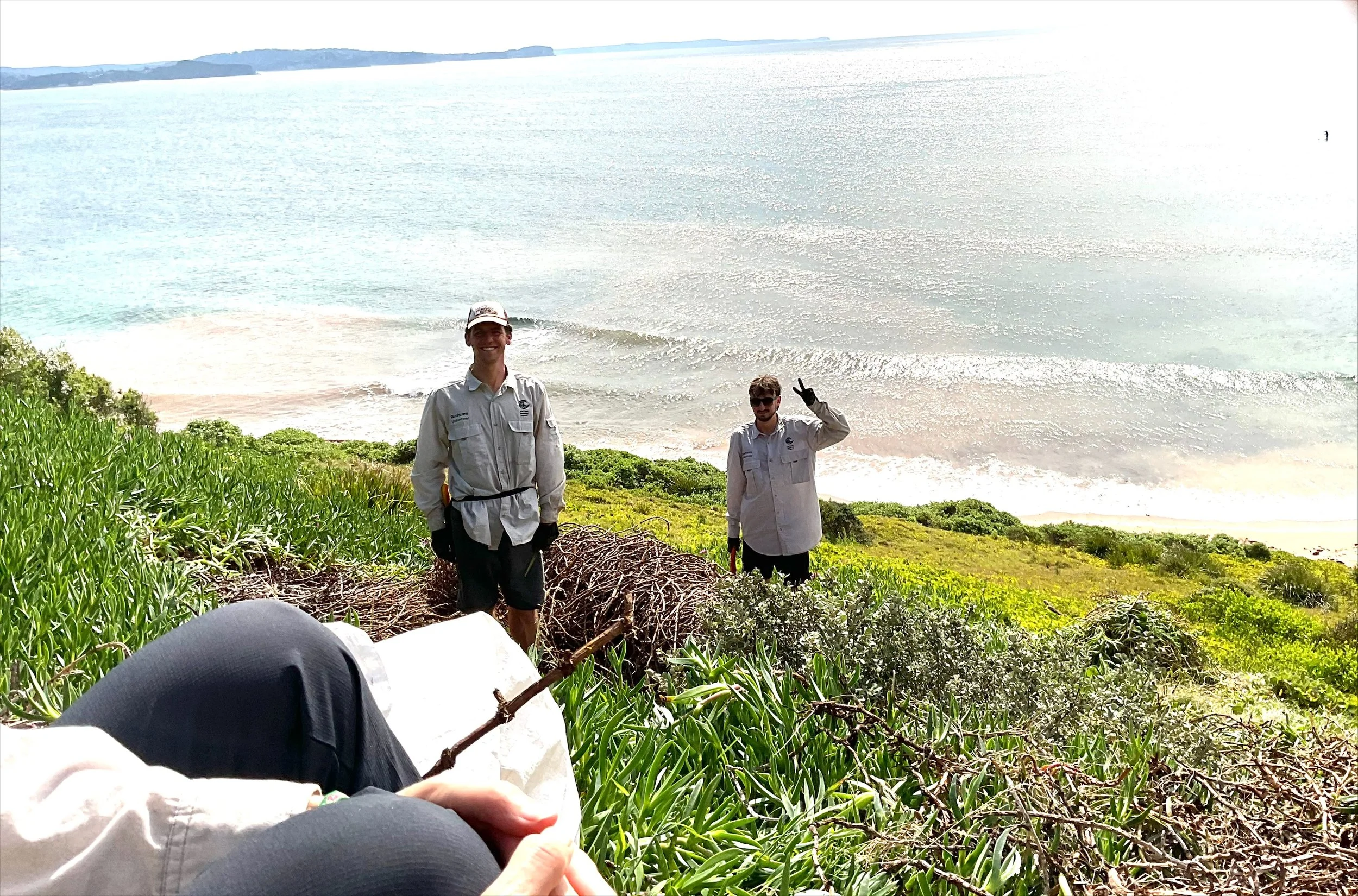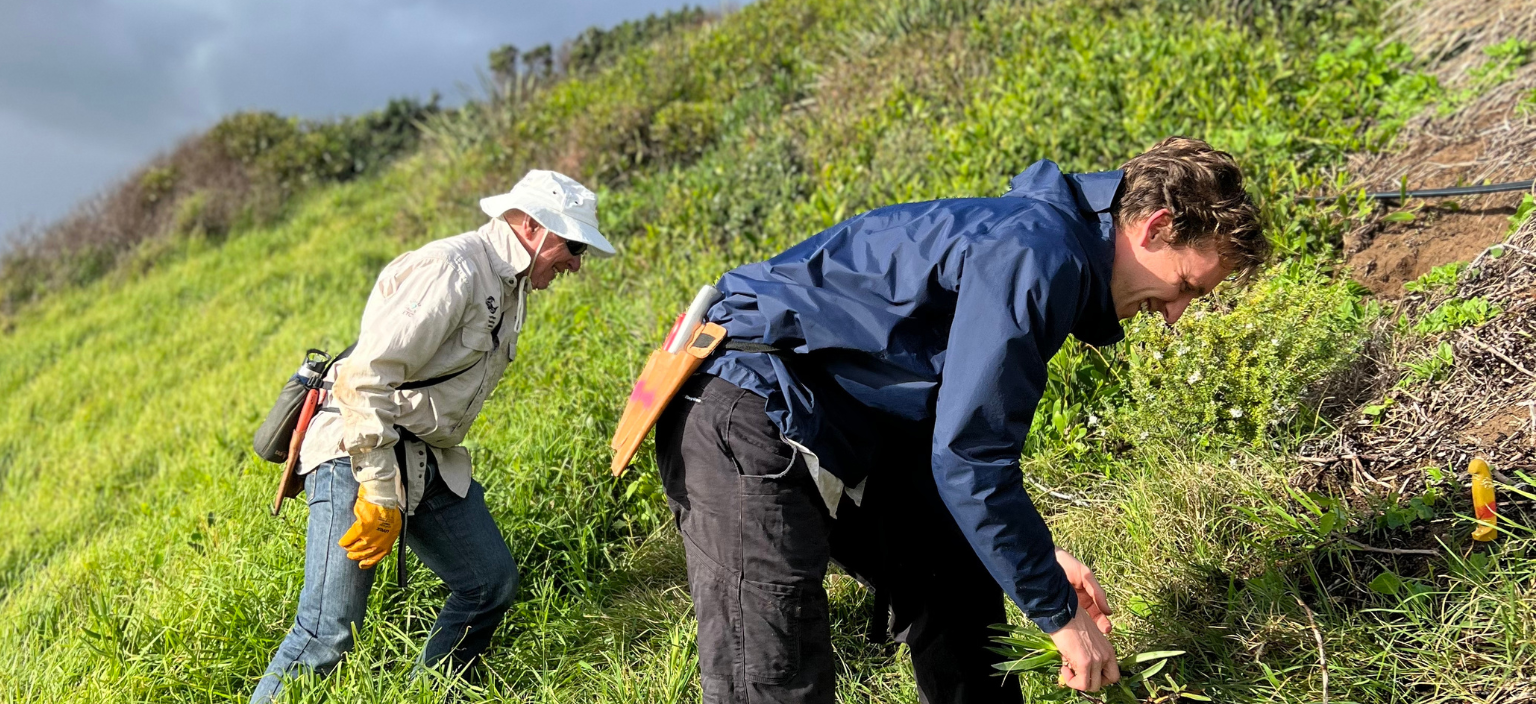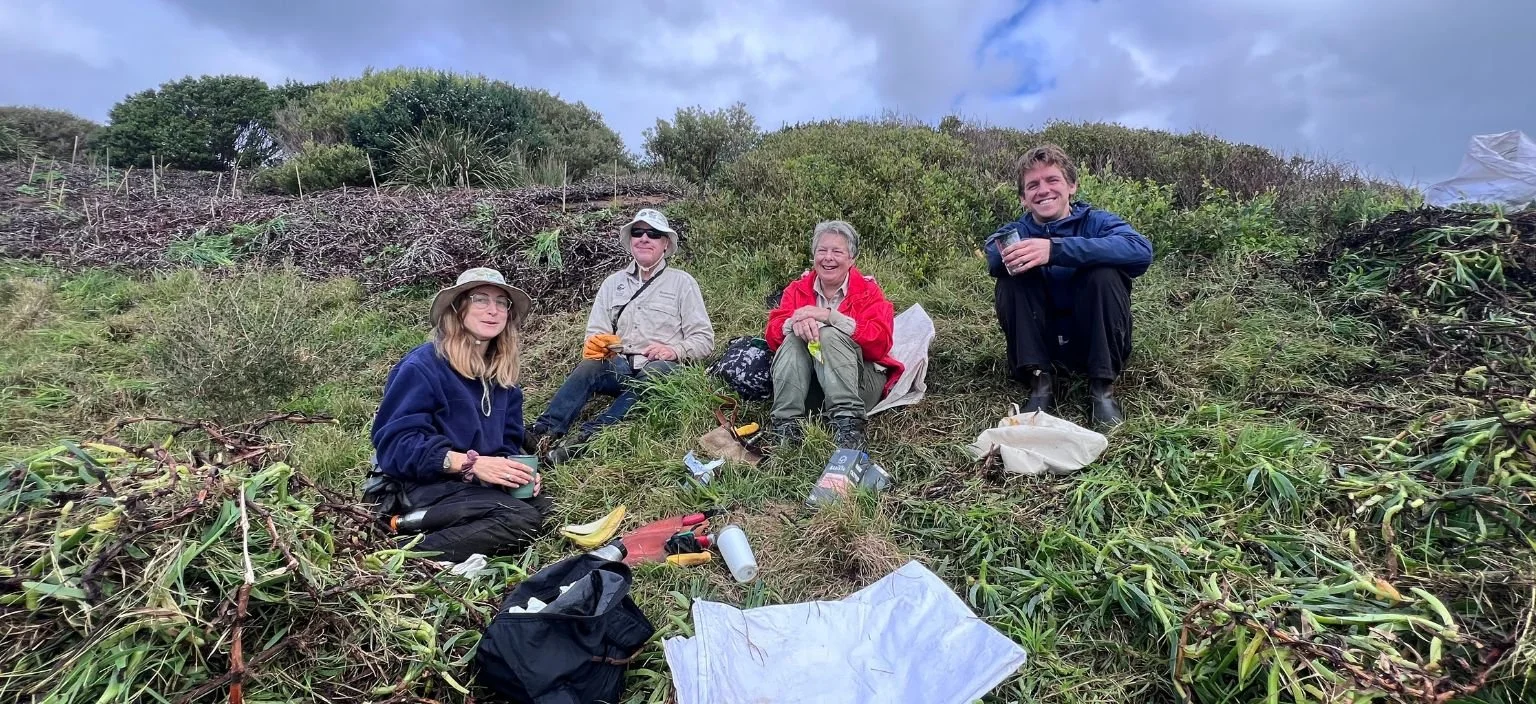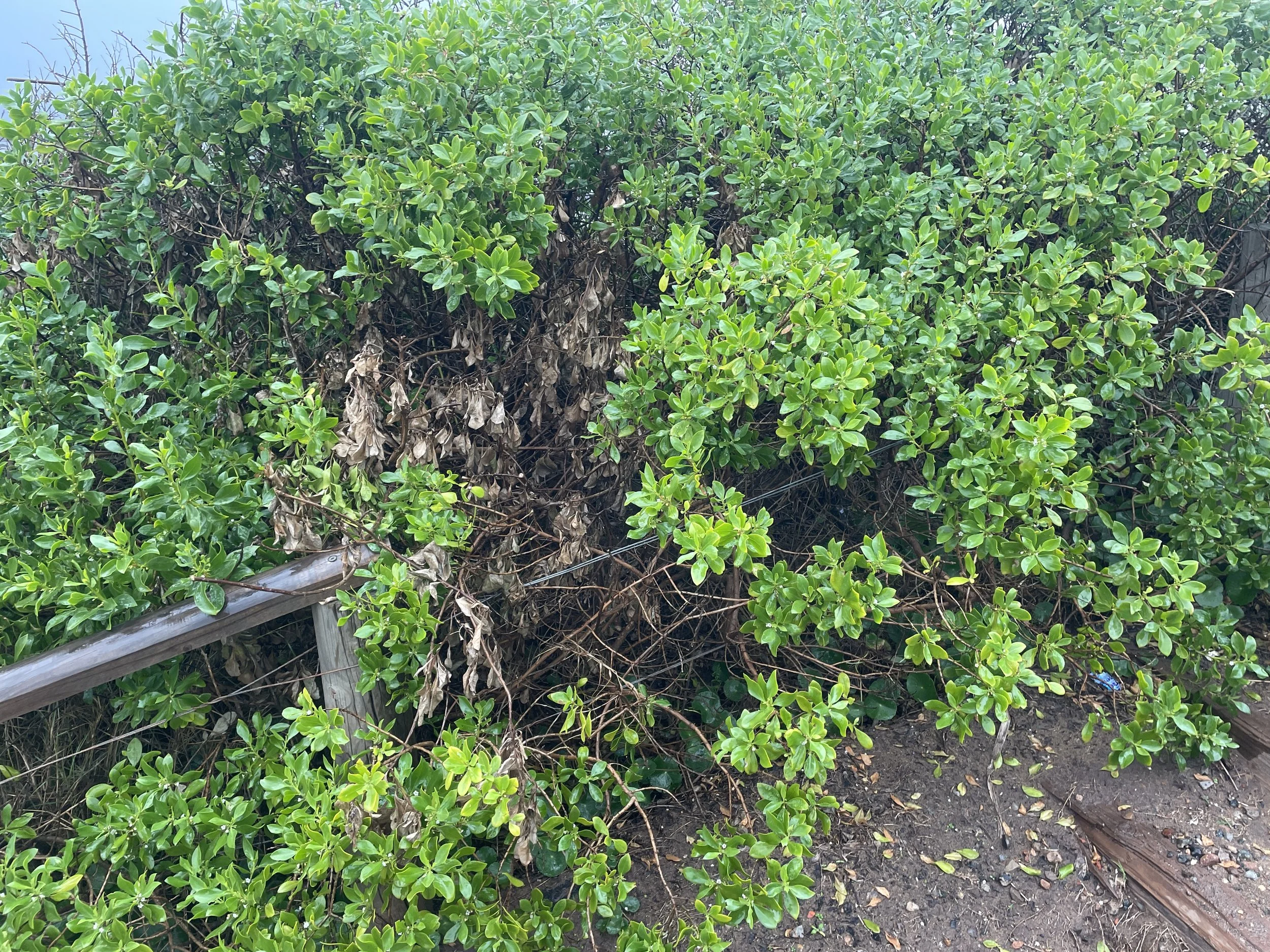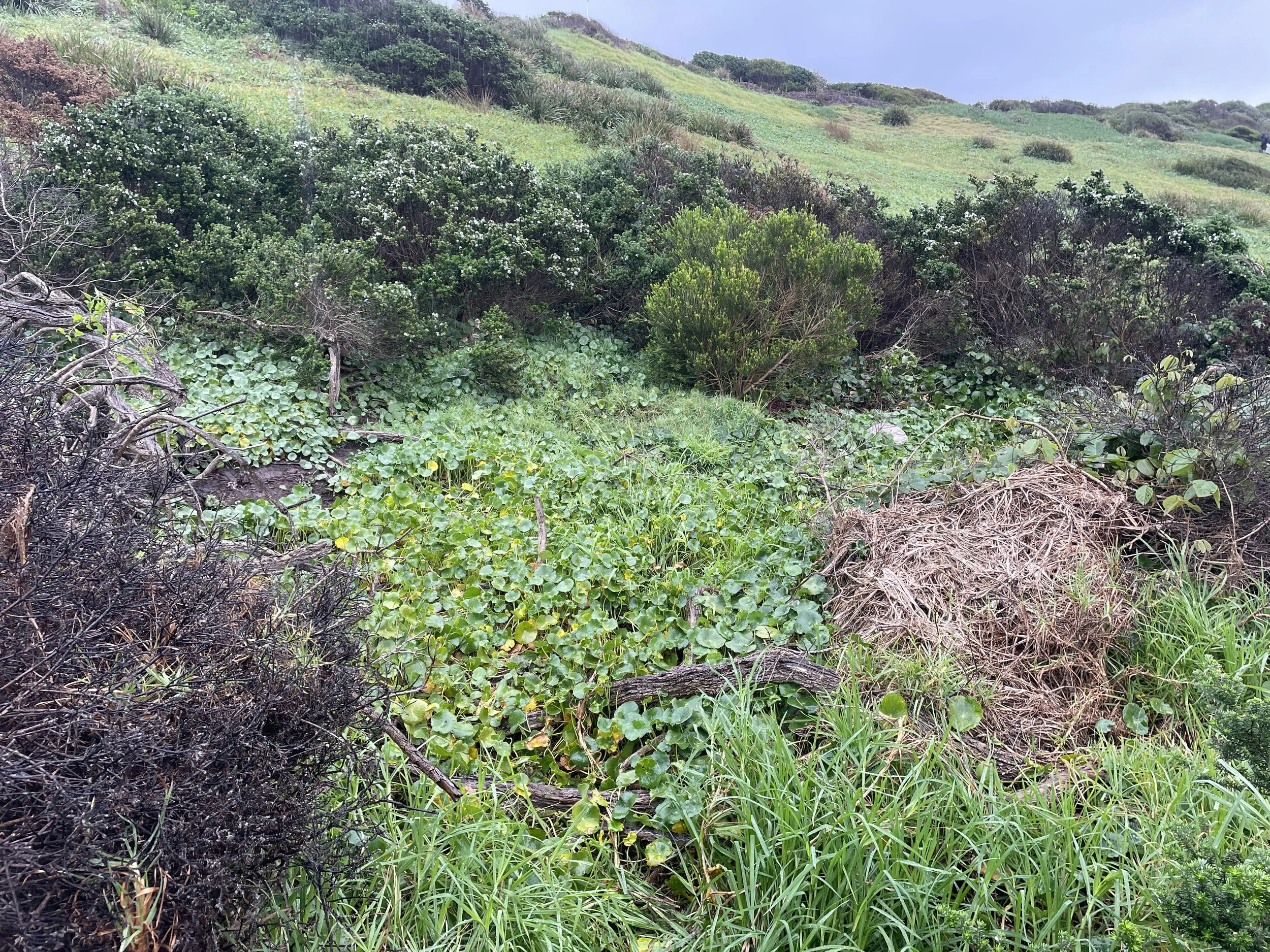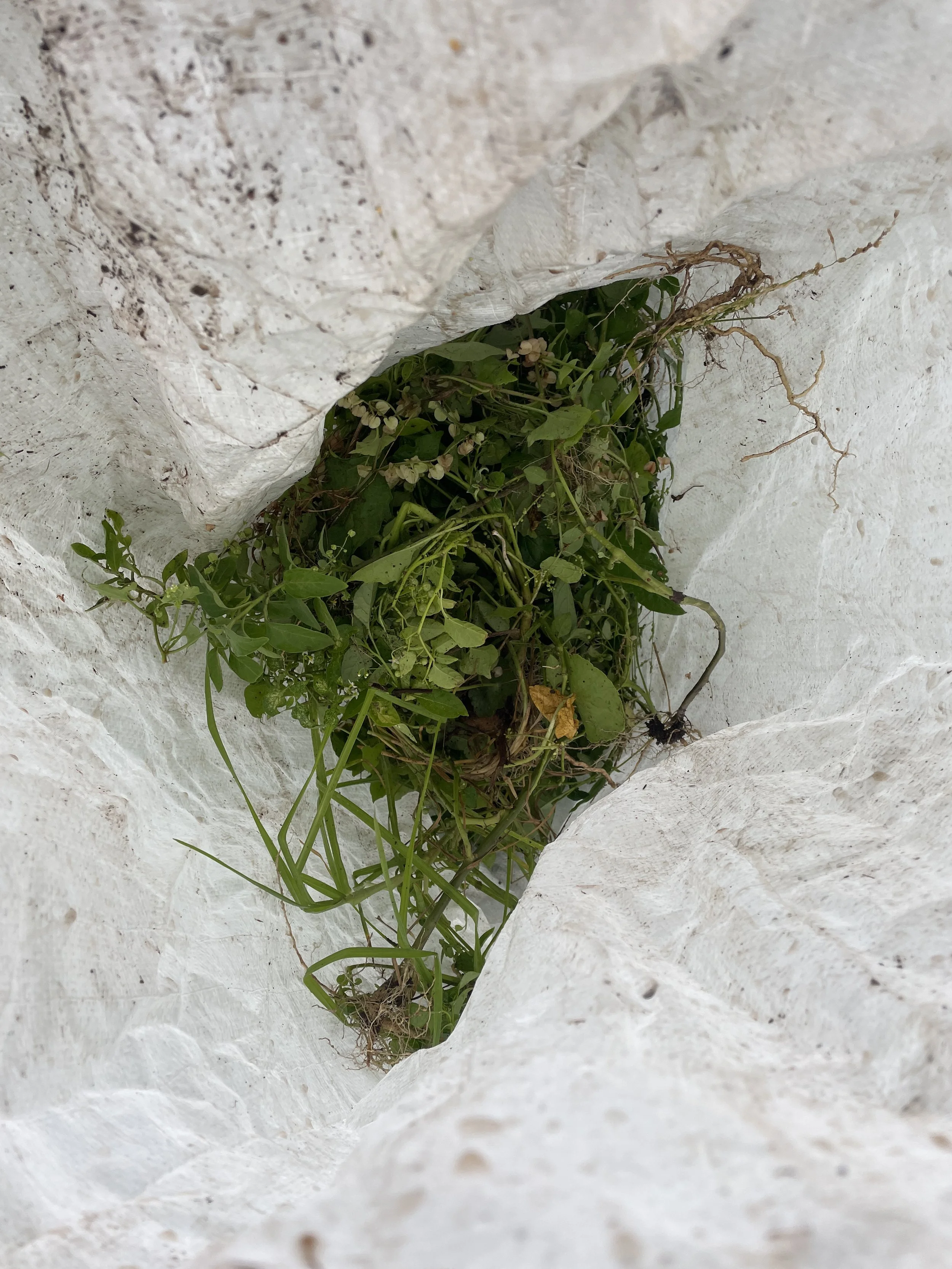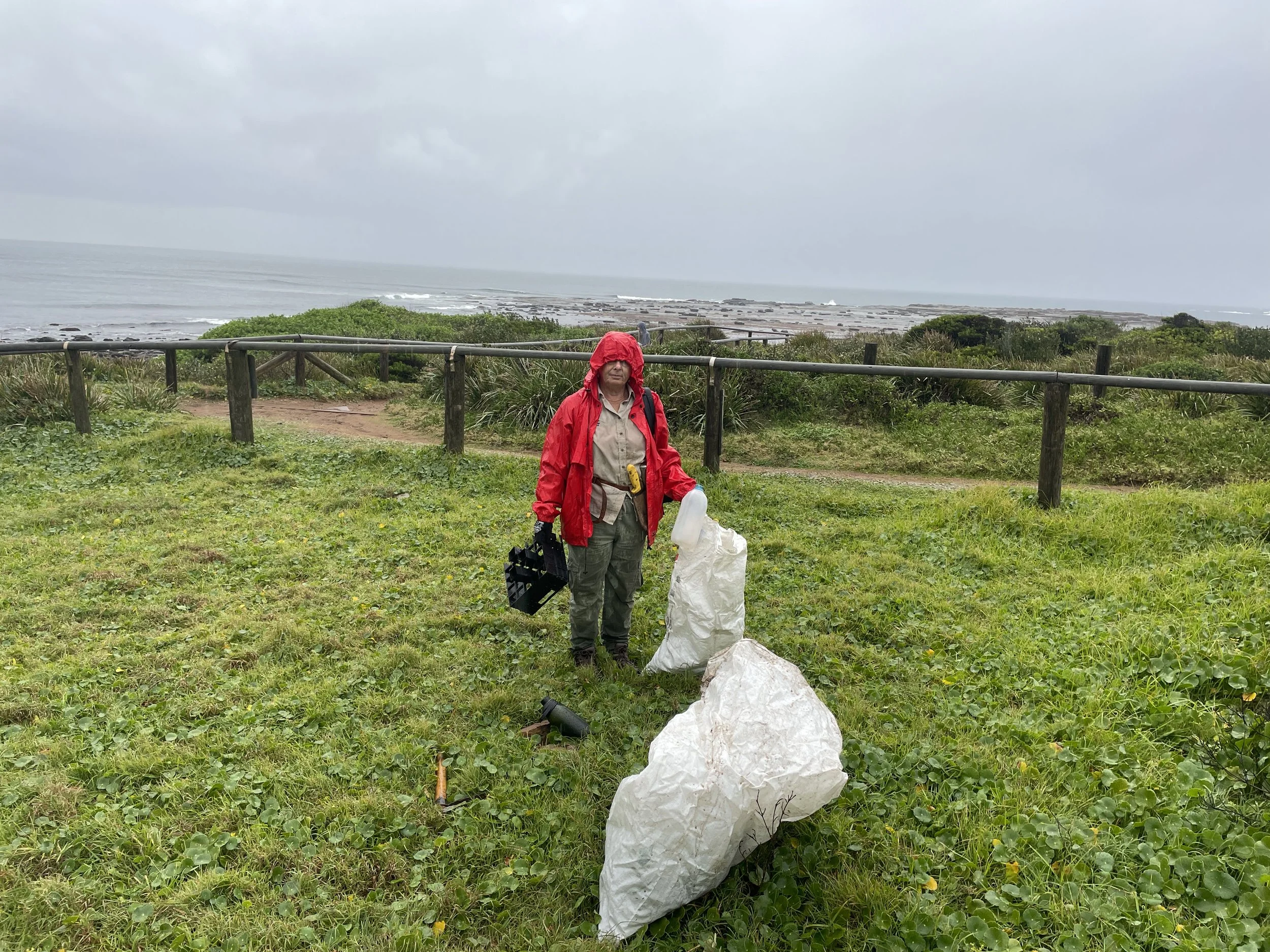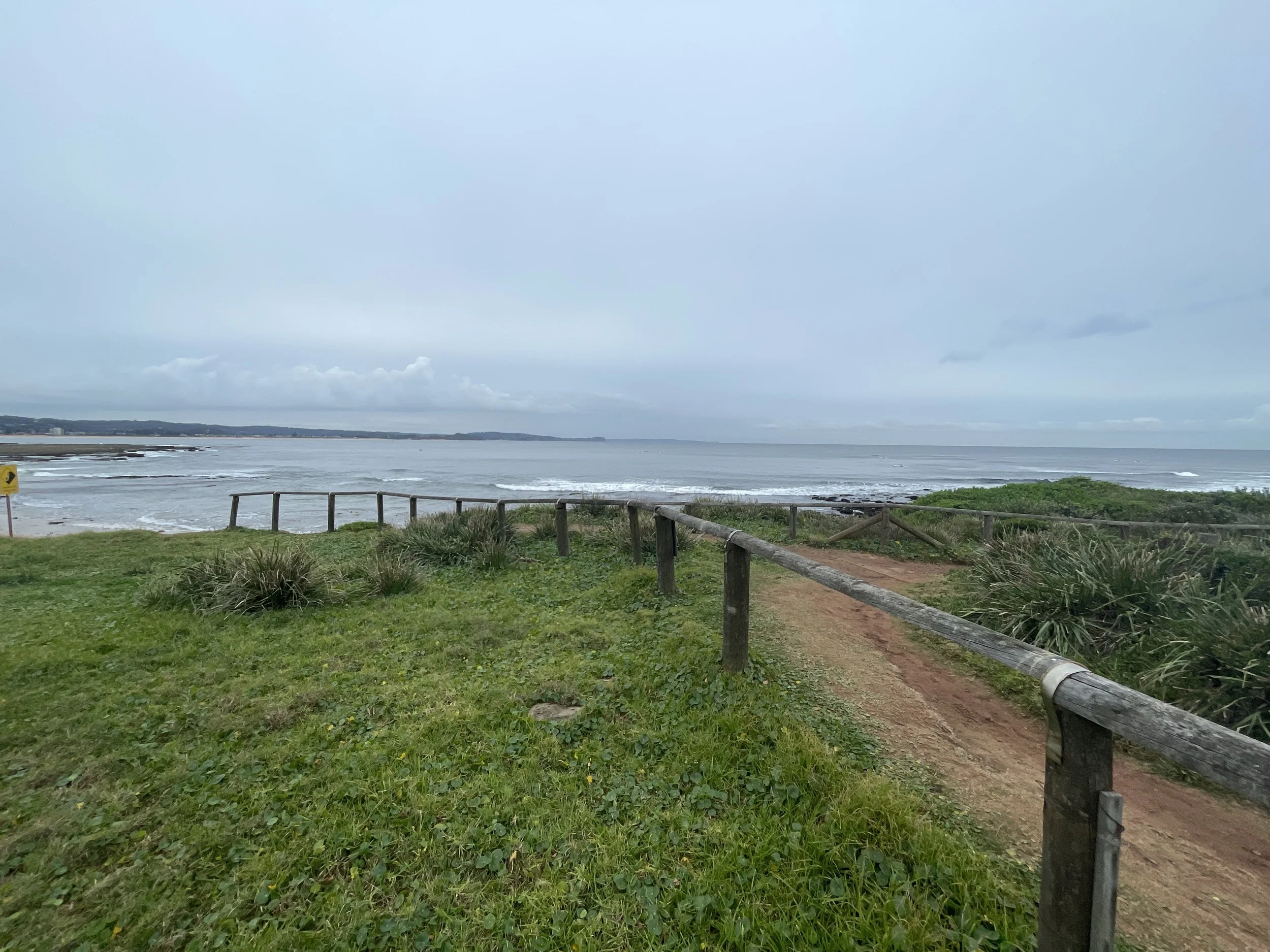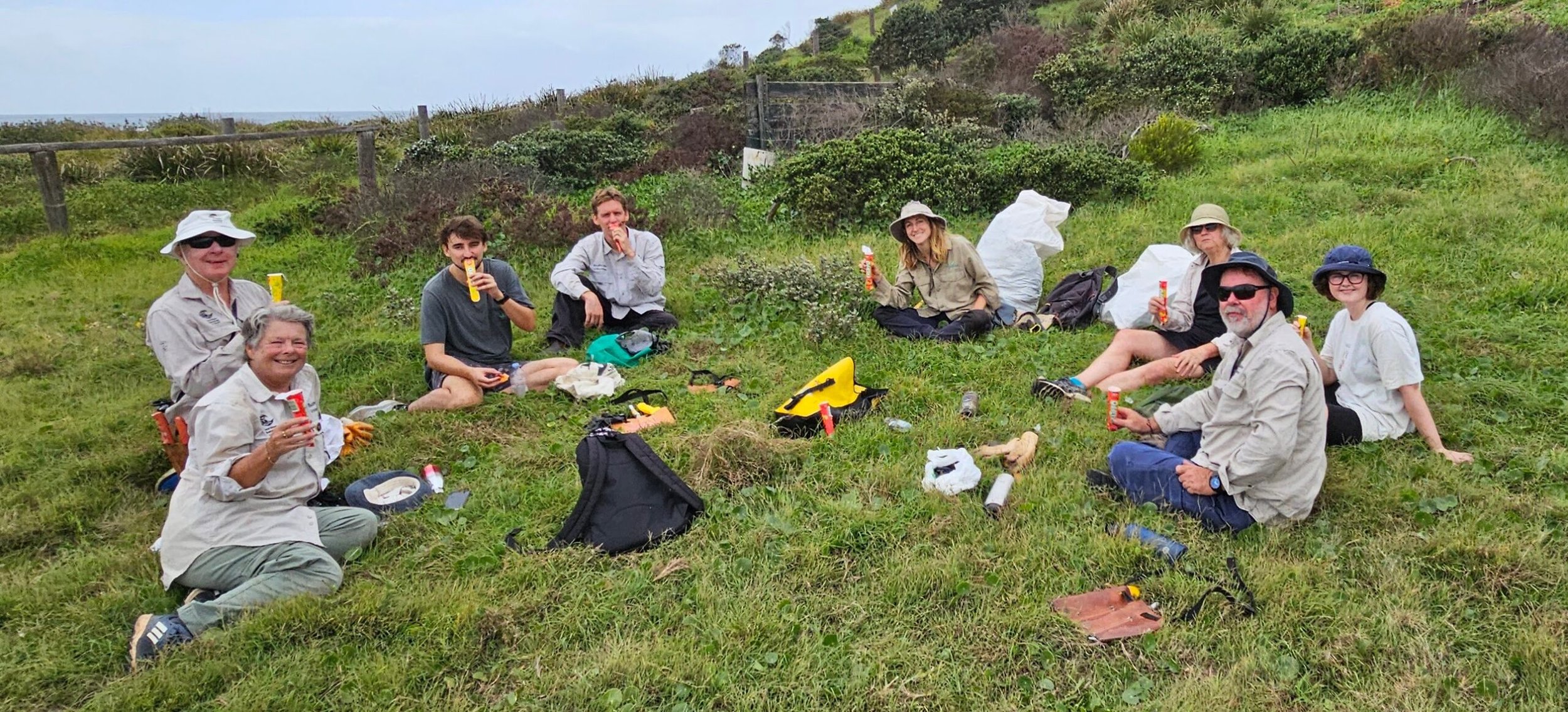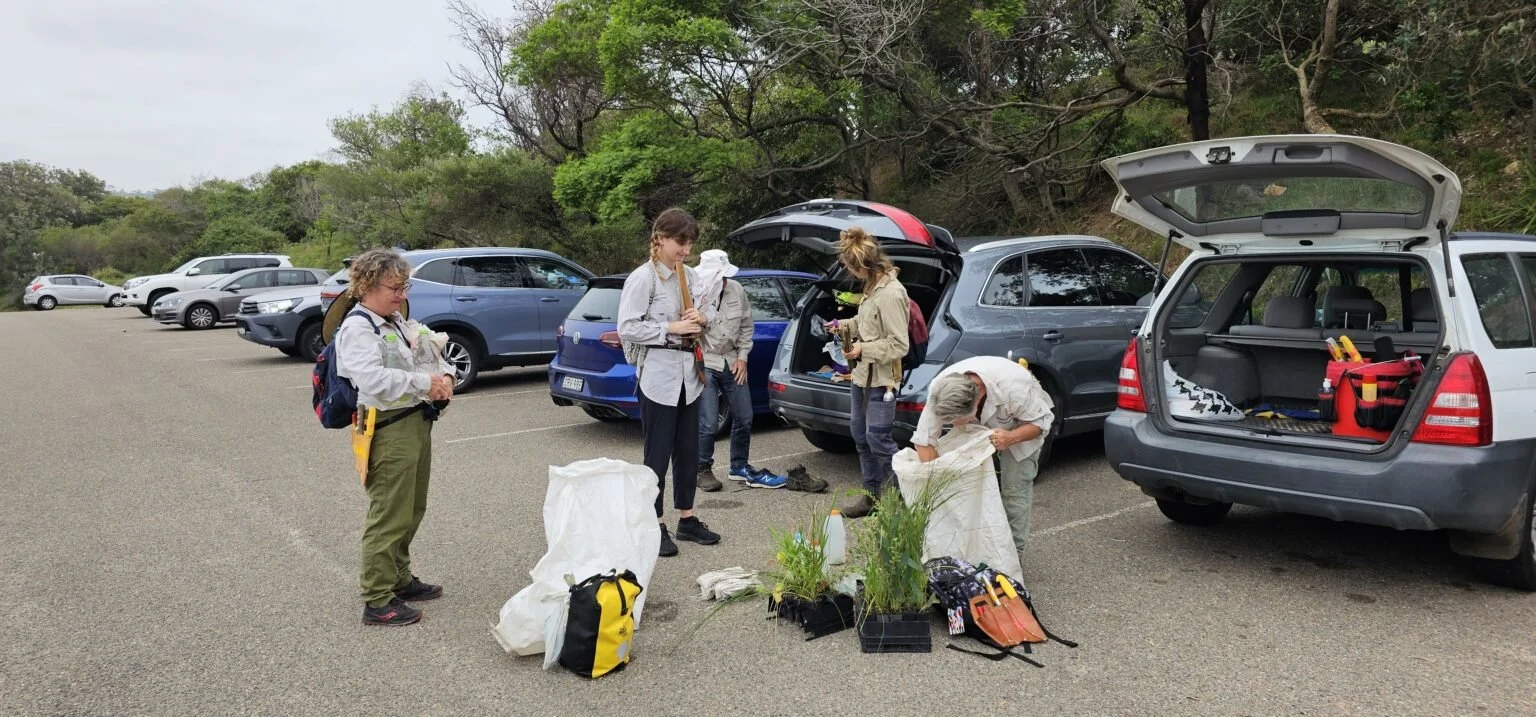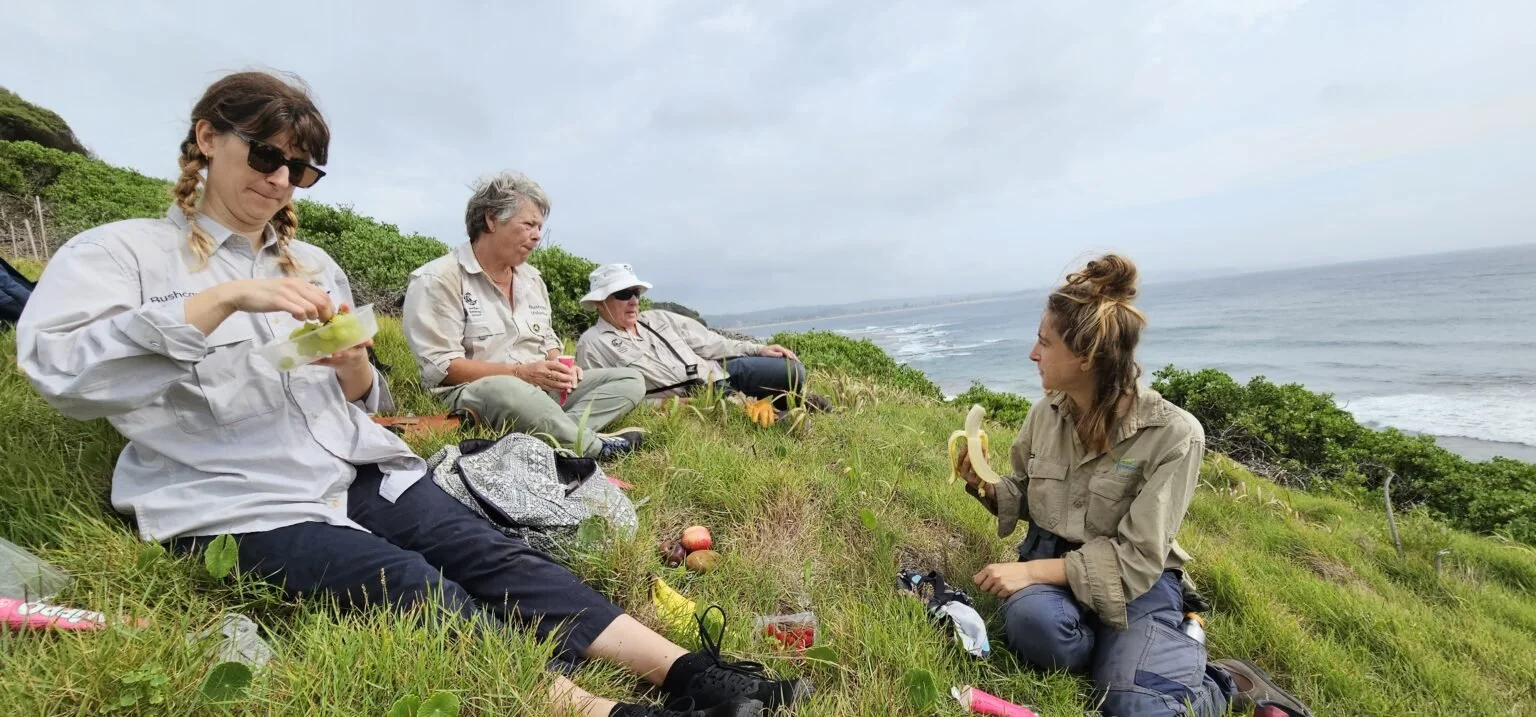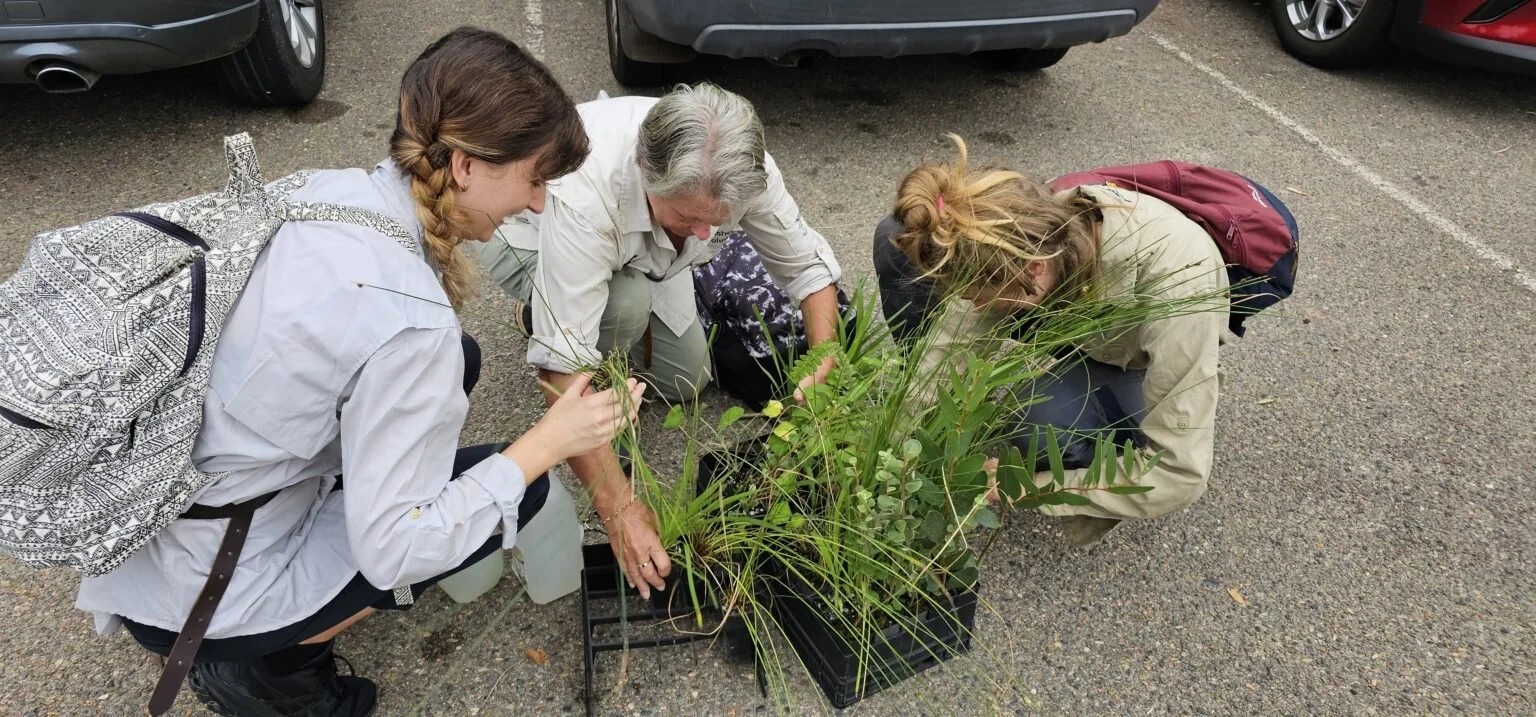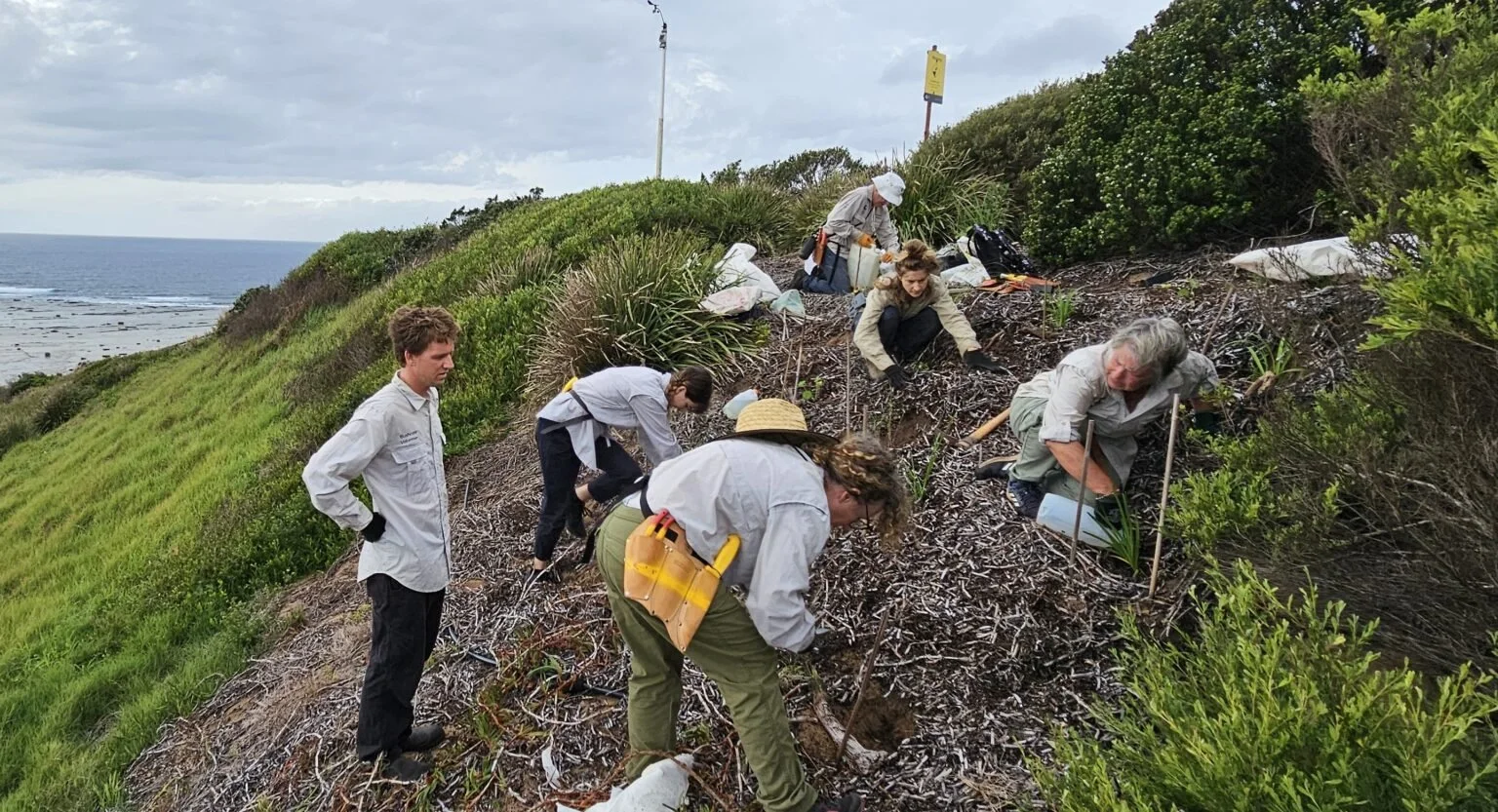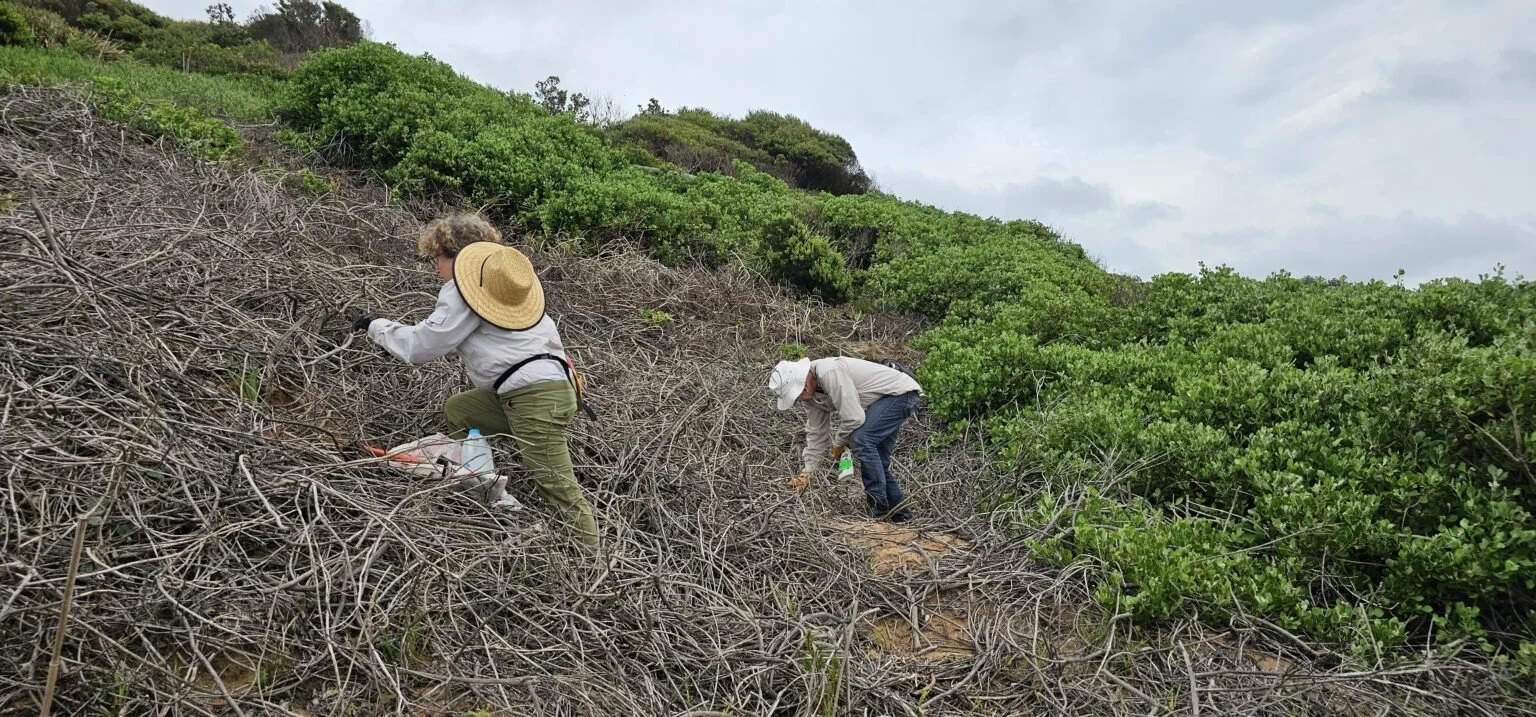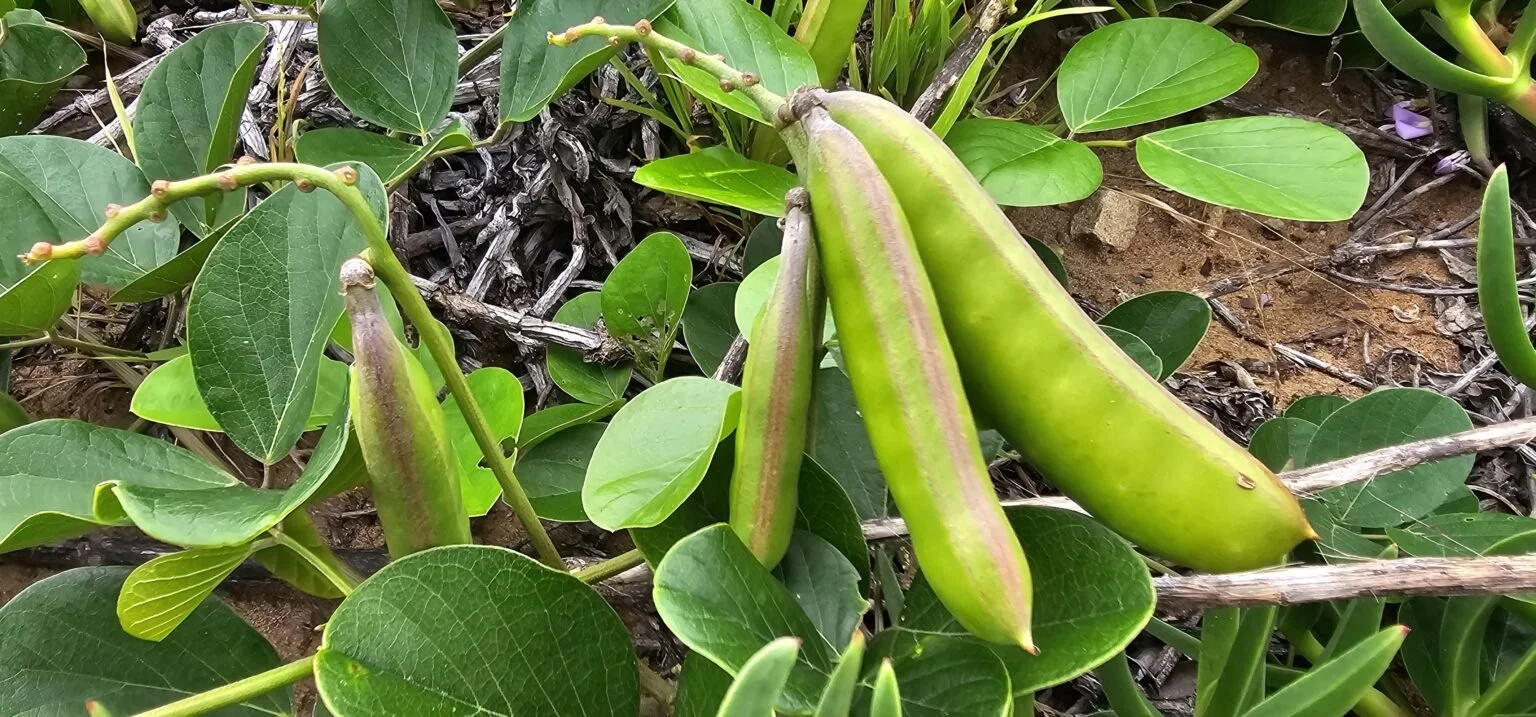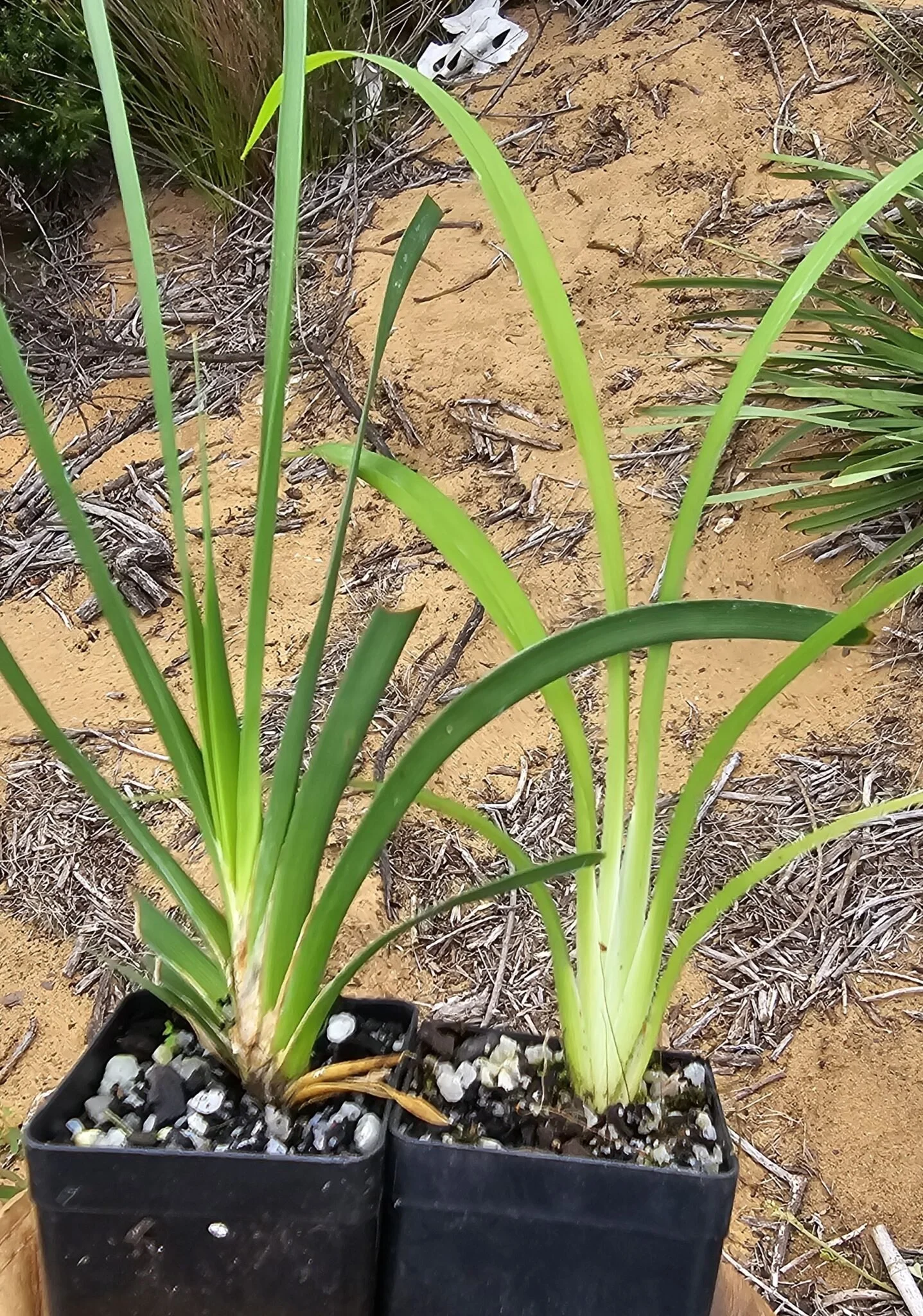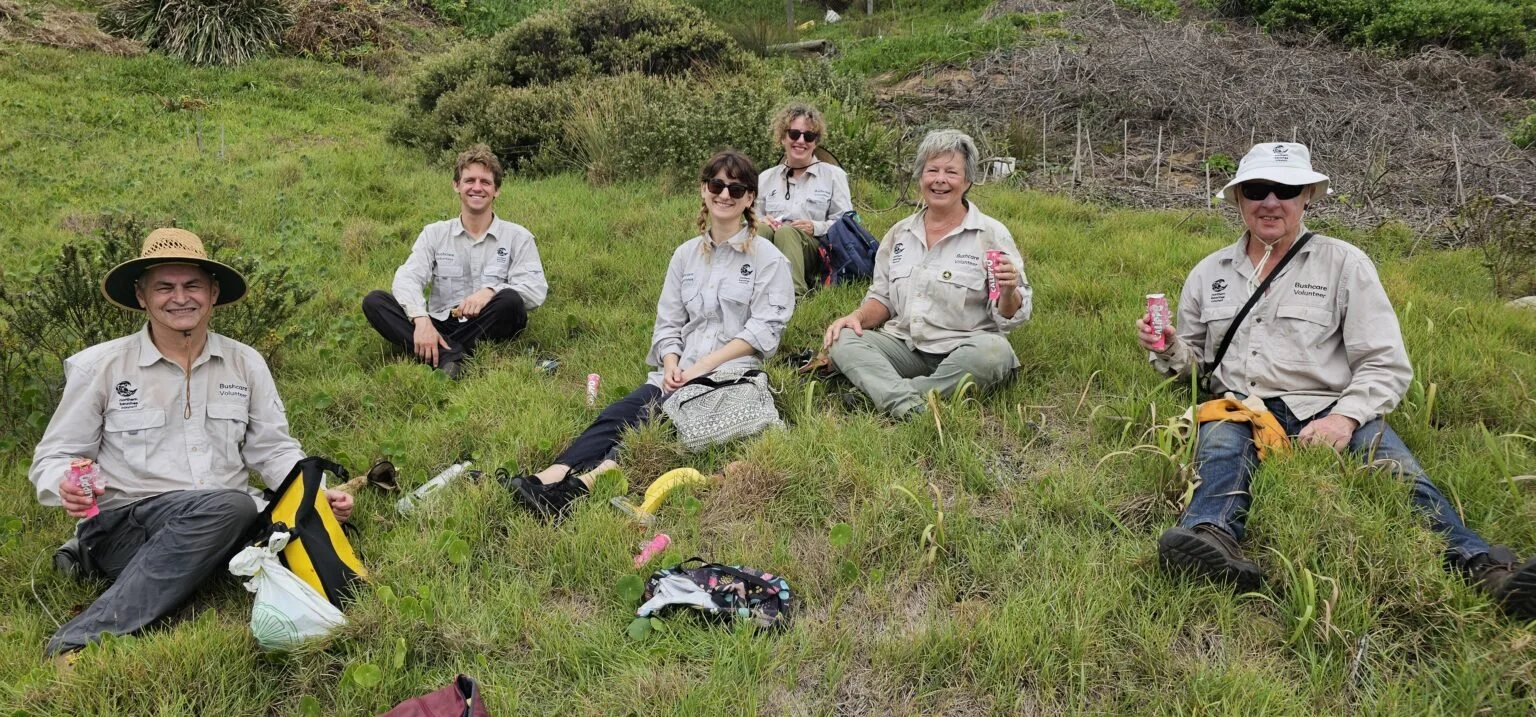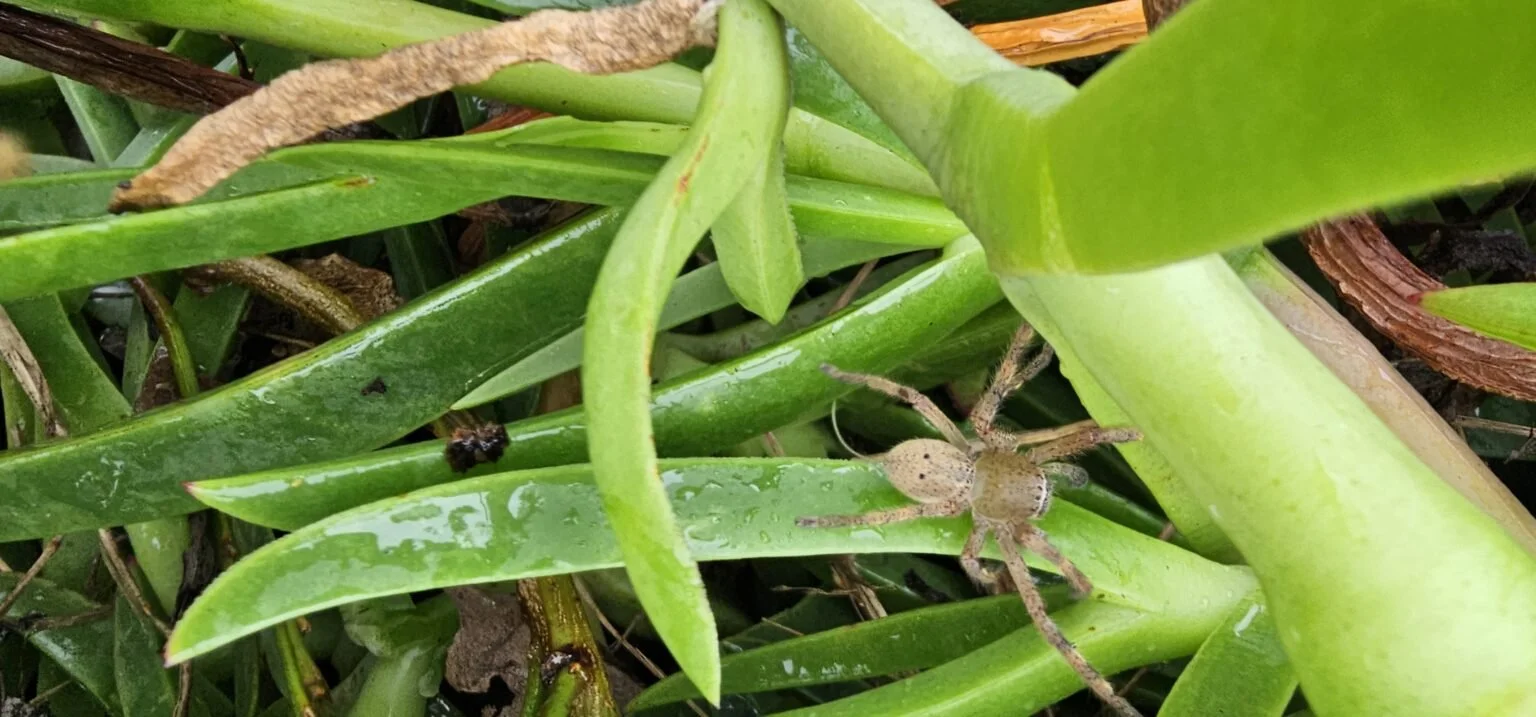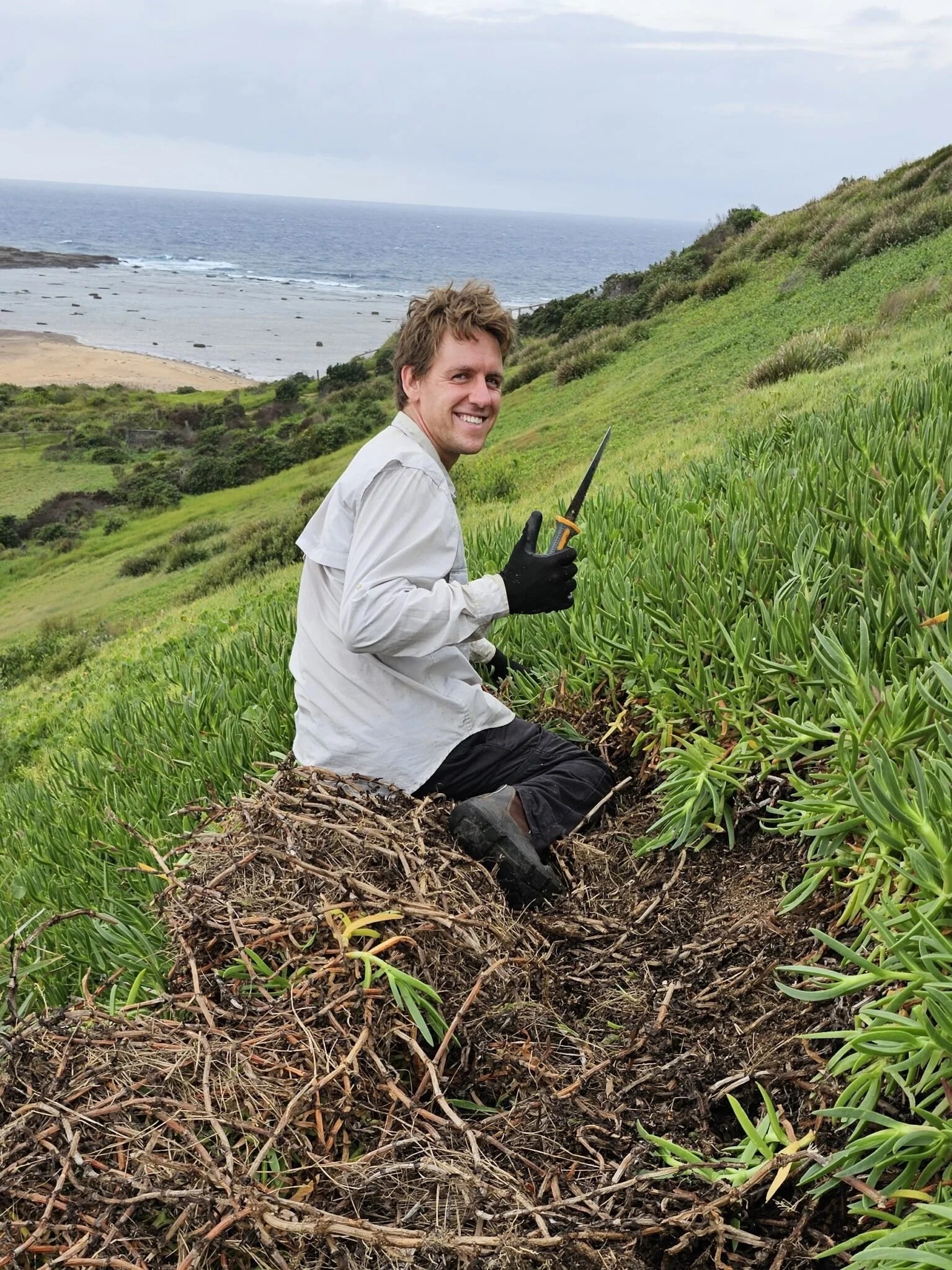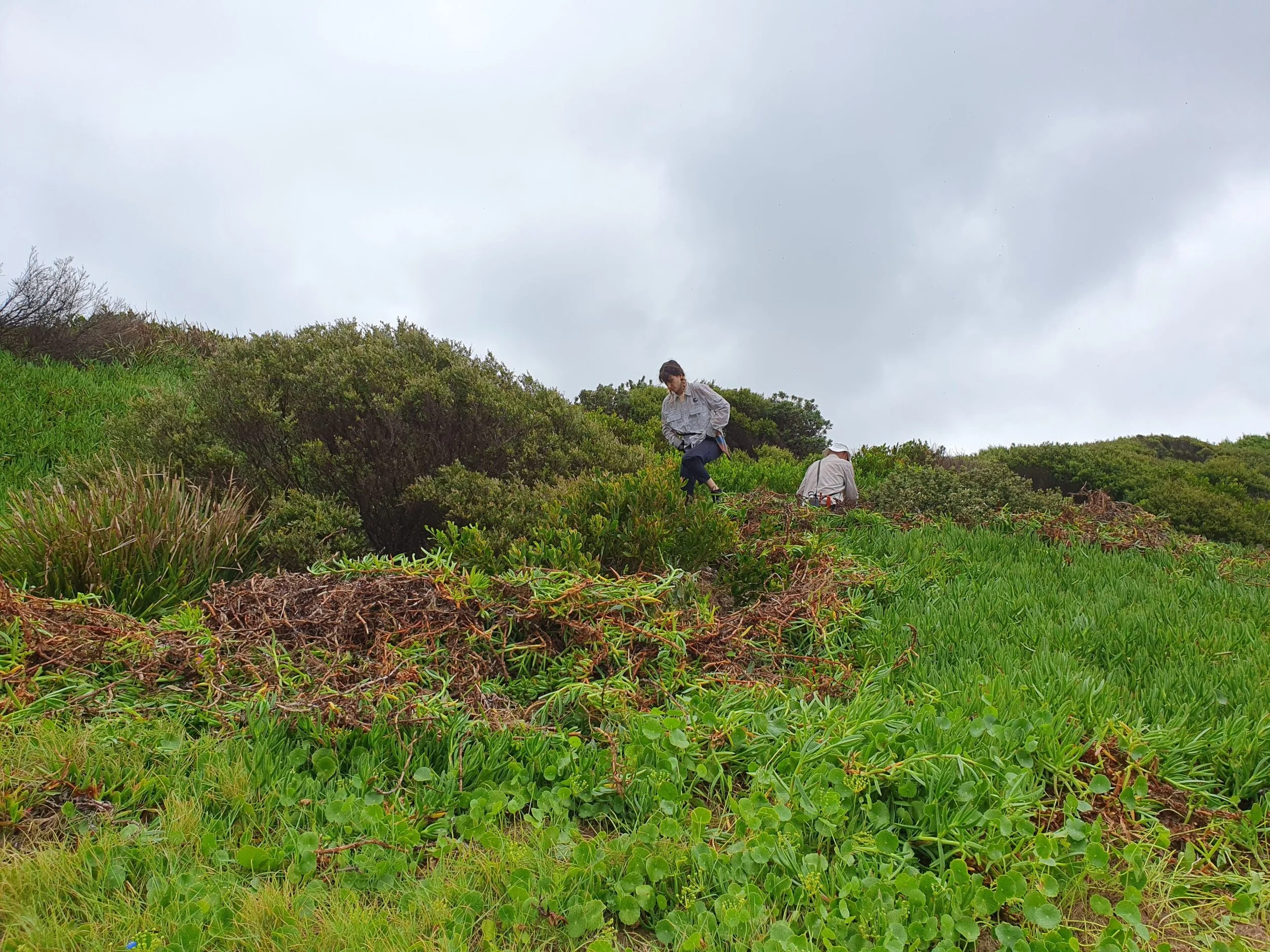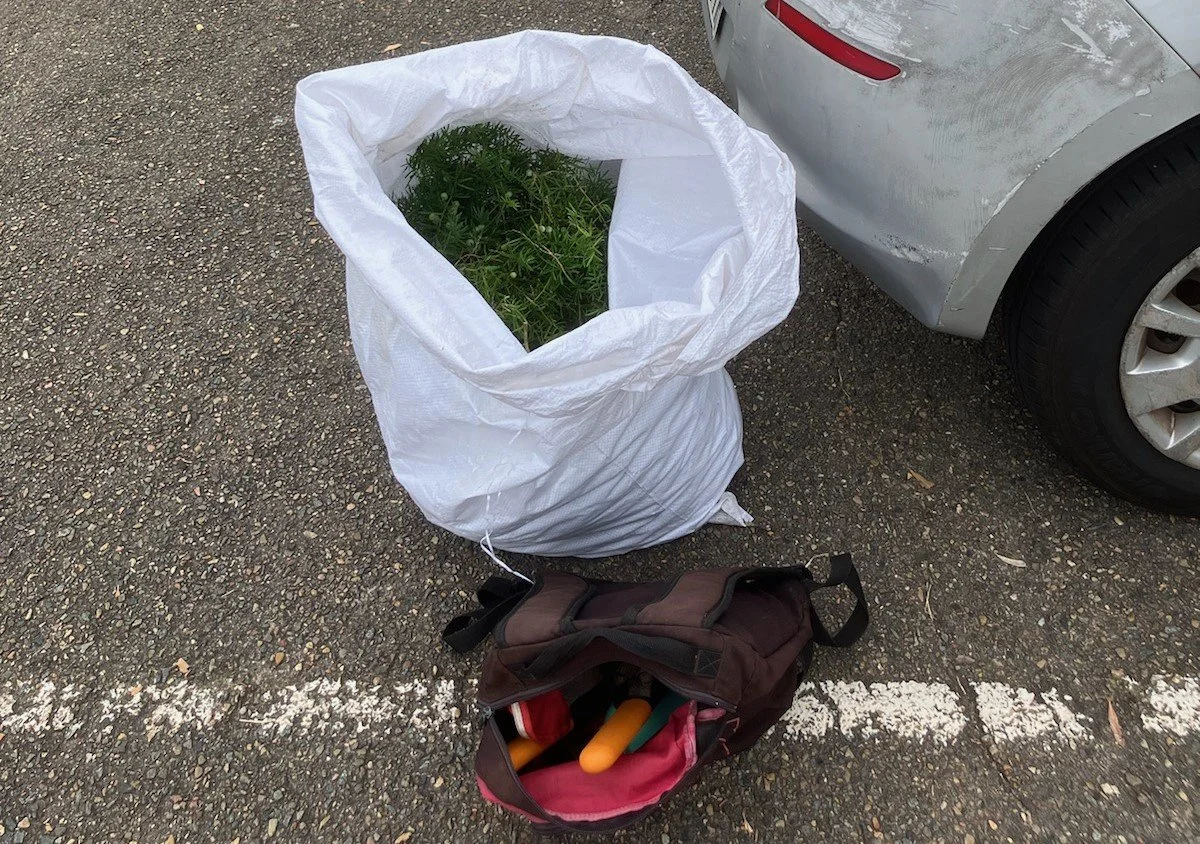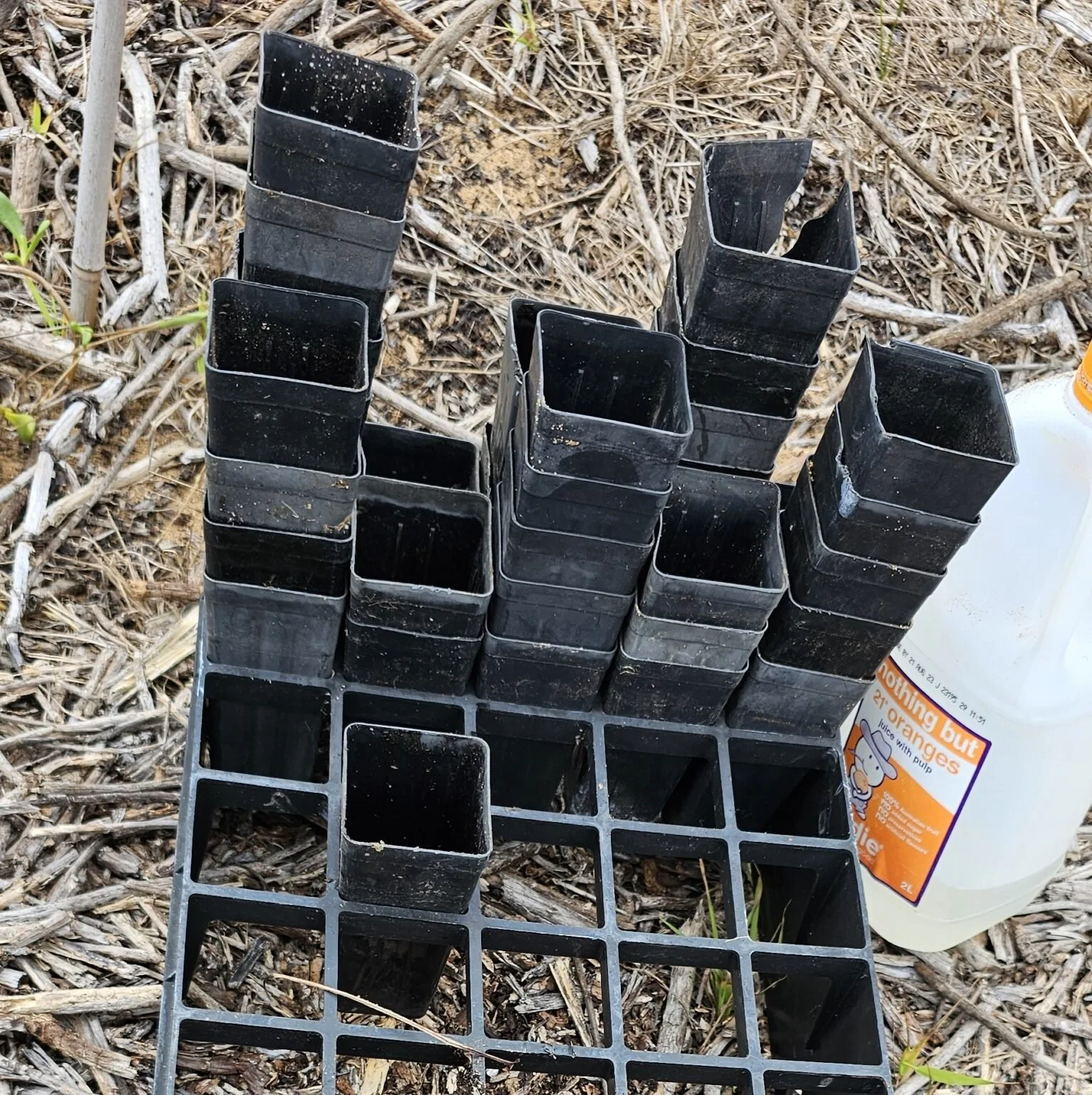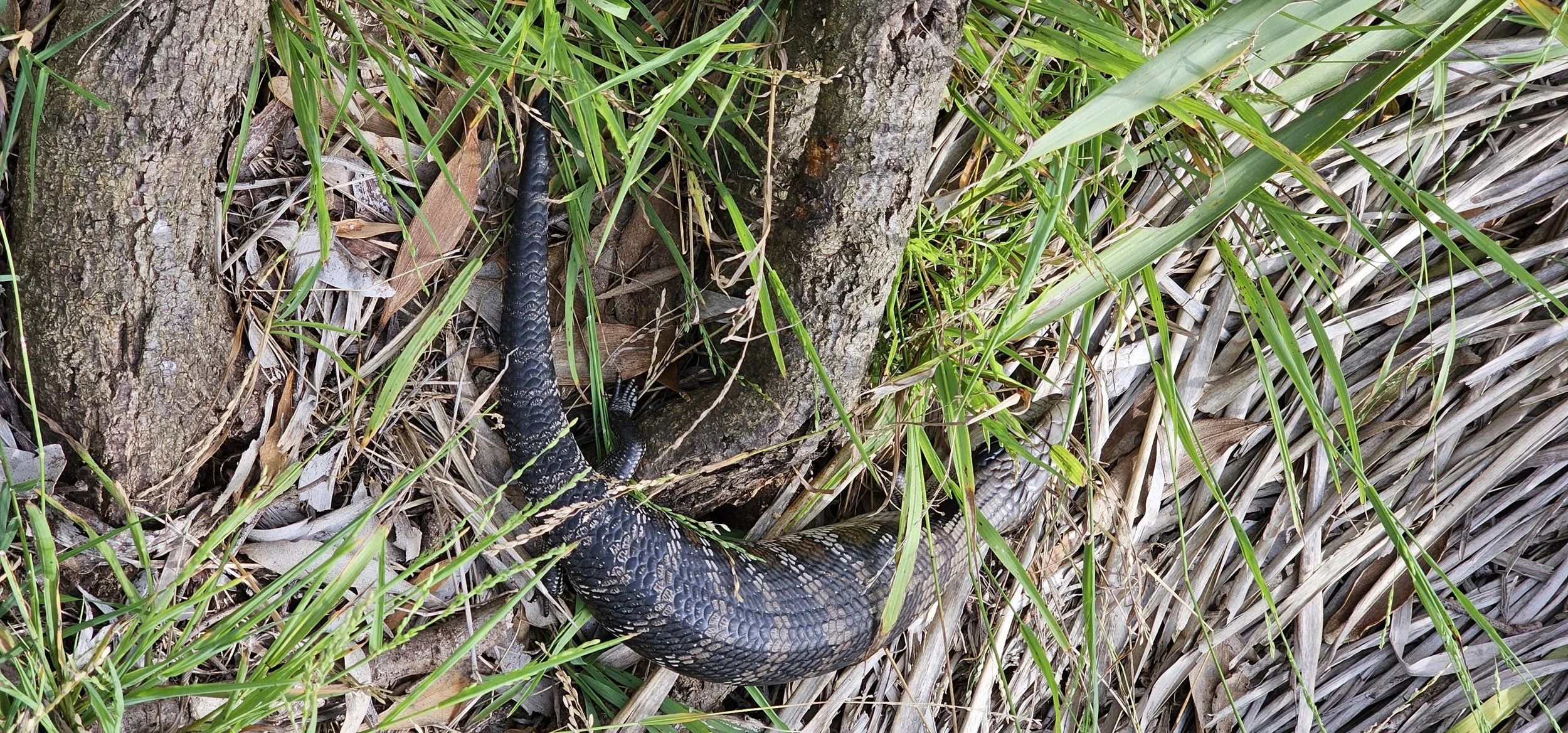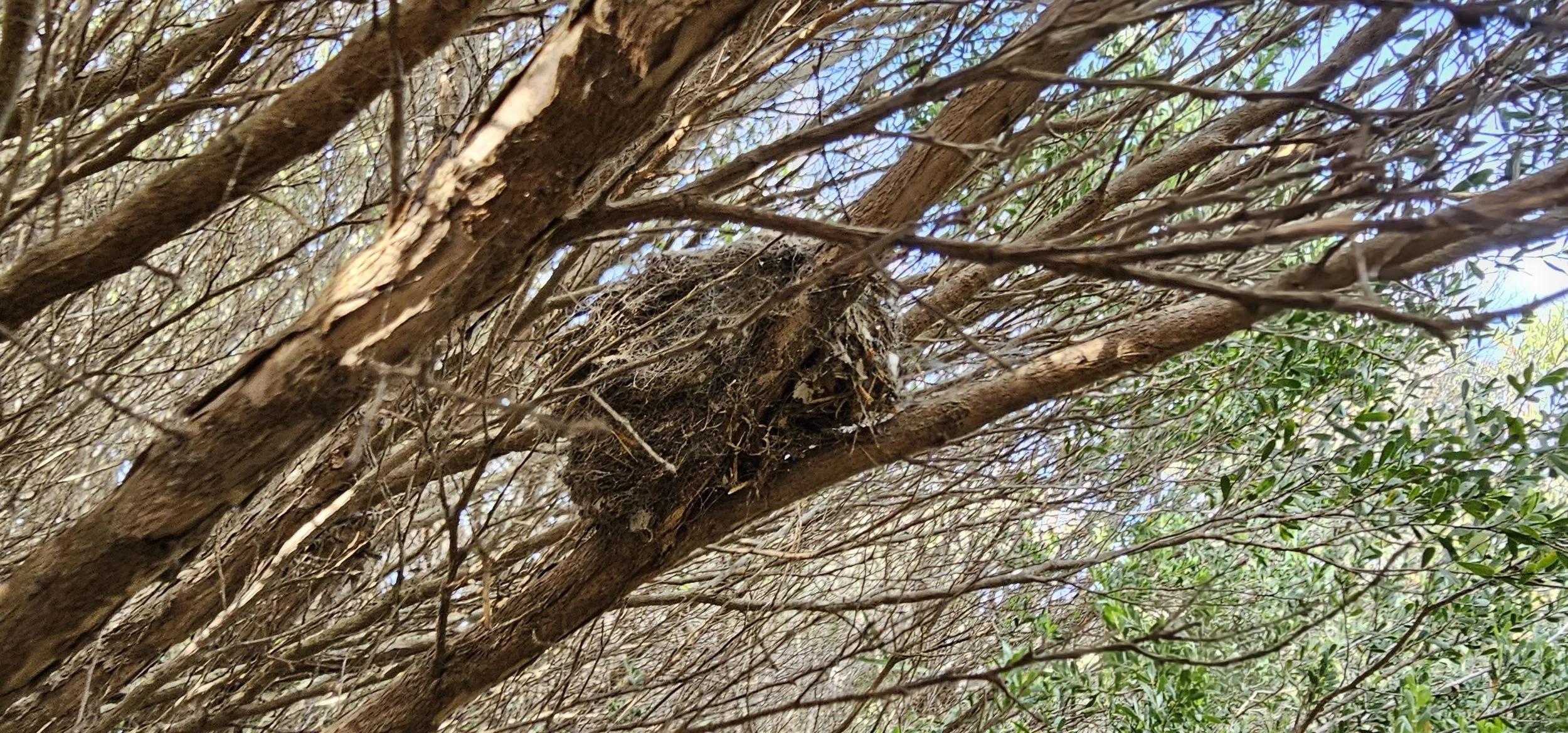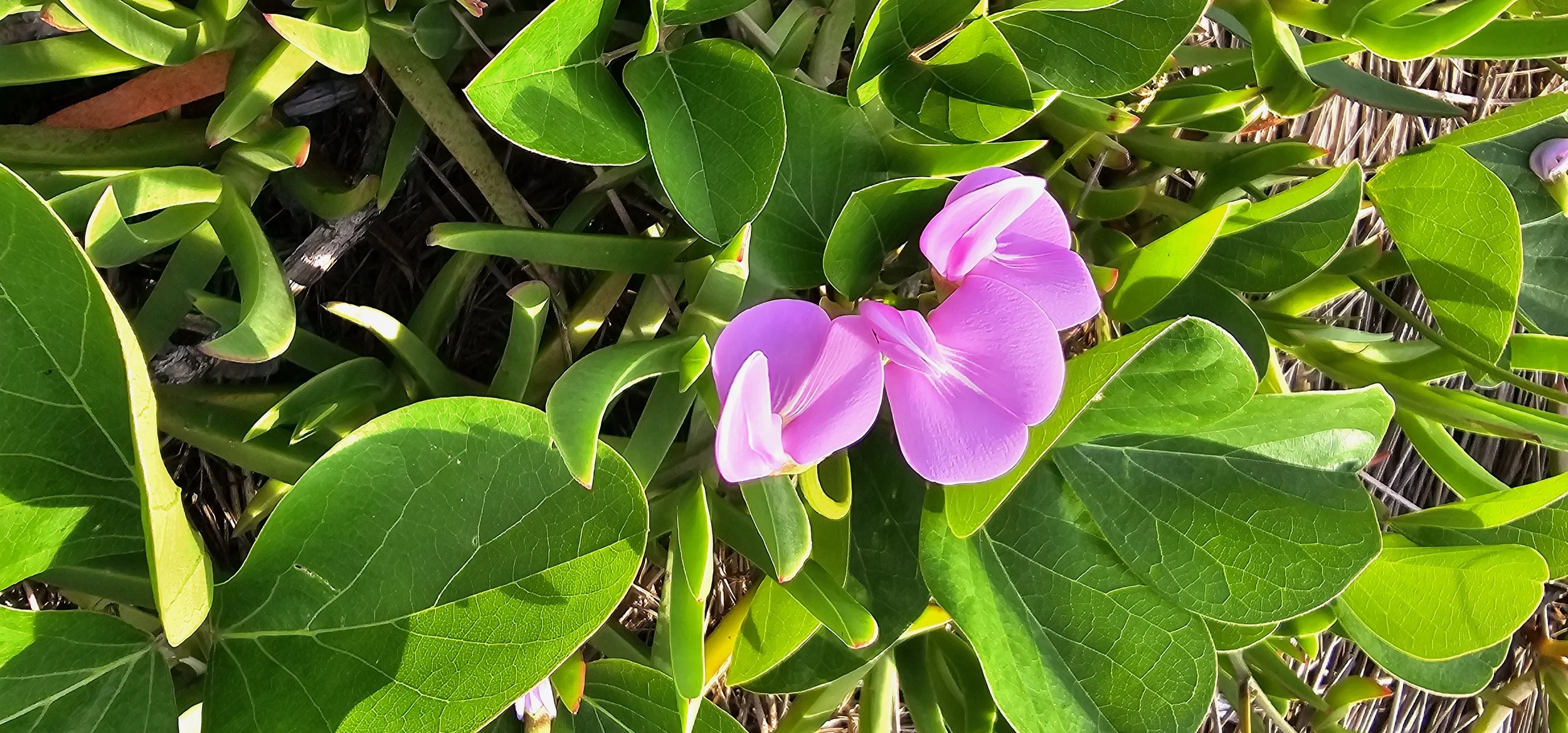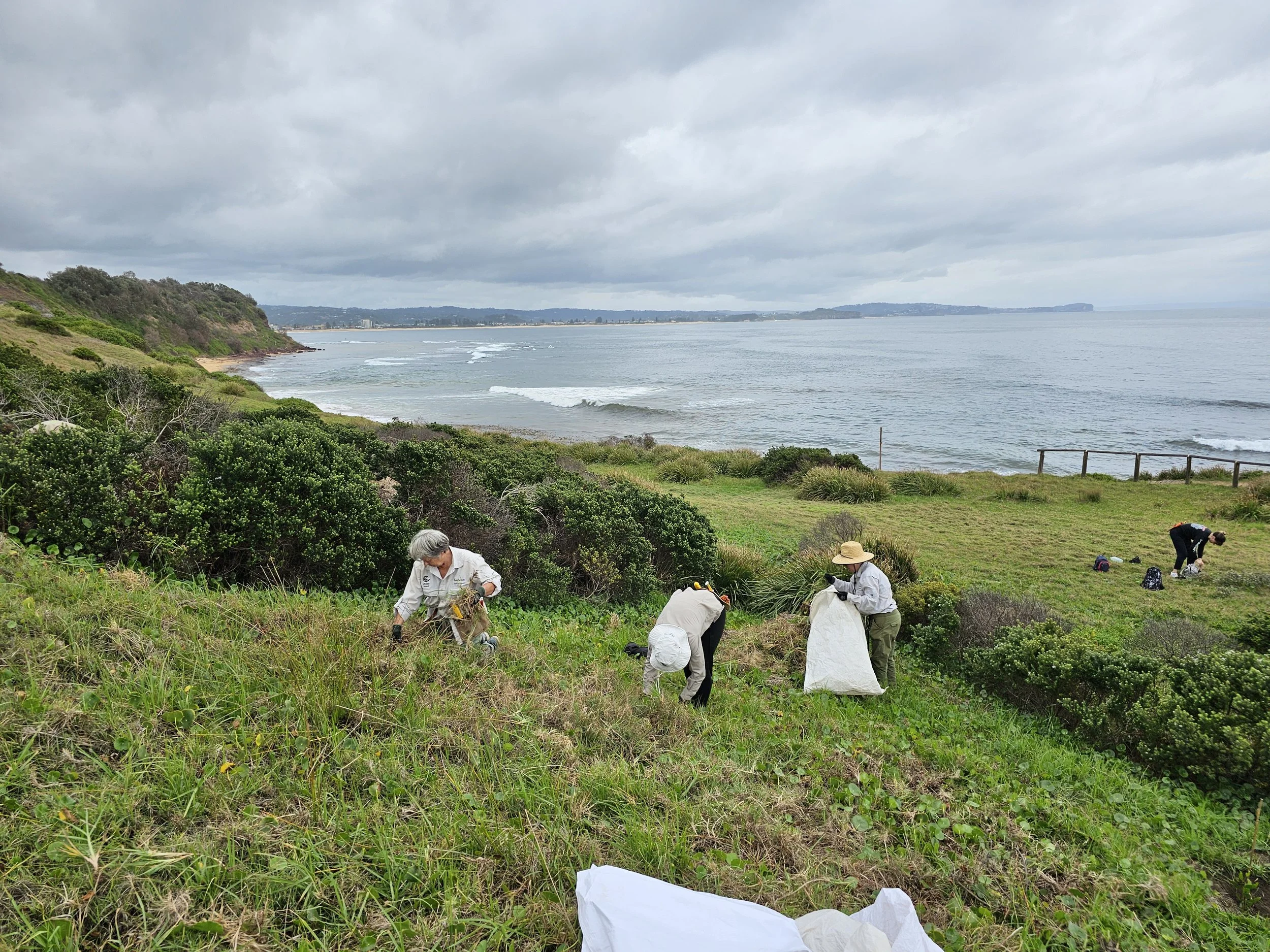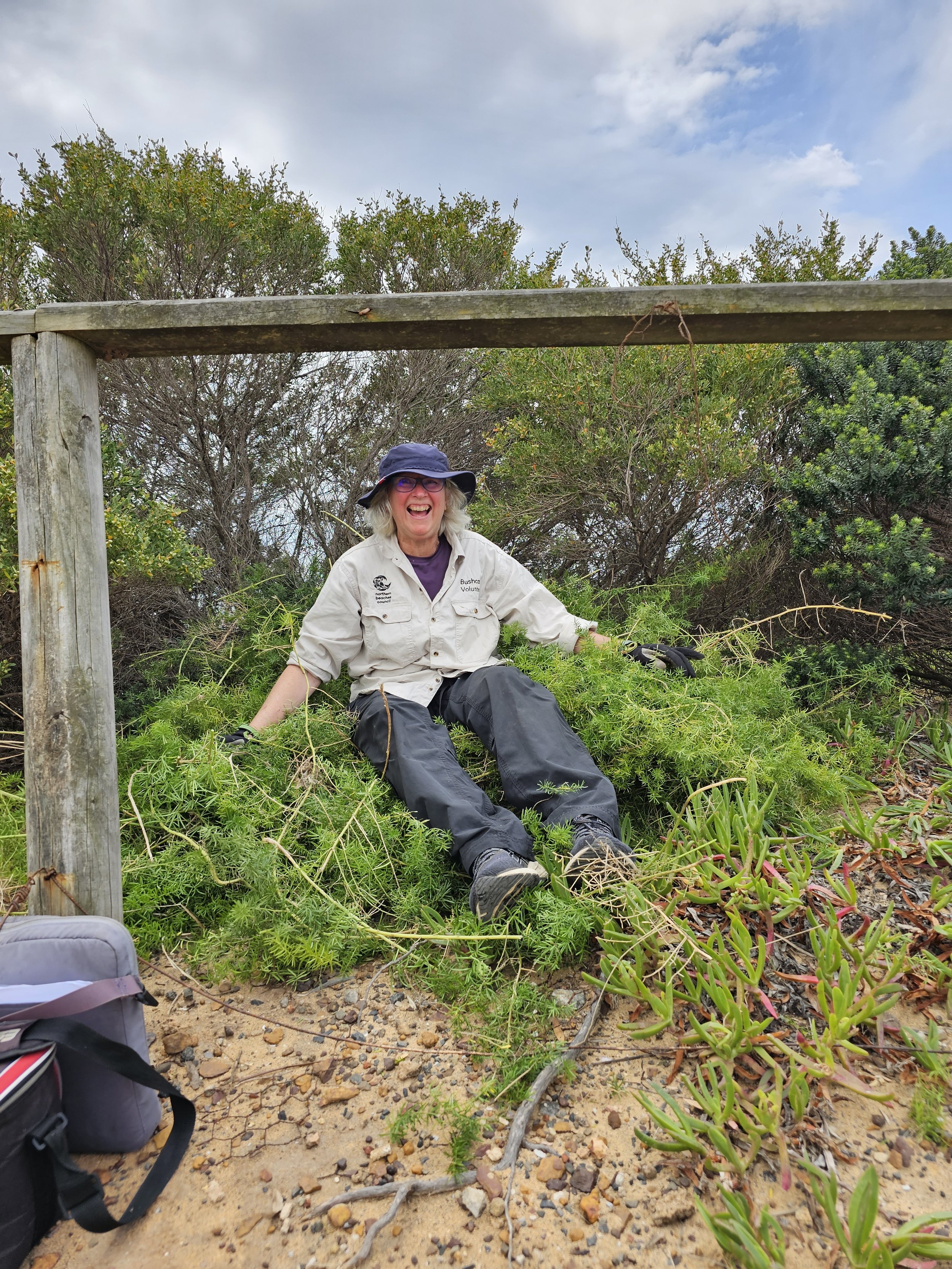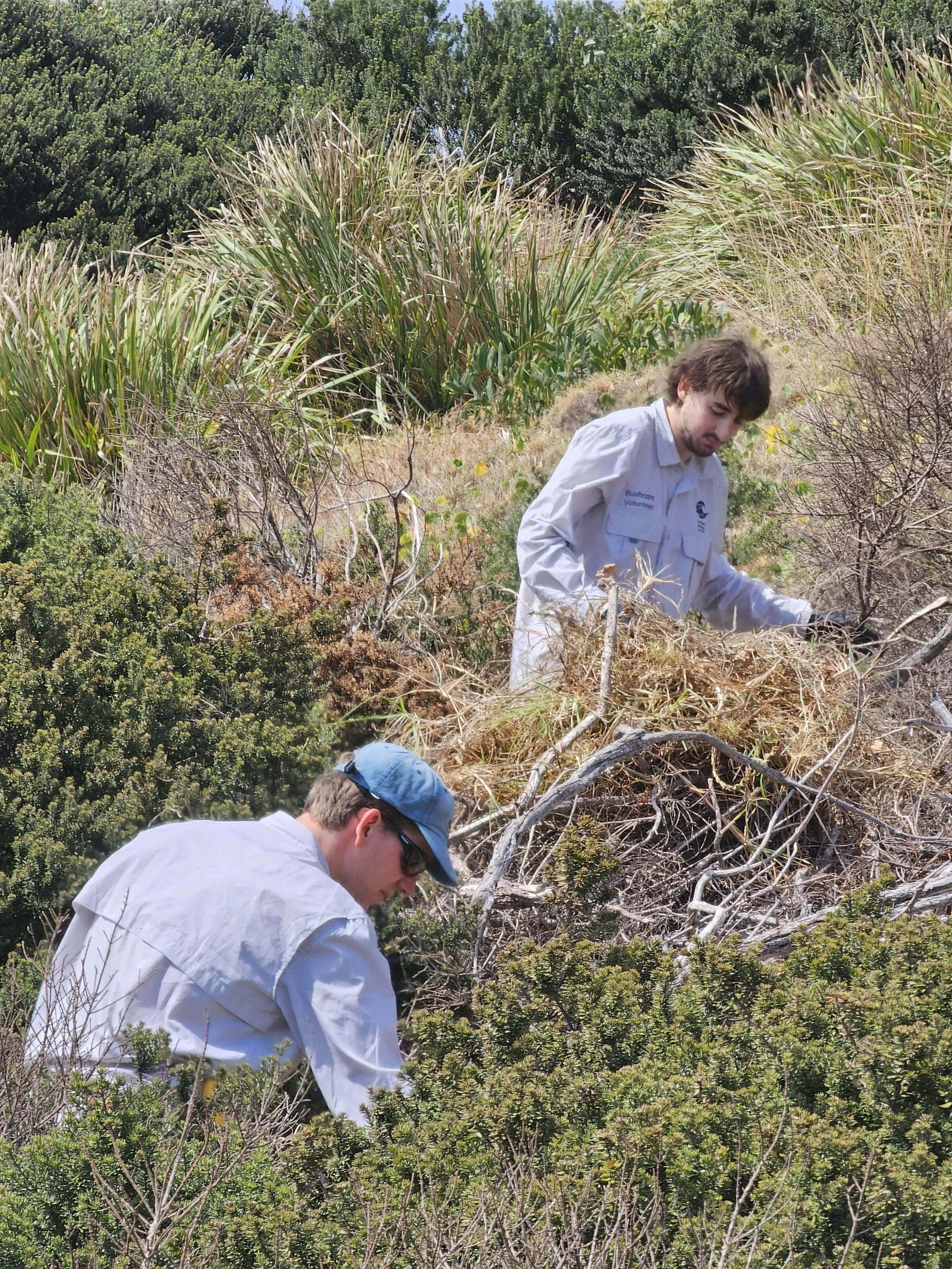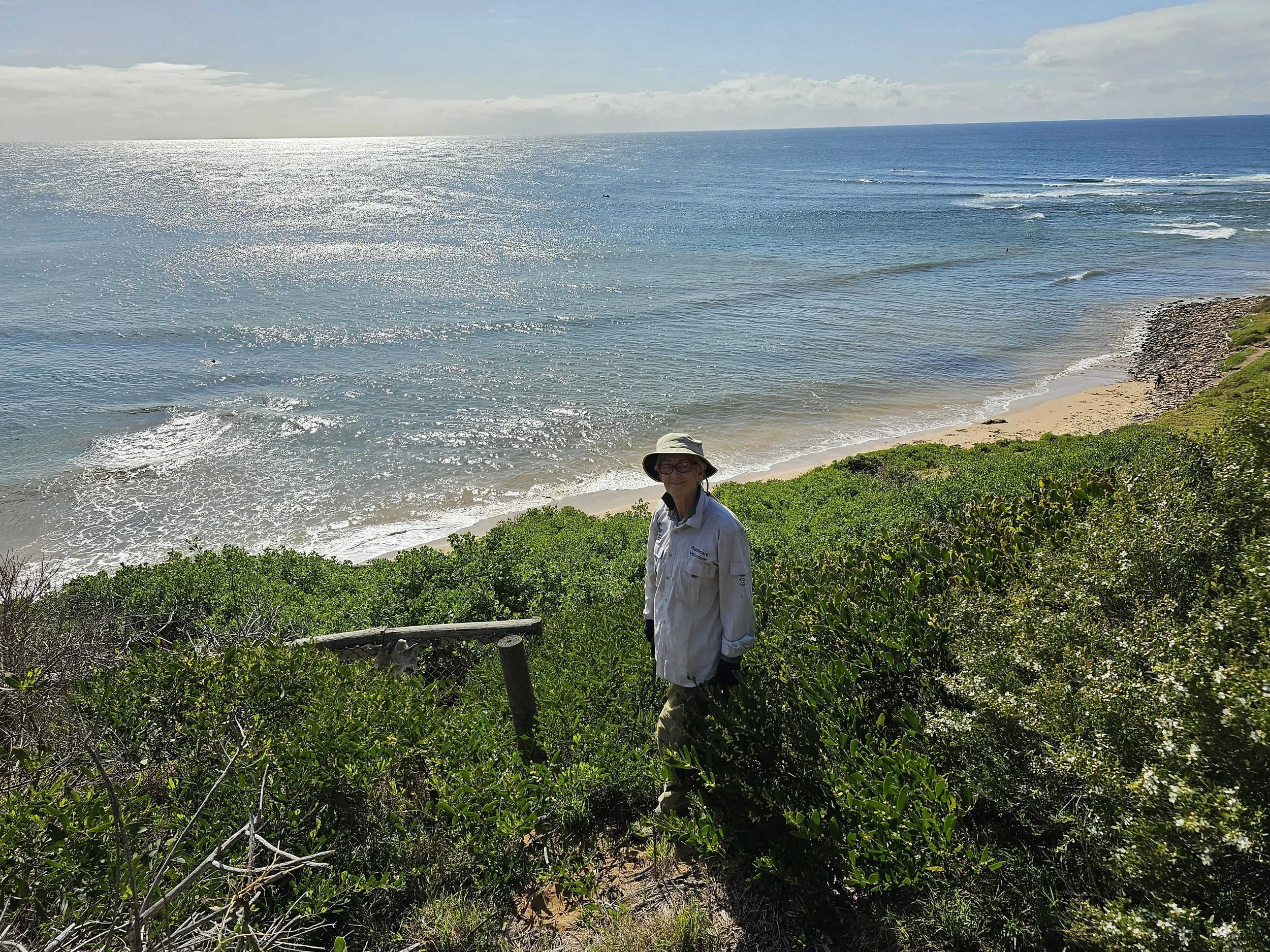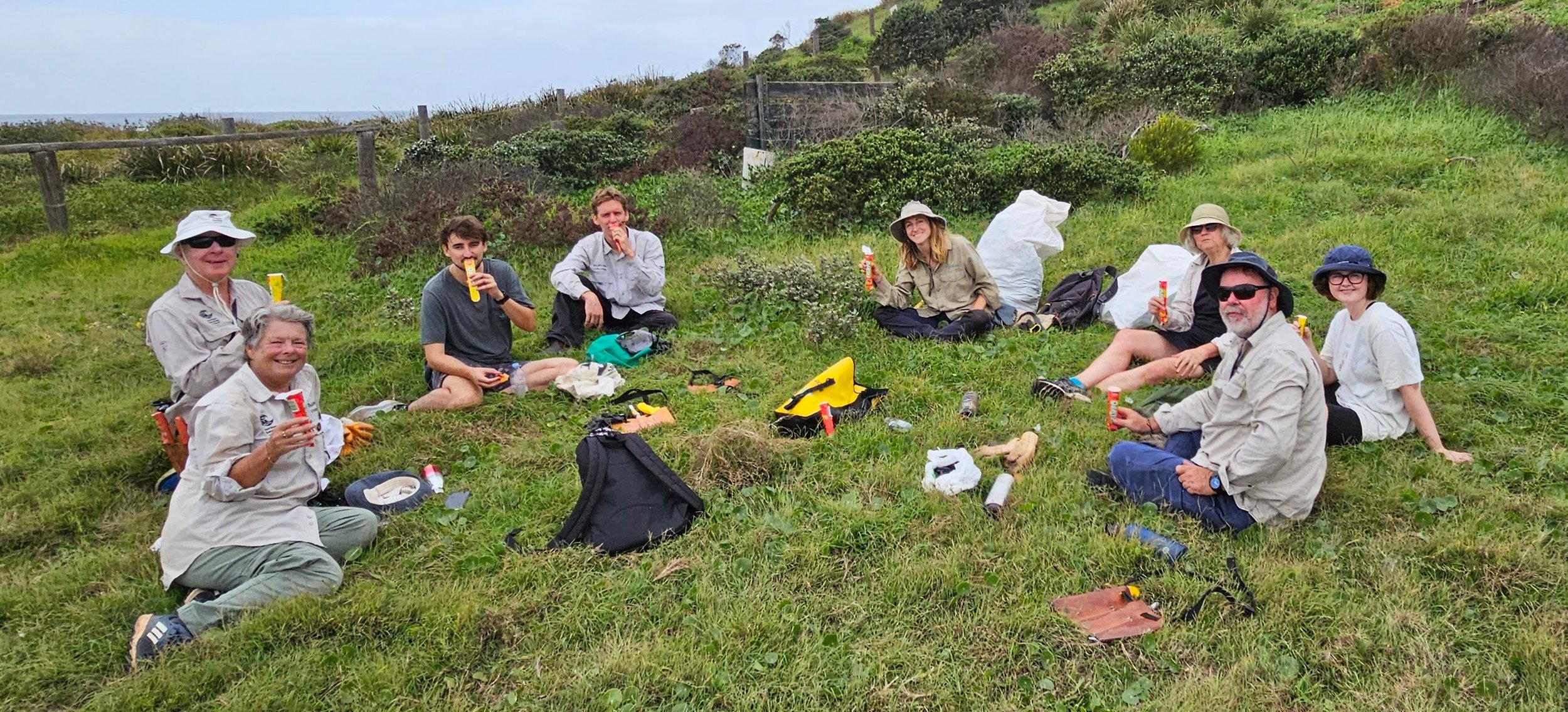
Blog
A big day of planting seedlings
On this morning of sunny blue skies and mild temps we gathered at the carpark, with seven volunteers, trays of plants, bottles of water and belts of tools.
Stefanie and Misima digging water-catchment holes for the new seedlings. Photo by Kathy.
As the weather starts to cool we had big plans for planting today. Lisa had already made preparations by watering the existing seedlings, and the recent rain should have moistened the soil, so the water we add won’t just run off. So on this morning of sunny blue skies and mild temps we gathered at the carpark, with seven volunteers, trays of plants, bottles of water and belts of tools.
Lisa, Kathy, Stefanie, Karina and Misima started the morning with trimming off dead branches from the Westringa fruticosa on the eastern flat, then stomping this to create some mulch to put around our tube stock.
Misima carrying mulch collected from dead Westringias to protect new plantings. Photo by Kathy
Stefanie, Karina and Misima attend the safety briefing by Kathy. What a nice classroom! - Photo by Lisa.
Julie stayed at the top of the site doing all she can to assault and eventually eliminate Asparagus fern. Julie is trying various methods to find the best and quickest way to eliminate it, especially in difficult places, such as under the roots of established plants.
This is Julie’s toilet-brush method of treating asparagus fern enmeshed in a Lomandra. Collect the spears into a brush, tied with one of the spears. Prune back. Then spray with glyphosate.
Only a few Lomandra leaves are cut. No need to get to the crown which would be impossible without a big effort. Photo by Julie.
Alex then arrived on site, took one look at what the girls were doing and said – “I am going to check previous areas for Turkey Rhubarb” – which he did, and then found the site is full of small Asparagus ferns and bitou! Des, Merrilyn and I have another convert to the big issue of Asparagus fern on site!
Alex on the slope weeding bitou seedlings and just stunned with
the amount of small asparagus ferns! Photo by Lisa.
In the mean time Lisa, Kathy, Stefanie, Karina and Misima created small well like structures for the planting of the tube stock on the flat. The wells will collect the rain water and funnel it down into the newly planted tube stock. The exposed earth was then covered with the Westringa fruticosa mulch we created on site, stomping the dead branches down to a suitable size. Bamboo stakes where then driven into the ground, marking the home of each new seedling.
Correa alba just planted in the well, next the soil would be covered with mulch and a bamboo stake put in the ground next to the plant, so that it does not get trampled. Photo by Stefanie.
After morning tea, Alex went back onto weed patrol and the rest of us planted the balance of tube stock – so we got in 40 plants. Given the attention to detail in planting we are hoping for a high success rate in survival.
An overview of some the tube stock planted on the flat. Photo by Stefanie.
Lisa and Karina removing Kikuyu from planting halos. Photo by Kathy.
Text by Lisa.
Book Review: Exploring the Wonders of Coastal Reefs and Rock Pools
Phil Colman and Peter Mitchell’s A Field Guide to the Marine Life of Coastal Reefs and Rock Pools is a must-have for exploring intertidal zones, packed with expert insights, vivid photos, and a touch of humour.
A Field Guide to the Marine Life of Coastal Reefs and Rock Pools by Phil Colman and Peter Mitchell
Phil Coleman
Have you ever wandered along a rock shelf at low tide, marvelling at the vibrant marine life, and wondered how these creatures survive the changing tides? Or spotted a moving shell and thought, what is that? If you’ve ever had these questions, this book is for you.
Phil Colman and Peter Mitchell have revisited and expanded their original 2011 self-published book, Exploring Tidal Waters on Australia’s Temperate Coast, with an exciting new second edition: A Field Guide to the Marine Life of Coastal Reefs and Rock Pools, launched in early 2025. This updated version features even more species, colourful photographs, and a lively, engaging style—sprinkled with humour—to make learning about marine life both accessible and enjoyable.
The original book was inspired by Phil’s 25 years of leading groups through Long Reef Aquatic Reserve, answering countless questions about the intertidal zone. Since then, Phil and Peter have discovered their guide is relevant to temperate intertidal zones worldwide, sparking interest even in South Africa.
Beyond its appeal to nature enthusiasts, Phil hopes this guide will serve as a valuable resource for university students, helping to answer the many mysteries of the marine world and inspire further research into intertidal ecosystems.
The book is now available as of February 2025. Don’t miss the opportunity to dive deeper into the fascinating life of coastal reefs and rock pools!
Reefcare Day Report: A day of planting new seedlings
On a warm but overcast morning, twelve keen volunteers gathered at the carpark, with 50 seedlings to set free into the wilds of Long Reef …
Stephanie and Karina prepare the ground to plant some tube stock
On a warm but overcast morning, twelve keen volunteers gathered at the Long Reef carpark. With fifty seedlings, lots of tools, bottles of water and twelve people, it took some organising to work out how to best target the two planting areas we wanted to tackle.
Once out onto the site, Lisa, Stefanie, Karina, Bec and Elias planted seedlings around the Lomandra longifolia on the northern dune, before joining Brad and Gen on the high western slope. Here, they planted the balance of the tube stock around the gully and the western side of cleared Bitou. The sandy soils here required them to build terraces with old bitou branches. The ground preparations are vital to encourage any rainfall to stay in the tube stock area.
Correa alba, taken out of the tube and ready for planting. We have never seen wombats on our site but they would like these. Photo by Stephanie.
Here is hoping we have some rain in the next three to four days; otherwise, Des and Lisa will be struggling down the slopes with 8+ litres of water each, to help our newly planted seedlings get established in the sandy soil.
While Brad and Gen were planting the stock, they also collected some of the lush and lovely Commelina cyanea, to transplant around the more western part of the site. The extra ground cover should help prevent erosion of the sandy soil, until the newly planted natives get established.
Julie’s focus was the top area below the whale sculpture where the asparagus fern is growing through the thick grass, dianella clumps and acacia/ correa scrub. Where the asparagus fern is enmeshed in and ringing the dianella, she removed seed, pruned it back and then sprayed with blue dyed glyphosate.
Julie sprays glyphosate on the asparagus fern that has encircled the daniella plant. We usually do not like to use glyphosate, but in this case, removing the plants manually would cause major damage to the daniella. Photo be Julie.
Dead asparagus fern. Photo by Julie
This type of work in ongoing. Last month Julie re-sprayed two large crowns of asparagus fern which had regrown thickly. This time, both crowns are dead, but will need to be checked again next month. Clearly, they are resilient !!
Julie is aiming to find the best method of asparagus fern eradication which requires low energy by volunteers, but has high impact on the plant.
Bright green asparagus fern. Photo by Julie.
Julie advises that removal of the seeds by running a gloved hand along the stem means less weight to carry off the site. Making a 'ponytail' bunch of the Asparagus Fern stems means spraying is focussed and not wasted.
Canavalia Rosea mature pod with a few seed pods still in situ. It is great to watch the lifecycle of these plants, from pink flowers, to big green seed pods and now ready to set seed again. Photo by Stefanie.
In addition to planting the seedlings, we still needed to keep the weeds at bay, so Julie, Merrilyn and Des worked on asparagus fern and Bitou around the site. This is a constant source of work as there are hundreds of these sprouting up, especially with the asparagus fern seeds being dropped by birds. Once Alex moved to the high slop area, Mary who has to be careful of her ankle worked on asparagus fern.
Morning tea below the old bundles of pigs face, with a view over the ocean. Photo by Lisa.
Alex and Mary worked on turkey rhubarb removal. Alex found more sites of turkey rhubarb to eradicate, which was very upsetting news as we thought we just had a few sites to monitor. From past experience, we know that any infested area needs to be monitored for months to years as dormant seedlings suddenly burst into life. We suspect that the seeds are being blown in from the infested Long Reef dunes, south of our site.
After the planting was finished many of the group worked on ridding the gully of the non-native pigs face. This weed would otherwise smother our earlier plantings. With Brad, Gen, Lisa, Elias, Stefanie, Karina, Alex, Bec and Denise working together, they managed to clear a good-size area. We will need a follow up next month, but I surmise it won’t take long, and we can move onto the eastern slope of the gully, to join it up with the larger cleared area from last year.
Elias shows how to build terraces on the steep sandy slope, before planting Westringia fruticosa tube stock. Photo by Stephanie.
We bundled the non-native pigs face into piles. These flatten down as they dry out, providing good ground cover on the steep sandy slopes. Photo by Lisa.
In the afternoon, as we left the site and passed the area we worked on last year, we were thrilled to see the plantings had thrived. The space looked vibrant and healthy. We may be able to add more plants here, perhaps a task for next month.
Text by Lisa.
Reefcare Day Report: A big turnout for the start of 2025!
What a fabulous start to 2025 with thirteen Reefcare volunteers turning up! Once again it was exciting to see so much wildlife as we worked …
It is all smiles as Lisa and Stefanie clear Pigs face on the upper slopes near the Gully.
What a fabulous start to 2025 with thirteen Reefcare volunteers turning up! It was a mild, cloudy 20 degree day, so perfect for working on the open terrain. After signing on and allocating equipment, we took some photos of Merrilyn and Des, each with a plant donated by the Northern Beaches Council (NBC) for their attendance – follow the link below for more details and photos.
Once again it was exciting to see so much wildlife as we worked. A nankeen kestrel hovered over us as we weeded, looking for prey, and an osprey soared over the slopes, a small fish in its talons for morning tea. On the ground, Brad found a baby eastern blue tongue (Tiliqua scincoides) and soon after, Des found another one. It felt so rewarding to see that this native animal is breeding on our site, the native vegetation providing good cover from the weather and predators.
we found another maroubra snail and Kristie found a spider, not seen at Long Reef before, which looked like it was from the Salticidae family. As the Long Reef area returns to native vegetation the number of insects and invertebrates is increasing. Lisa recalls seeing almost no insects when she started clearing the invasive bitou bush, twenty-seven years ago!
This jumping spider: Maratus scutulatus (white garland house hopper) was seen hunting in the foliage at Long Reef. Photos and video by Kriste King.
We were having a relaxing morning tea on the upper slopes when Stefanie spotted an Australian fur seal (Arctocephalus pusillus doriferus) near shore. It came up onto the beach where Brad and Kristie saw that it was hurt, so they called the sea life rescue organisation: ORRCA. They arrived at about 1 pm and set up signs to warn people of its presence. They had been monitoring it since yesterday. NPWS set up a 40m exclusion zone so it can rest while recuperating from its injuries. The Northern Beaches Council also posted some photos of it on their Facebook page and website:
Seals occasionally come ashore at Long Reef. This one was injured so we called the sea life rescue organization: ORRCA.
After morning tea, Des spent his time scouring the site for small bitou seedlings, asparagus fern, and other weeds to try and maintain our better areas as best we can. He was backed up by Merrilyn, who focussed on Gladiolus caryophyllaceous, as well as asparagus fern and bitou seedings which proliferate all along the north-facing slope of our site. Julie spent all her time on asparagus fern, as she had done for the last half of 2024. This weed is severely problematic on our site. There are huge plants along the fence line, in the public areas around our site and in the dunes just south of our site. Birds pick up the seeds elsewhere depositing them all over Long Reef.
Alex and Leila continued to work on the turkey rhubarb (Acetosa sagittata) that had infiltrated the acacia, and found dozens of good-sized bulbs. This area has been a focus for the past four working days, and still needs more work. They then checked the nest and another turkey rhubarb source in the Westringina on the flat, before heading back up hill and clearing the rest of the pigs face (Carpobrotus sp) near the fence line.
Elias, Josh, Arthur, Lisa and Stefanie worked on the non-native pigs face and were really thrilled to finally cut through to the gully. In one area where they removed the pigs face they were absolutely delighted to find a large patch of healthy kangaroo grass (Themeda Triandra). They also found a rather freshly eaten large blue tongue. The smell of it encouraged us to work faster and move further west!
Stefanie, Arthur, Josh, Lisa and Elias (our Dragonfly supervisor), clearing pigs face on the upper slopes
Mary is still getting over a twisted ankle and was unable to work on the steep western slope, so she kept to the eastern dunes area, clearing kikuyu on the southern edge of our demarcation. This line was established in our December working day, to protect our beautiful kangaroo grass.
Brad and Gen with some help from Des continued to remove bitou from the western side of our site; as well as Brad and Des cutting a new pathway through the bitou to an area of huge asparagus ferns. It is a steep area involving climbing over roots so hard work for the boys.
It was a great start to 2025 and we are looking forward to our next working day on the 1st of March.
Text by Lisa Calder
Celebrating Our Top Reefcare Volunteers of 2024!
Recognising the dedication of our incredible Reefcare volunteers! 🌱 Meet our top attendees of 2023 and 2024 and see how we’re celebrating their commitment to coastal conservation. Join us and make a difference!
Merrilyn and Des receive their native plants from the Northern Beaches Council.
At Reefcare, we love recognising the dedication and hard work of our volunteers who show up rain or shine to care for our beautiful coastal environment. To celebrate our most committed attendees, we’ve continued our tradition of gifting native plants - a small token of appreciation for their incredible efforts.
Top Reefcare Volunteers of 2023 & 2024
In 2023, Lisa, Merrilyn, and John led the way, attending 9 out of 11 Reefcare Working Days. Their dedication set a high standard for community conservation.
In 2024, Lisa topped the list with 10 attendances, followed by Des (9), Alex (8), and Julie (7). Their consistency and passion for bush regeneration have made a real impact on the local ecosystem.
Des extracts another turkey rhubarb bulb from the earth. These invasive weeds require constant management.
Alex cutting out bitou bush to give the natives underneath access to the sunlight.
Julie is holding her nemesis - asparagus fern, (Asparagus virgatus).
A Special Thank You
To honor their contributions, Merrilyn received a Canevalia Rosea, and Des was gifted a native shrub - both from Northern Beaches Council’s Curl Curl Nursery, which propagates native plants for local bush regeneration projects. Alex will receive his plant in April, a well-earned token of appreciation.
A huge congratulations to our top attendees and to all our volunteers who dedicate their time to Reefcare. Every hour spent restoring and protecting our local bushland makes a difference!
🌱 Interested in joining us? Come along to a Reefcare Working Day and be part of our passionate conservation community!
Reefcare Day Report: A cool rainy morning won’t stop the fun!
At some point a competition started as to who can pull up the longest Kikuyu runner…..
It was a grey, overcast morning as we arrived on site, to be greeted by a rain shower. We all donned our coats, which never came off as the rain showers kept coming in all morning, one after the other. So much for the forecast of 32C and sun/cloud. We had low/mid 20’s and rain on and off the whole time. Still, it was great to be out in nature with our cozy little group.
However, some were less impressed with the weather than others …
Working on the eastern dunes. Photo by Kathy Shields.
In the photo above, Arthur is facing away from the camera. He was working on getting rid of the kikuyu from an area of Lomandra and tea tree (Leptospermum laevigatum). Along the line of white weed bags you can see the start of the new demarcation line going east to west to stop the kikuyu heading up the slope into a beautiful area of native Themeda. On the right, Alex and Des talk logistics – this is the area where Alex was removing the non native pigs face.
As there was no wind we worked in the south eastern area of the site for a change. Brad and his brother Peter who was out from Colorado, USA eliminated a large Bitou bush and then cleaned up this area of the non-native pigs face, before heading to the northern part of this site to get rid of another couple of bitou – and then helped rid central area of this site of the non-native pig’s face.
Des and Arthur worked on the north/south demarcation line which is there to stop the non-native pigs face going over the bump into the kikuyu and the stopping the kikuyu of getting any further into our beautiful eastern dune area. They cleared kikuyu westward and Arthur did an amazing job getting this rotten grass out of a lovely clump of native plants of Lomandras and a tea tree. Merrilyn worked on one of her two most hated weeds, Gladiolus caryophyllaceous hybrid – (the other is asparagus fern) – she even brought along a sieve to capture the small bulbs at the bottom of the plant from a trowel full of sand. Now that is serious dedication and determination!
Using a sieve is an effective way to capture the small bulbs. Details like this make a huge impact in preventing the return of these weeds.
Merrilyn on the eastern dunes.
Alex and Leila worked on the Turkey Rhubarb which is well into the Westringia and hard to get to, but with a saw (this one is dying so no problem sawing it up!), they were able to get in and were really surprised how many bulbs they were able to find in that area. They also checked the nest, then joined the rest of the team over the other side of the track where Alex removed the non-native pigs face on the southern side, whilst Leila, Lisa (after working on the new demarcation line), Brad and Peter removed non-native pigs face from the central area of the eastern dunes.
Kathy, Ivana and Lisa created a new demarcation line going east to west along the southern slope of the eastern dune area. This line is to stop the kikuyu from the flat area of the eastern dunes moving into our beautiful Themeda grassland, which it is just starting to do. Aim is to continue to work above the line to make sure we get all the kikuyu out of there… and one day hopefully, we can attack the kikuyu in the flat.
At some point a competition started as to who can pull up the longest Kikuyu runner. You be the judge, but it looks like there is no end to the “lengths” we will go to in order to have fun and win :)
We didn’t stop for morning tea as no point just sitting in the rain, so we worked through until 11:15 and then left the site sopping wet. Kathy, Des, Lisa, Alex and Leila met up for a coffee where we chatted about Reefcare and life generally. Alex and Leila also leant about the old days when one could steam an envelope open – their jaws just dropped, so funny.
Text by Lisa, photos by Kathy and Lisa
Reefcare Day Report: New members join us on a cool morning
This morning’s focus was mature Asparagus Fern which is deeply entangled with natives and thick grass. No fruit but lots of flowering evident.
One of the magpies checking out Leila, or seeing if she has any food of interest – photo by Mary Clarkson
Whilst the day was overcast, it was good to work in cooler weather.
As we walked up to the top of the headland, we checked the hang glider site, which has remedial works done on it after last winter’s rain. There are now Bitou Bush clumps growing in the hessian matting. The plants are showing Bitou tip moth which eats out the shoots and stunts growth for a while.
This morning’s focus was mature Asparagus Fern which is deeply entangled with natives and thick grass. No fruit but lots of flowering evident. The effort to dig out 4 crowns and expose a large crown. Given the drizzly weather, I’ll treat the large crown with glyphosate next time. (I’ll send this as Photo 2)
The Asparagus is growing inside the large Dianella clump and is impossible to dig out- so will paint glyphosate on its stems next time.
Aspargus in clump of Dianella - challenging to remove.
We have the same problem with Asparagus in the Correa alba clump – see photo below. This will probably require glyphosate as well, otherwise there is no way to remove the weed without damaging the native plant.
Aspargus in a correa alba
Julie checked the Asparagus clump which was treated a month ago. Most of the crown is dead but a section has regrown slightly stunted leaves.
Aspargus reshooting after poison last month.
Julies haul of aspargus rhyzomes
We hope this is not a rabbit hole!
We had morning tea with a beautiful view over the ocean. It was nice to chat to our new members.
Morning tea on the western slope.
As per usual the magpies came to visit and check to see if we had any snacks for them.
Inquisitive magpie
After morning tea we continue working in the quiet drizzle, with Lisa working on the Oat grass and Merrilyn working on the ever-growing Bitou.
It was a nice morning overall and everyone seemed to enjoy themselves. We had a good turn up, and everyone stayed despite the on and off drizzle all morning. Below are some more photos of the morning’s activity.
Reefcare Day Report: Helping nature by the sea on a long weekend
We were stoked with how much we got done with just the two of us.
Des admiring the first flower on one of the Melaleuca armillaris seedlings, planted in the last couple of years ~ the Bracelet Honey Myrtle.
This weekend was a long weekend in Sydney with Labour Day on Monday 7 October, so most of our crew took the advantage of the extra day to go away – that left our Supervisor Kathy with the retirees who would never think to venture out of Sydney on a long weekend!
Julie spent her time in her usual area just west of the gully concentrating on the removal of asparagus fern.
The two photos above show some of Julie’s work included cutting back asparagus stems to 20cm and then painting with glyphosate. The photo on the left is just after painting. The photo on the right shows the effect, one month later.
Des spent the first part of the morning working on an area of Burr medic he found on the western slope, as well as the oat grass which is now coming up all over our site (source was the public track) and starting to seed, as well as his nemesis – the asparagus fern. Des also did some work on the bitou working east to west throwing cuttings in any exposed areas to try and get some mulch happening on any exposed sand area, and then he went back to target more asparagus fern along the western slope; which literally has 100’s of these little ones popping up all the time, probably due to the amount of huge advanced asparagus fern plants which surround our site. It was not that long ago Des and I spent 3 hours each just on those small asparagus ferns on the western slope and barely made a dint – Merrilyn complains about how many there are every month!
Des removing burr-medic with an ocean view
Lisa and Kathy worked in the western gully with our main focus being on removing the non-native pig’s face which was starting to smother our earlier plantings which are doing so well in this area – in doing so, we also removed quite a lot of oat grass and ehrharta erecta which fortunately a lot were not yet in seed so did not need to be bagged; and of course – a few small asparagus ferns.
Kathy working on Pigs face removal in the gully. It was hot work, but there was a welcome cooling breeze further down the gully.
The photos taken in the gully in this month’s report show the progress that Kathy and Lisa made down the gully of the non-native pigs face. We were stoked with how much we got done with just the two of us.
This is the start of the clearing of the pigs face in the gully today – we started up the end; so all that bare ground was the non-native pigs face and you can see the pile up for this small area.
Clearing non-native pigs face in the eastern section of the gully.
Julie was not able to meet up for coffee afterward, but Des, Kath and Lisa gathered at a local coffee shop to discuss todays work and then talk went into dancing venues and bands around the Northern Beaches.
The photo above shows a friendly magpie that forages for worms where we have disturbed the ground.
Bracelet Honey Myrtle: https://en.wikipedia.org/wiki/Melaleuca_armillaris
Reefcare Day Report: New volunteers meet magpies on a bright sunny day
It was a very warm day with just a slight breeze – a change from the seriously windy weather we have been experiencing when we met up before 9:00am with two new volunteers; Mary and Layla, so we had a 8 volunteers plus our great supervisor Kathy from Dragonfly Environmental – a great turn out.
The magpie family forage for worms after we remove the non-native pigs face - Des Mullen
It was a very warm day with just a slight breeze – a change from the seriously windy weather we have been experiencing when we met up before 9:00am with two new volunteers; Mary and Leila, so we had a 8 volunteers plus our great supervisor Kathy from Dragonfly Environmental – a great turn out.
Julie and Merrilyn worked in two areas around the fence line of Reefcare’s area and the Council area continuing to remove Asparagus fern, just below the top paddock – which is just below the whale sculpture. Gen worked on the top southern slope which had a lot of numerous types of thistles, bromus and erharta, whilst Lisa worked just below on bromus – it was a great time to get this weed, as it is just coming up and most had not yet formed seed heads – some had a few about to come out and only one (a huge one!), had lots which were about 2/3rds the way in maturity. Des scouted the high southern slope for asparagus and bitou bush and felt overwhelmed; as if anything on this site that needs to be done, isn’t overwhelming – we need an army!
Spiders like this huntsman are commonly found in the vegetation that supports a rich variety of food items for them. - Kathy Shields
Mary worked on the Turkey Rhubarb in the Acacia bushes – a continuing effort which Alex spent on one Saturday then Brad, Gen the next month and the following month, Lisa. It is a bad infestation and will take several more months of work, such as we had to do on The Flat (which took 2 years to clear) and in what we call The Nest area. After morning tea Mary had had enough of doing the Turkey Rhubarb and then worked on removal of the pigs face as the group continue to move slowly westward with it’s removal – with Lisa joining her after finishing with the Bromus.
The two photos above are before-and-after shots of the removal of the non-native pigs-face from around native Themeda, Westringia, Correas, Acacias and beautiful Leucopogon parviflorus (or coastal bearded heath), which is in flower right now - Kathy Shields
Josh, Alex and Leila worked non-stop on the non-native pig’s face, continuing to clear westward - they rolled a big section of pigs face and then our resident magpies came in looking for worms – smart birds for sure. They hung around us for some time singing, I am sure they know our group now and feel safe – and they love Alex who finds worms for them. The birds come within a metre of you and sing – oh to learn magpie language. After afternoon tea, Josh, Alex and Leila moved to a patch of non native pigs face near the fence line and did an amazing job of clearing.
It was so hot several of us stopped about 10am for a rest and water, and after this Kathy undertook the Council required introduction to our 2 new volunteers. Alex and Leila had been down to The Nest and got a few Turkey Rhubarb bulbs – which proves it will need follow up for a few months yet before we can plant out this area. The group had a later morning tea about 11 with all of us. Alex had Anzac biscuits and mandarins for the group. While we sat chatting we were watching for the whale spout near a white and red boat, which was a bit of fun. “Ohh, there it is”, a cry would call out. Always exciting to see.
Happy morning tea group - Kathy Shields
After 11am Kathy and I organised the 15 plants I had brought along as to where they were to be planted - each has a bamboo pole so we can ensure they are watered next week by Des and I, and then when Reefcare meet again next month.
Hope to see you here next time!
Reefcare Day Report: Tackling the Turkey Rhubarb
After a past week of rain, wind and cold weather we had a beautiful sunny Saturday upon which our aim was to target more of the non-native pigs face
After a past week of rain, wind and cold weather we had a beautiful sunny Saturday upon which our aim was to target more of the non-native pigs face in which we made a huge difference last month. Unfortunately, we were thwarted constantly on this goal, with finding more sites of Turkey Rhubarb which was all seeding; thus this became our number one priority.
Lisa and Denise planted 10 Westringa on the flat where many of these plants have died having reached their life span – it took 2 hours, as we kept finding more Turkey Rhubarb and there was a lot of Kikuyu which needed to be removed. We met the others on the top of the slope for morning tea and then Lisa removed the rest of the non-native pigs face in the area she didn’t quite finish last month and then the rest of the time working on the Turkey Rhubarb in the Acacia bushes – a continuing effort which Alex, Brad and Gen have already spent a lot of time; it’s a bad infestation.
Alex worked on Turkey Rhubarb on the flat before moving up the slope and removing more where he worked last month and then went on to help removing non-native pigs face and then asparagus fern with Julie and Merrilyn.
Julie, Merrilyn and Kathy spent their whole time on removing Asparagus fern, together with Brad and Gen, much of it we think is out of our area of responsibility, but as the Council/Contractrors are not doing anything about the Asparagus fern in their area, and it is causing issues in our area, we have to spend time doing this for future benefit to reduce occurrences of Asparagus fern on our site, as the Asparagus fern in their area are huge and full of berries.
Maria arrived at morning tea and then she and Denise worked on removing more of the non-native pigs face on the western slope.
Reefcare Day Report: Bushcare wildlife encounters
When the five of us arrived on site at the western slope with 20 plants and a goal to remove more of the non-native pigs face we were serenaded by a delightful singing juvenile magpie who seemed to enjoy having us all around her …
When our team of five arrived at the western slope armed with 20 plants and a mission to clear out more non-native pigs face, we were greeted by the melodious song of a juvenile magpie. Several other juveniles joined in, a heartening sight given the declining numbers of magpies along the east coast.
Magpies, known for their intelligence and complex social behaviors, often delight with their vocal prowess, echoing through the bushland as we began our conservation efforts.
Des and Alex immediately began tackling a patch of Bidens Pilosa, followed by the discovery of Turkey Rhubarb further east—recent invaders from the dunes behind Long Reef.
Meanwhile, Denise captured a colorful hairy caterpillar on camera, noting its vibrant hues and recognising it as a species known for its camouflage ability against local flora.
Lisa uncovered a puffball fungus previously unseen by others. She squeezed it gently, causing dust-like spores to spurt out—a fascinating sight captured on film by Denise, adding to our documentation of local biodiversity.
Julie focused on removing Asparagus Fern atop the slope, hoping to coordinate efforts with NBC's contractor to combat this persistent weed.
As we worked westward, pulling up non-native pigs face, Alex made a significant find: a large amount of Turkey Rhubarb entwined with Acacia roots, a species known for its rapid spread and ecological impact in coastal areas.
Lisa and Alex collaborated to collect seeds and bulbs before rain interrupted briefly at 10 am. Undeterred, we pressed on, uncovering unexpected grass beneath the pigs face, potentially native couch. Further back, Kikuyu grass posed a future challenge, noted for follow-up with Jock from NBC.
Morning tea on the slope provided a scenic break, although whale sightings were absent.
However, we were visited by a charming native rat with light grey fur, a species likely native to the area and indicative of the healthy biodiversity our conservation efforts support.
Kathy's subsequent discovery of signs suggesting native marsupials in the vicinity added to the excitement, highlighting the potential habitat richness of Long Reef.
Later, Lisa's find of live snails sparked intrigue, prompting detailed photos for identification, a step towards better understanding the diverse ecosystem thriving amidst our restoration efforts.
At day's end, Alex delighted a juvenile magpie with a worm, revealing their clever and curious nature.
Despite Kathy's encounter with a tick, treated promptly with Lyclear, the day concluded on a high note with remarkable wildlife encounters. Reflecting on our efforts, the transformation of this site—once dominated by invasive Bitou Bush—now supports thriving wildlife, a testament to Reefcare's impact.
Denise's ongoing work to update Reefcare's website promises to showcase our discoveries at Long Reef, underscoring the importance of our conservation efforts.
Reefcare Day Report: Weeding in the rain
Five of us met at the carpark in very inclement weather together with our Dragonfly Supervisor for the day …
Five of us met at the carpark in very inclement weather together with our Dragonfly Supervisor for the day, Paul; plus 25 plants to get in the ground before the rain really came in – which we expected around 11:00am.
Julie continued up the top removing more Asparagus Fern whilst Des and Brad headed to the high western slope where previous non-native pigs face has been removed to plant 18 of the plants to add to previous plantings over the last few months. They then moved to the western area of the site cutting bitou and throwing onto previous cleared ground so that it can break down and be used for future mulch on site and cover exposed sand to keep moisture in and prevent any possible erosion.
Bitou bush that was poisoned in last month's bushcare session is dying, but the native plants (Myoporum) are thriving! Great outcome!
Alex with mattock and weed bag in hand, headed back to the nest area as unfortunately more turkey rhubarb has appeared within a number of black berry nightshade (Solanum nigrum) with green berries which have appeared on mass in this area as well as Hydrocotyl (Hydrocotyle ranunculoides) - which is also growing all around the site like it’s been fed steroids. Paul worked on the turkey rhubarb on the flat and other general site weeding, whilst Lisa headed to the eastern dunes to plant Lomandra along the tracks where the surfers are cutting through the Reefcare site of good Themeda, and general weeding – Burr Medic coming up but not yet burrs appearing – early for this weed, as it is usually around August.
Return to the nest: some minor turkey rhubarb plants were observed in the nest, some of which were seeding. These were promptly removed and bagged.
Turkey Rhubarb bagged and disposed of.
The rain started lightly sometime after 10:00am, but we put on rain jackets and kept working until 10:30 when it started to get heavier and looked like it was set in – so after meeting Maria in the carpark – great timing Maria! Des, Julie, Lisa and Maria when to a coffee shop and sat around a heater they had to dry out – whilst Paul our Dragonfly Supervisor decided to complete the Green Link walk around Long Reef, as he had not been in this area before – good on you Paul, hope you got back in time before it poured down about 11:15am!
Drowned rats Lisa & Alex working in the rain just before the session was canned.
We leave the site in peace as the rain comes in.
Reefcare Day Report: A rainy weekend - too wet for Reefcare
Some days it is just too rainy and wet to work safely on the Reefcare site, but we can aways admire the view …
Reefcare was cancelled for this month because of the heavy rain over the past few days, which was forecast to continue through the Saturday morning. We had planned on removing more non-native pigs-face, flea-bane and asparagus fern. We also had 8 Acacia Longifolia plants, ready to go into the ground, but these will have to wait until next month.
Text and photos (unless otherwise attributed) by John Isles
Reefcare Day Report: Planting Natives
On a warm, windless morning, the Long Reef Bushcare group gathered in the carpark. Despite the quiet seaside, our dedicated team was ready to reap the rewards of months of weeding by planting native species.
It was a warm muggy morning, without a breath of wind as the Long Reef Bushcare group assembled in the carpark. Unlike last month where the huge surf attracted lots of people, the hot, humid air and flat sea seems to have kept everyone at home. Except of course our dedicated bushcare team. But today was an exciting and important morning, for we were going to reap the rewards of all the weeding we have been doing over the past few months and plant some natives!
Gathering tools, plants and people in the Long Reef car park
We gathered our tools and seedlings, allocated bottles of water and discussed our plan – start at the top and work down the slope, building terraces in which to place the seedlings, to help catch and retain water. In the exposed environment of salt and wind, the little seedlings will need all the help they can get.
Splitting the plants into groups, based on where they will be planted.
All hands on deck as we plant the top slope
It was all hands on deck as the enthusiastic group started planting the top slope. We first cut terraces in the sandy soil to help retain water, reinforcing the downslope side with sticks and bamboo stakes, before planting the seedling and providing plenty of water. Planting here is such a beautiful experience, with the ocean views and the sea breeze, with a murder of ravens on the wing overhead. Ivana did one of the first plantings, exhorting: “Live long and grow well!” to the little seedling before moving onto the next one, all the while being careful not to step on anything delicate.
With our first batch of plants firmly in the ground, we proceeded down the slope towards the gully, where Des and Clare prepared the ground for our new green residents.
Des and Clare remove any remnant weeds and prepare the ground for our seedlings.
The top of the gully area is looking really healthy, flush with the pink flowers and the lush green of the beach beans (Canavalia rosea). These were producing some huge beans now, some of the biggest we have ever seen.
The Canavalia rosea (beach beans) look magnificent.
We had a variety of plants for this area, to suit the varied terrain of steep slopes and flat sandy sections. Our trusty lomandras were first to go in, along with dianellas, which look quite similar to the uninitiated, and Kathy and Lisa showed us the subtle differences.
Lomandra on the left, with flat or v-shaped tips, and Dianella on the right, with pointed tips and a flat base.
At morning tea, we enjoyed the view and the fruit that Kathy had brought for us, along with Calippo ice-blocks to keep us cool.
After a nice rest and chat, we continued with our ongoing control of the non-native pigs face on the slope next to the gully, while Des worked on the weeds around the Correa alba shrubs higher on the slope. Alex got stuck into removing the pigs face, using a serrated saw to good effect to cut trenches across the slope. We used two techniques to deal with the cut pigs face, some of it being rolled into big tubes across the slope to control erosion, while some of it was thrown onto the uncut pigs face higher up the slope to reduce sun exposure and further challenge its growth.
Spider amongst the pigs face
Many species live in the vegetation on Long Reef, including animals that would not be expected in this often dry environment. This spider was thriving in the moisture laden vegetation that lies deep down near the soil.
As we continued to weed, the wind picked up and a short rainstorm passed overhead, the cool rain refreshing our little group and also providing some much needed water to our newly planted seedlings.
Alex cuts out non-native pigs face in sections, most pleased with his new serrated saw.
John gathers large sections of pigs face into long rolls.
Des and Ivana remove pigs face along the fence. It is such a strong grower, it needs regular monitoring.
Meanwhile, Julie worked high on the slope above our heads, continuing with the process of keeping the asparagus ferns at bay, she collected a big bag full of tubers and berries by the end of the morning.
Asparagus fern berries are bagged and removed from the site.
Asparagus fern berries are bagged and removed from the site.
As the clock struck 12, everyone was so engrossed in work and invigorated by the cooler weather that we continued a little bit longer, before packing tools and heading back up the slope.
It was satisfying to see the empty seedling pots and we were well pleased about the amount of work we had achieved that morning.
Empty seedling pots at the end of the morning.
Thanks to Julie, Lisa, Des, Kathy, Clare, Alex, John, Ivana for another lovely Reefcare morning..
Text and photos (unless otherwise attributed) by John Isles
Reefcare Day Report: Removing Invasives
It was a joy to watch the big waves roll in as we did our mornings Reefcare
It was a warm overcast morning as the Reefcare group eagerly met for the first session of 2024. Today was forecast to be hot and humid, so we were well pleased to be greeted by a sea breeze and clouds to keep us cool. Also present was a huge ocean swell, which brought in surfers and onlookers, adding a vibe of energy and excitement to the morning.
Huge waves brought in the surfers and many onlookers.
Many bird spotters were also arriving, drawn by the presence of siberian sandpipers, ruddy turnstones and red-necked stints on the exposed foreshore. It seemed like Long Reef was the place to be this Saturday morning.
We were keen to start work before it got hotter, and keen to see how the site looked after the Christmas break.
As we walked down the track past the resident fairy-wrens, we spotted a blue-tongue lizard, basking in the open, seemingly unperturbed by all the birders, surfers, visitors, and bushcarers! We gently removed some asparagus fern nearby, without disturbing her morning sunbath.
A sleepy bluetongue basked in the sun as we removed weeds nearby.
Many small birds benefit from the bush regeneration work carried out at Long Reef.
The Canavalia rosea (beach beans) are doing very well and flowering beautifully.
Des, Brad, Merrilyn and Gen stayed on the high slopes as usual, tackling the asparagus fern and any new growth of Bitou, while Julie stayed on the fence line, removing the asparagus fern that was encroaching from higher ground. She also noticed that the asparagus ferns were dropping very small red berries, unlike the larger mature ones that are normally seen, and she did her best to collect these as well. Meanwhile, further down the slope, Lisa got to work on the fleabane, asthma-weed, and bidens before moving onto asparagus fern on the slope.
Julie tackles the asparagus fern, under the watchful eye of a paraglider pilot!
John and Alex were charged with inspecting the “nest” (an area surrounded by a ring of coastal rosemary). Armed with mattocks, they went to check on the turkey rhubarb infestation, which we had worked so hard to eradicate. The good news was that there were only two small rhubarb plants, which were easy to remove. Hoorah! The bad news was that the area had been taken over by blackberry nightshade, which was full of berries! Boo! So Lisa, John and Alex carefully removed these with an easy pull to the base of the plant and bagged the whole lot, trying to avoid dropping any berries. The rest of the area was looking good with Kennedia covering most of the nest.
Further down towards the sea are some very exposed and visible native Lomandras, that are infested with the noxious weed: turkey rhubarb. Previous attempts to remove it without damaging the Lomandras had failed. After wide consultation by Lisa, it was decided that glyphosate would be the best option, so our expert Kathy performed the scrape-and-paint operation, and also kindly showed other group members the technique.
Fill a bag full of weeds and you have a nice backrest for morning tea! Photo by Lisa Calder.
The cooling breeze continued and by morning tea we took a well-earned break to catch up with what everyone had been doing over Christmas and New Year. We chatted about native bees, while enjoying Calippo ice-blocks which John kindly brought along and had kept in a bag of crushed ice under the Westringia. Paragliders sailed overhead, making the most of the onshore breeze, as did the usual ospreys, and even a pelican decided to do a bit of slope-soaring, gliding gracefully over us as we relaxed. Meanwhile, Brad examined a snail shell that Lisa had found near the track. It is a good chance that it is another specimen of the rare Maroubra woodland snail.
Morning tea of Calippo ice-blocks helped keep us cool.
After morning tea, we continued working, as welcome swallows flitted around, picking up insects on the wing, and more paragliders arced overhead as the onshore breeze picked up. Kathy and Lisa removed non-native pigs face from the eastern dune and the top of the Southern hill, while Alex and Josh worked on the Western side of the site.
Thank you, Lisa, Des, Julie, Kathy, Brad, Merrilyn, Gen, Josh, Alex, and John – It was a productive and lovely morning.
Text and photos (unless otherwise attributed) by John Isles
Reefcare Day Report: Bushcare Work and Bushcare Party
A nice morning of Reefcare following by the Bushcare Christmas party, made for fun day!
Meetup in the car park
Merrilyn, Brad and Des all went back to last month’s task of removing some huge clumps of Asparagus fern along the fence line of the upper northern western slope, whilst John and Lawson (our Supervisor for this month) worked in The Nest removing remnant Turkey Rhubarb and moving onto removing Kikuyu so that we can plant in this area next autumn. Lisa, Denise, Claire and Ivana worked on removing Kikuyu between The Nest and where the contractors have cleared the site on the main slope and undertaken some considerable planting. Reefcare believe it would be great to clear the area in between of these two patches of Kikuyu and get a good weed free area from which we can then expand up and down the slope. Underneath the Kikuyu is some really good Themeda and amazingly a huge amount of Glycine, plus sometimes some Canavalia Rosea – this is an area seriously worth working on to save the existing native vegetation; the Glycine is doing to well.
Clearing the Kikuyu infestation on the lower slopes.
At morning tea we enjoyed the mince tarts which Claire had kindly brought along – a lovely early Christmas celebration. We also discussed the recent meeting, Lisa, Julie, John and Kim had with Northern Beaches Council people, Michael Kneipp, Victoria Adair and Pamela Bateman about what is strategy with the remaining Bitou now that Reefcare are getting close to a very steep area, prone to erosion which has a lot of Bitou and would be just too dangerous to remove (on several fronts).
Possibly a rare Maroubra woodland snail.
The current situation is that Reefcare will have to stop moving westward sometime next year with Bitou removal. With what to do next is under discussion between Reefcare and NBC, with the current thought to make sure that the tip moth is always prevalent to prevent the existing Bitou from seeding. After morning tea, Merrilyn, Des and Lawson worked on Asparagus fern, Lisa and Ivana worked on the eastern dunes making sure the demarcation line between the front dune and back was being maintained – which is to stop the kikuyu getting to the fore dunes and the non-native pigs face getting to the back dune. The area which was removed last month on the eastern dune of the non-native pigs face is well covered with the remanent dead non-native pigs face and a native creeper. And it was here that Ivana found the Mattock which was lost last month!
Black-faced cuckoo shrikes greeetd us in the carpark as we gathered our tools.
Claire, Denise and Maria continued to work on the Kikuyu between The Nest and the planting undertaken by Council’s contractor – Toolajooa
Denise, Lisa and John enjoyed the Bushcare Christmas party. Thank you Northern Beaches Council!
Text by Lisa Calder.
Reefcare Day Report: The Queen of Asparagus Fern
Happy faces and we make huge castles of aspargus fern …
We had a fabulous turn up of 14 people on a lovely warm sunny day. Merrilyn, Gen and Julie targeted Asparagus Fern along the top fence line (below the whale sculpture) – to an area we call the top paddock – they did this all day with Alex and Josh joining them after morning tea. Prior to morning tea, Alex and Josh worked on the Turkey Rhubarb in the nest area – this clearing is going really well, as well as removal of Buffalo and Kikuyu grass in that area. Plan is the plant this area out, as well as the flat in Autumn next year when it is cooler and we are likely to have rain.
Lisa and the team discuss replanting on the site.
There was no Turkey Rhubarb on the flat, so Lisa, Stella, Annie and Claire weeded Bromus and BurrMedic along the track before moving across to the eastern dunes and removed the non-native pigs face until morning tea. Des and Ivana roamed the site for weeds, getting lots of small Asparagus Fern whilst
Josh and Alex work on the turkey Rhubarb in the “nest”.
John concentrated on Burr Medic and other weeds on the flat. Morning tea was a special one being Ivana’s birthday who kindly brought along a lovely collection of little cakes in which we indulged after a wonderful rendition of ‘Happy Birthday’, Kathy brought beautiful bread with two different tips, Stella brought blue berries and someone else chocolate coated pretzels and popcorn. It was a veritable picnic, sitting in beautiful sunshine. Kathy then read out the Site Work Plan for the next year to which we all agreed, a number of us signing, and she will submit this to Northern Beaches Council.
Morning tea, discussing bushcare strategy for the site
After morning tea, those not on Asparagus Fern weeded the western side of the slope, removed some of the non-native pigs face in a couple of different locations, John on general weeding and Des cutting back Bitou along the northern dunes which was encroaching on the Themeda grassland.
The area is important for ospreys.
Resident male fairy wren.
Resident male fairy wren
Reefcare Day Report: We Found a Maroubra Woodland Snail
We find evidence of the very rare Maroubra Woodland Snail on site …
Morning tea in a beautiful location. Photo by Lisa Calder.
It was a small but committed team of 6 Reefcare members and our Supervisor Kathy who headed down to our site at Long Reef Point with great weather and a cool but rather strong breeze on the headland. As usual, we got distracted by many weeds beside the path down to our site, (not our responsibility, but a concern as these weeds end up on our site as our problem).
Brad continued removing Bitou heading westward whilst Merrilyn and Des scouted the site for never-ending emergence of weeds. This season burr medic and bromus are prevalent, but they were also finding a lot of Asparagus fern which they believe is coming from further up the slope out of our area of responsibility. These have been there many years and just getting larger and larger and left to seed. To this problem, Julie as this month, like last, focused on coring Asparagus on the top areas along the fence (the line between Council responsibility and Reefcare responsibility) – and focused on Asparagus Fern again digging into clumps of Lomandra and dense grass. Coring out the Asparagus crowns in the open areas is straightforward unless they are a wide spreading crown. The photo shows the hassle when the Asparagus is growing through or close to the chain mesh fence. Cutting under the crown gets caught in the wire- so it is thought that a sharp mattock for better leverage would be better.
Removing asparagus fern rhizomes when it is enmeshed in a wire fence is challenging! Photo by Julie Whitfield.
Kathy and Lisa worked on the flat area on Turkey Rhubarb whilst Kristie worked in the area we call ‘The Nest’.
At morning tea the group discussed the Work Plan for the next 12 months which needs to be submitted to NB Council. After morning tea, Lisa walked around the site with Kathie our Supervisor to complete information for the Work Plan, then Kathie worked in the NW area with Brad, whist Lisa and Kristie focused on Burr Medic in the eastern dune area.
This is a Maroubra woodland snail. The first living specimen seen on the North side of Sydney Harbour. It was found at Long Reef and is currently living the good life at Brad’s place.
Reefcare Day Report: A Windy, Weedy Saturday
A windy, weedy Saturday, with great views over the ocean…
Julie in her natural environment: surrounded by wattle, the sea and bitou!
t was a beautiful sunny day with a charm of magpies singing their morning songs, as the bushcare group assembled at the top of Long Reef car park. After signing in, allocating tools, and discussing a work plan, we made our way down the track, passing a pair of tiny red-wattlebird chicks called out plaintively for breakfast from a Tea Tree.
As we descended the track, Brad and Merrilyn peeled off to stay on the high slopes, watering new plantings and tackling the small Bitou seedlings that kept popping up on the exposed areas. Julie also worked a patch high on the western side of the Gully, checking the young banskia plants
and giving them some much-needed water. She also found quite a few Bitou seedlings growing amongst the Tea Trees. These seem to be seeding from the mature plants further downhill towards the ocean, helped by the regular sea breezes.
Merrilyn at work with the loppers on the upper slopes
There was plenty of asparagus fern around, so Brad, Merrilyn and Julie worked to remove these,
especially as they were producing berries. Meanwhile, at the bottom of the slope on the flat area, Claire and Denise worked on the Burr Medic,
eventually collecting a huge bag full. They seemed to be enjoying themselves, taking great satisfaction in removing large plants, roots and all!
Alex and Josh worked on the Turkey Rhubarb in the nest, yielding yet *more* large bulbs. They report that the areas yielding the bulbs are quite localised now, and we hope to be able to replant the nest soon.
We had a nice relaxing morning tea, sitting on the lush flat grass, enjoying the view, snacking on Anzac Biscuits and Digestives, as Ospreys wheeled overhead. Kathy had some good suggestions on how we can promote better and faster revegetation of the areas that we have been weeding, which was really useful. Long Reef was particularly quiet of people this morning, as a surf-ski event meant that the carpark was full early, and that limited the number of visitors to the headland.
After morning tea, John tackled the Turkey Rhubarb plant on the south-eastern side of the fence, near the flat area where people pile rubbish that they have collected from the beach. This rhubarb plant was spotted by Kathy last month and will require further follow-up work. There was quite a lot of burr medic around, so Claire, Denise and Kathy continued on removing these, including the seeding plants along the track. This should help prevent further spread from the regular foot traffic.
Denise, Kathy and Claire try to shelter from the wind as they clear the track of burr medic.
Late into the morning, the wind had suddenly picked up from the south, keeping it quite cool in the exposed conditions that are so typical of this environment. At midday we headed back up the slope and back to the car park, now feeling quite warm, but satisfied and happy with a morning of good bushcare and good company.
Text and photos by John Isles
Reefcare Day Report: Spiders at Long Reef
Turkey Rhubarb was the main focus of today’s bushcare …
Morning tea with the group and some shared delicious treats. Photo by Lisa.
Lisa removes Turkey Rhubarb tubers from the flat area.
In the morning Julie returned to her usual place on the north slope over the fence and found Des there clearing the non-native pigs face from around the plantings. He was also working on removal of asparagus fern.
Julie had 5 litres of water (mixed with soil conditioner) so she watered all the newish and older plants on the slope advising that most were surviving and stable.
Julie cut/scrapped/painted herbicide on another 3 bitou clumps.
Spider with egg sack. Photo by Denise.
Up on the western slope was Brad, Merrilyn, Gen and Stella weeding -mainly Burr Medic and asparagus fern, later in the afternoon they did some Bitou removal. Lisa, Claire, John, Denise, and Kathy worked on the Turkey Rhubarb on the flat – it really is diminishing in this area, so hopefully we can plant it out in a few months – we live in hope!
John and Lisa did some work in the area that we call ‘the nest’ of Turkey Rhubarb removal, but there is still quite a bit still to be done on the eastern part of this patch. At morning tea John told us about some of his volunteer work with Sydney Wildlife Rescue whilst we ate the delicious Anzac biscuits he brought along, as well as some divine bread and hummus which Kathy also brought along for the group – both were a great hit with the
group.
Tackling weeds on the flat area.
After morning tea Lisa, Claire, John, Denise, and Kathy worked the middle western area of the site targeting Burr Medic and then removing two small patches of non-native pigs face which was growing over some lovely Themeda.

